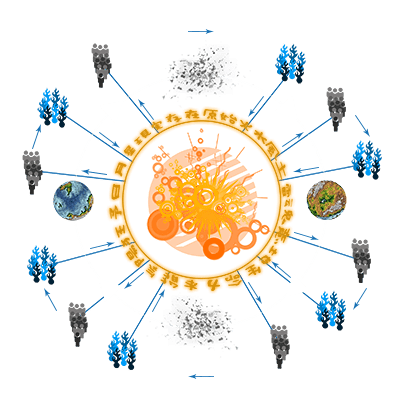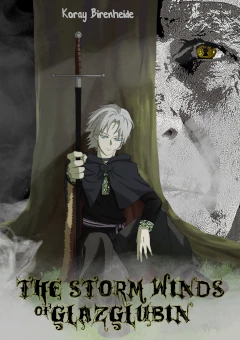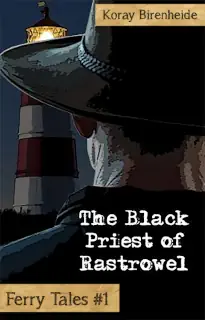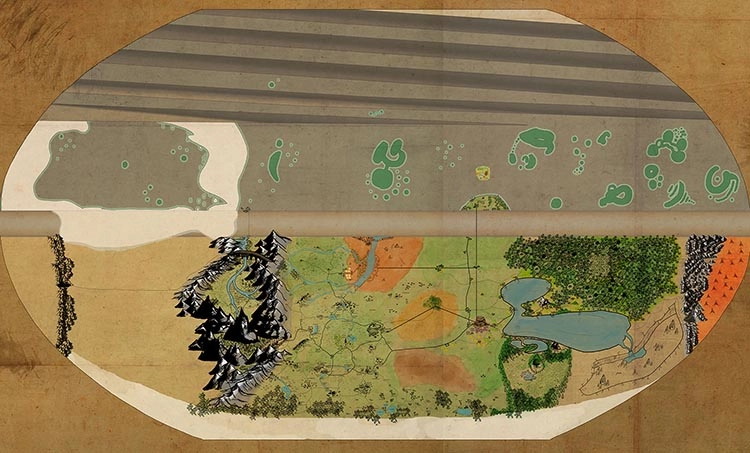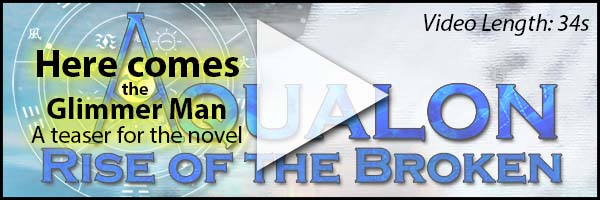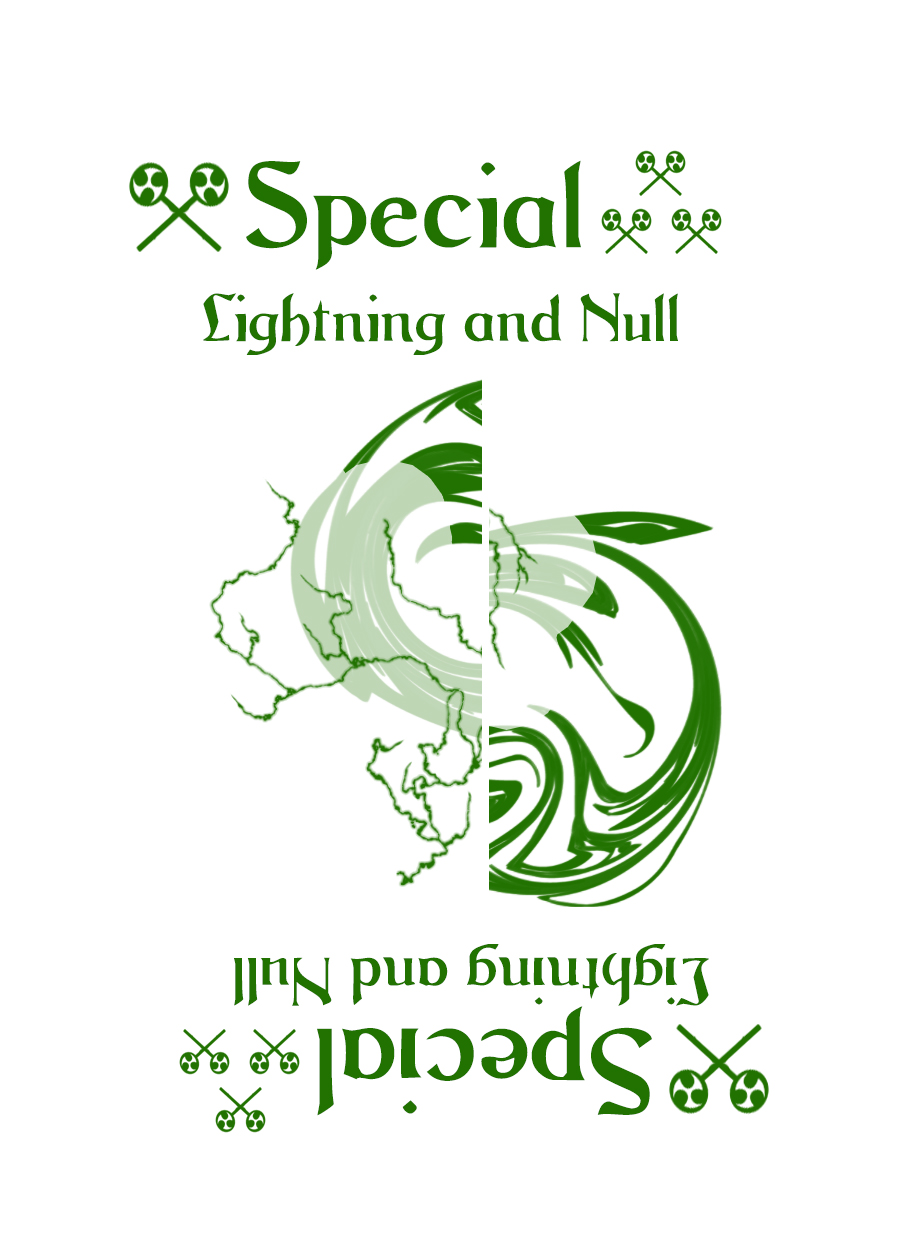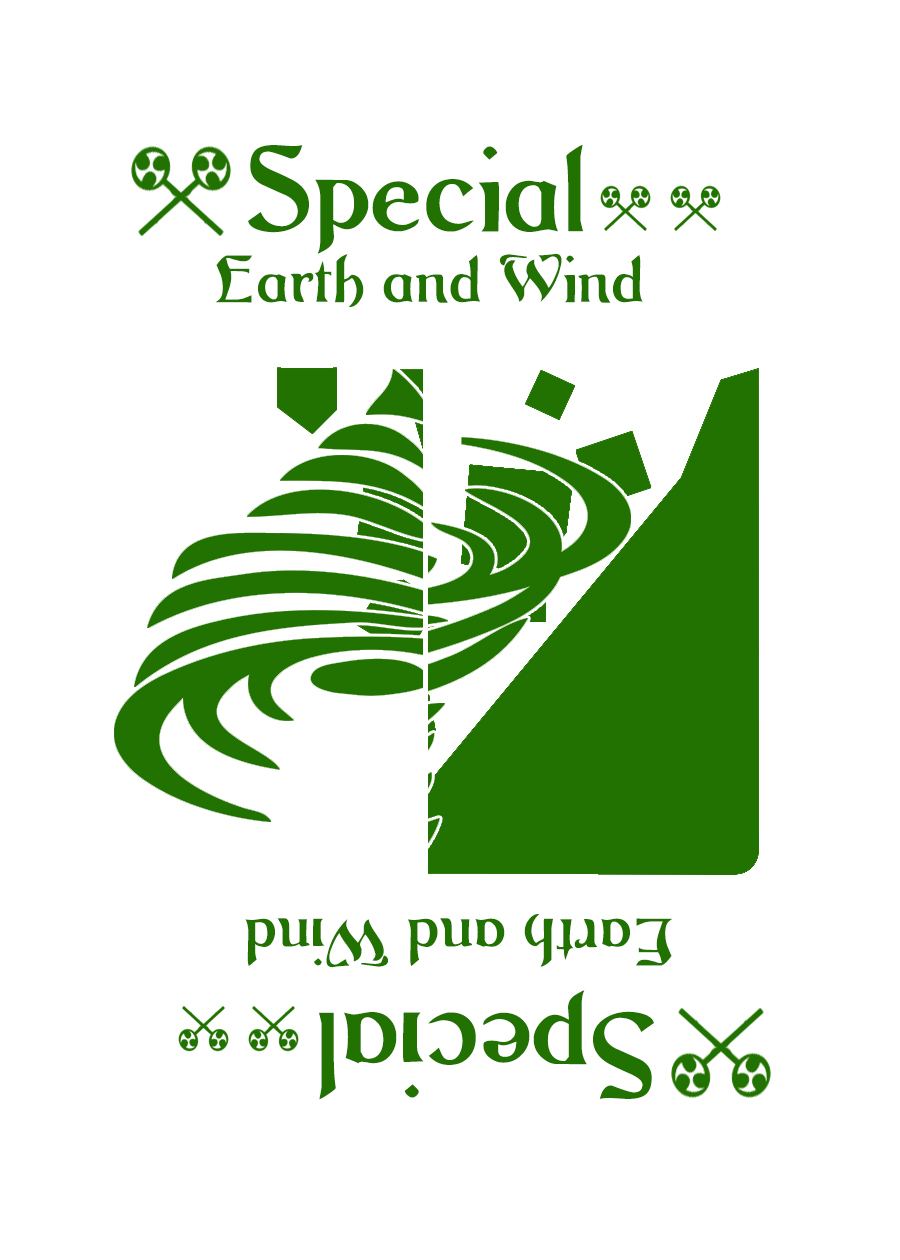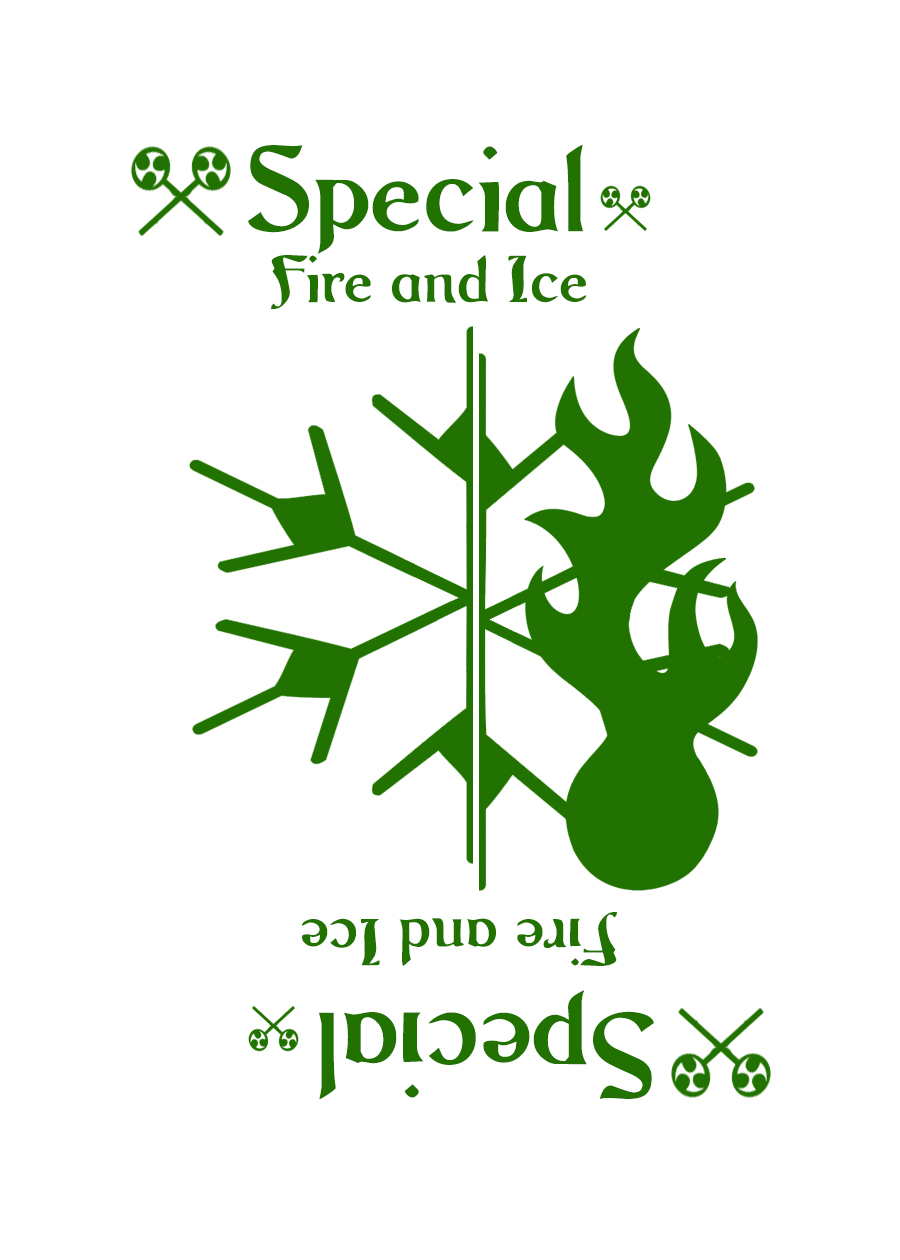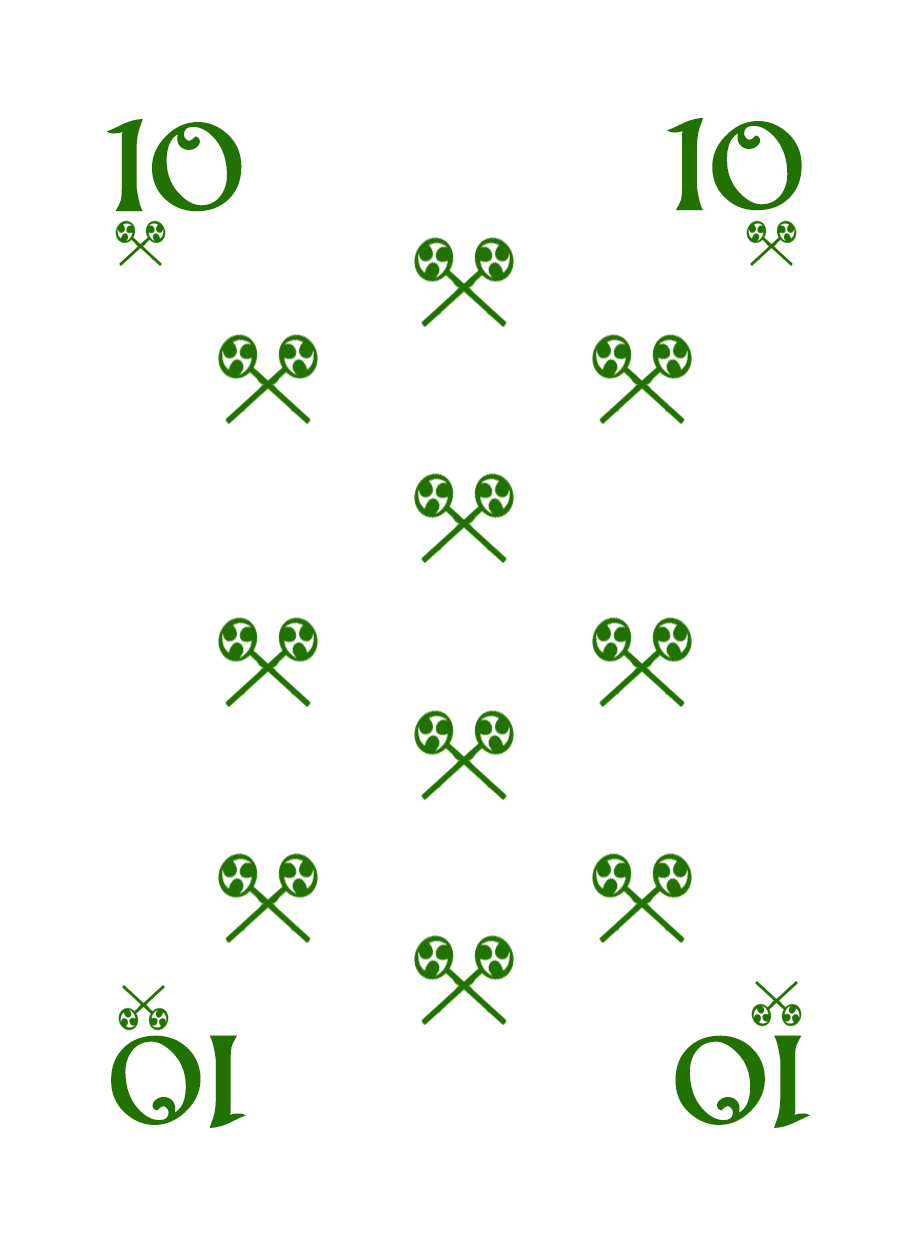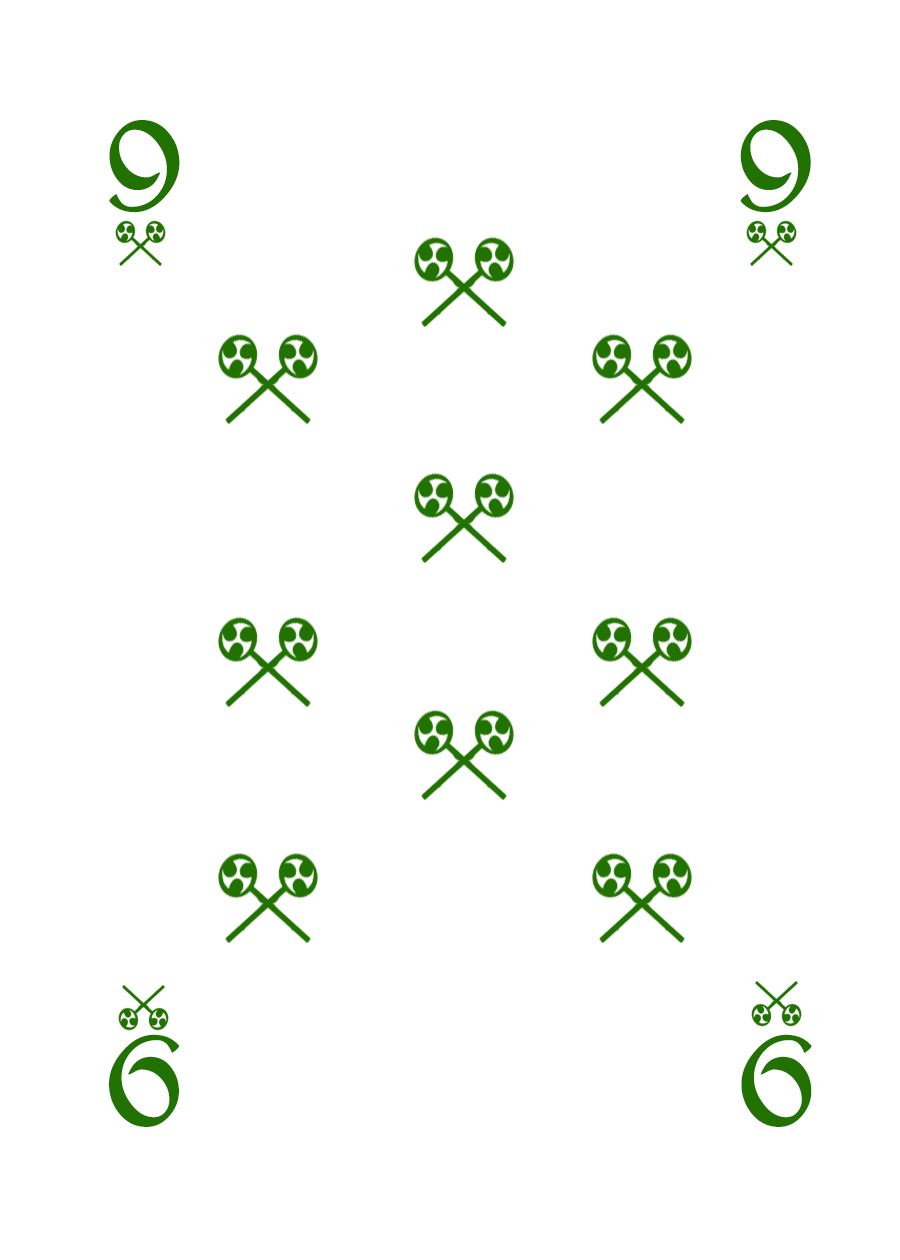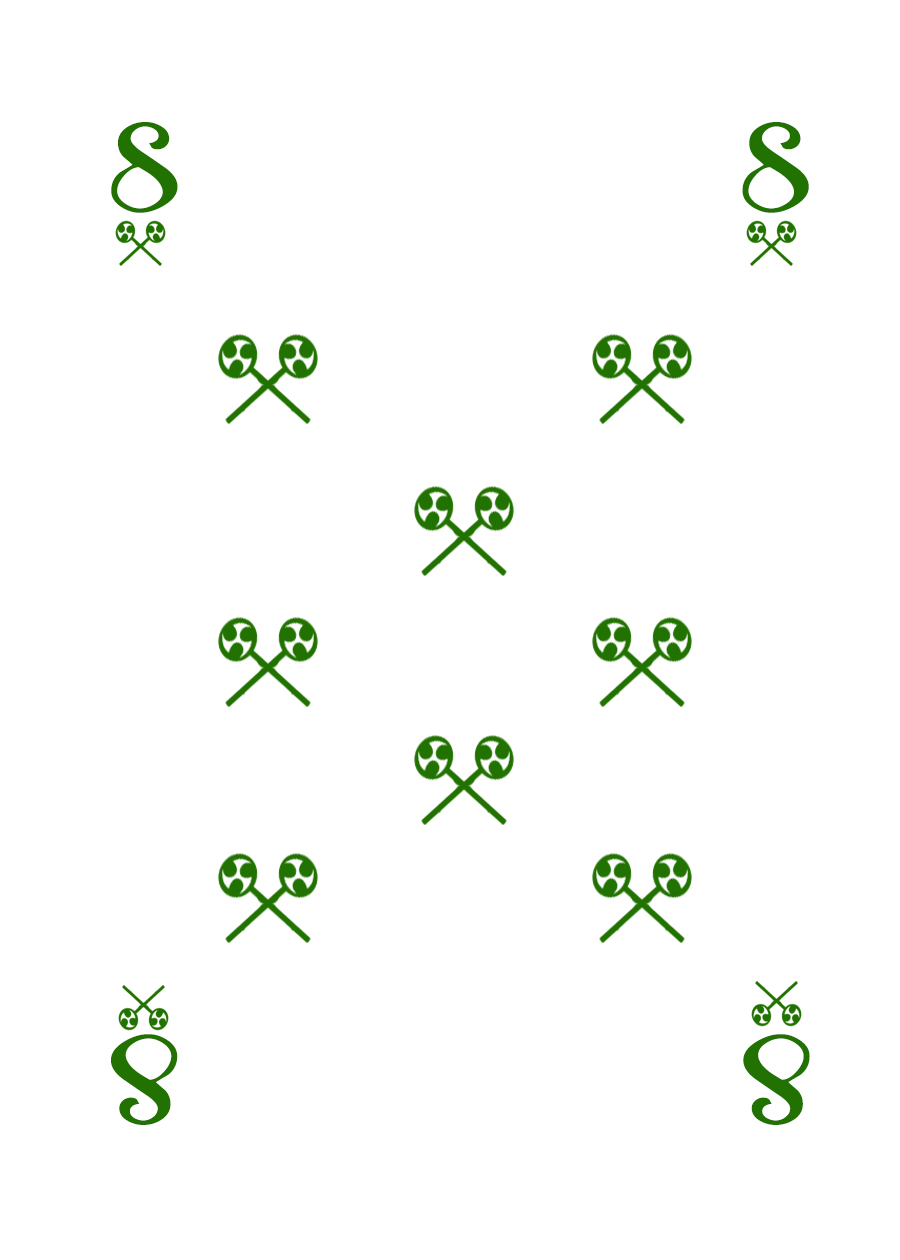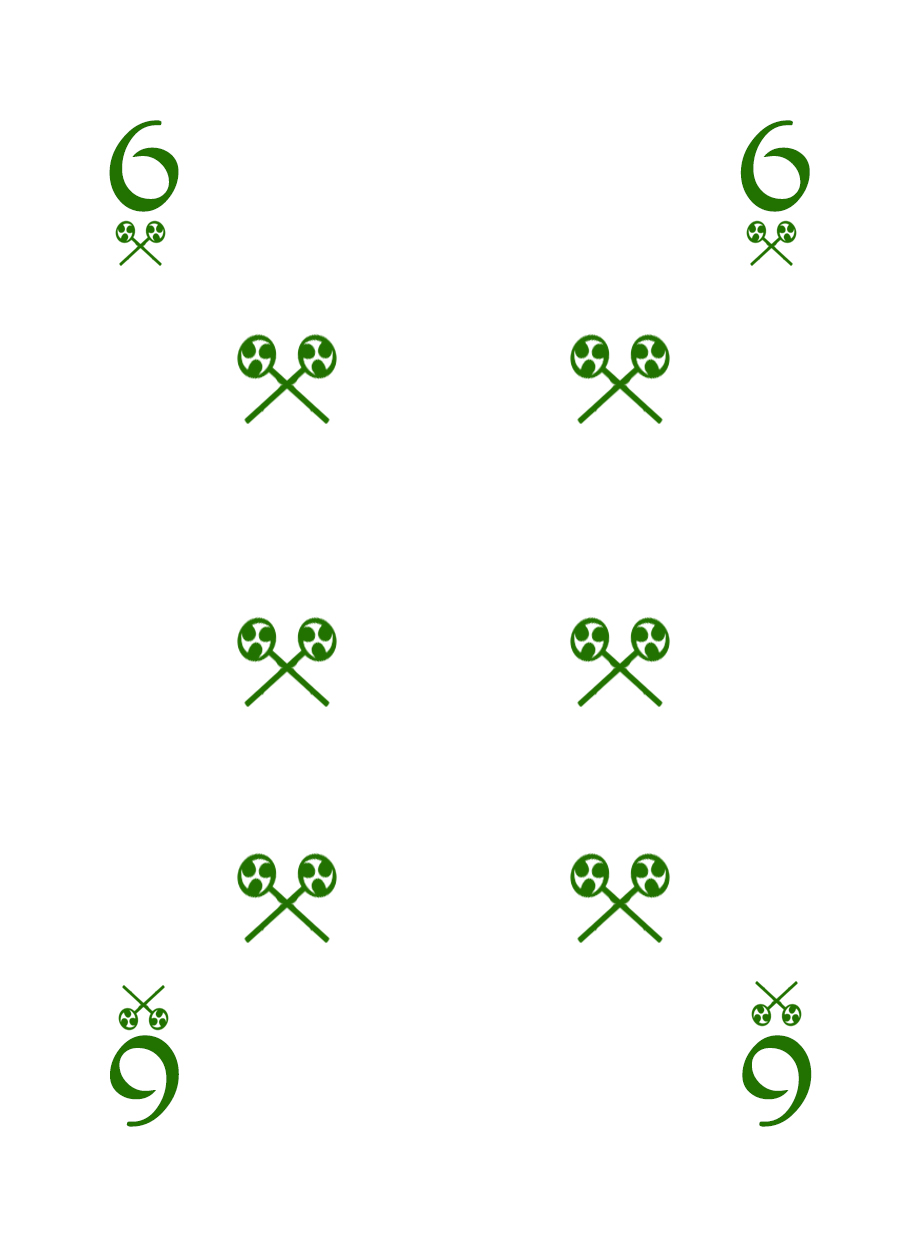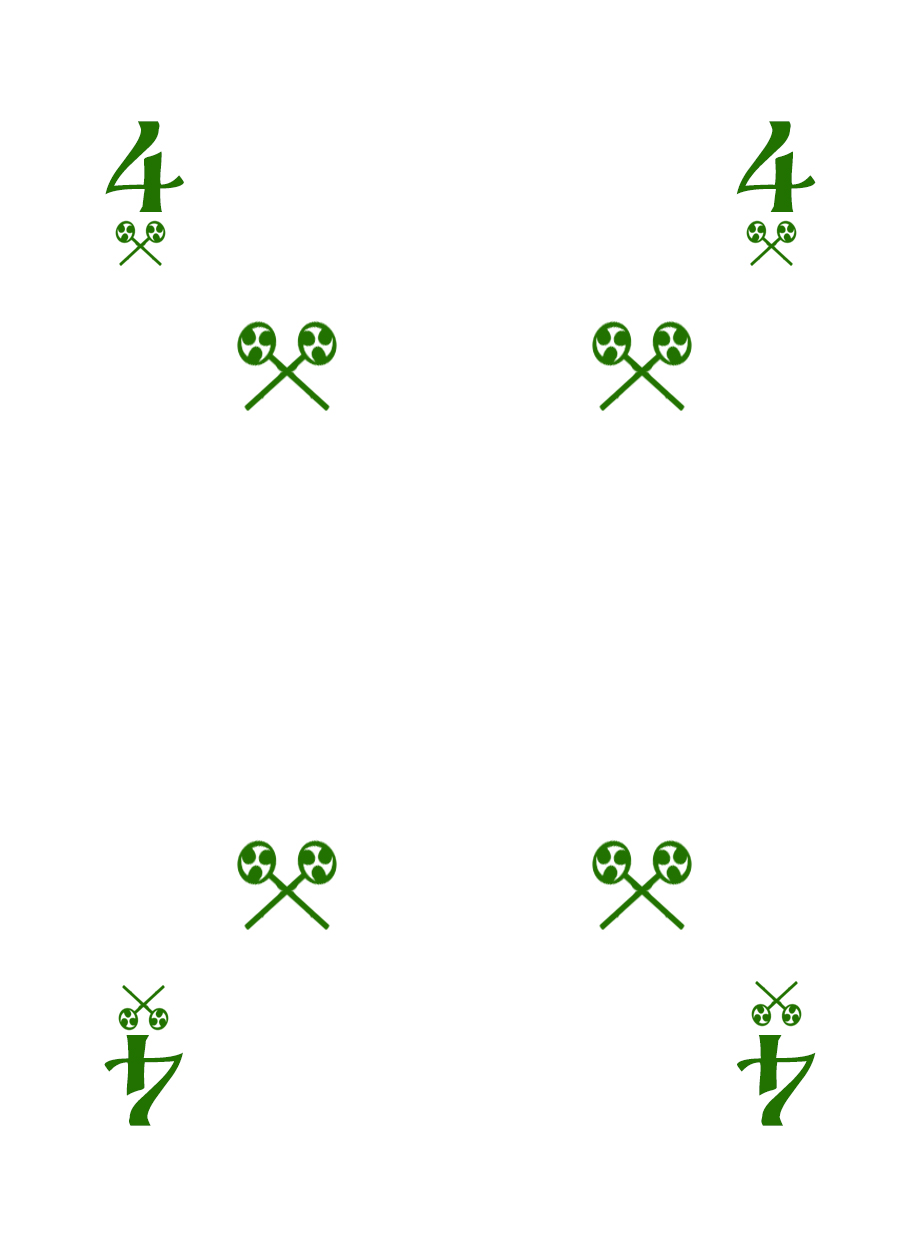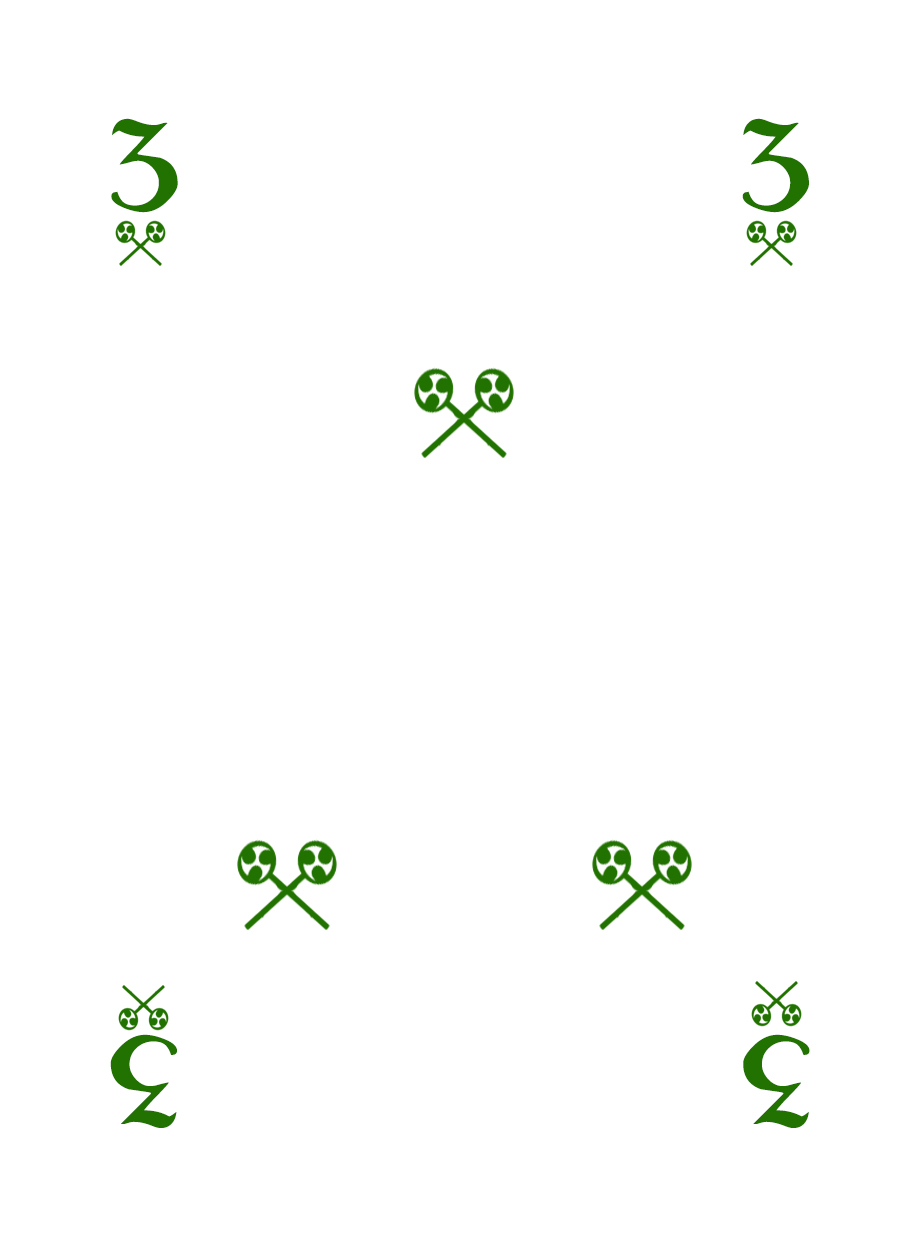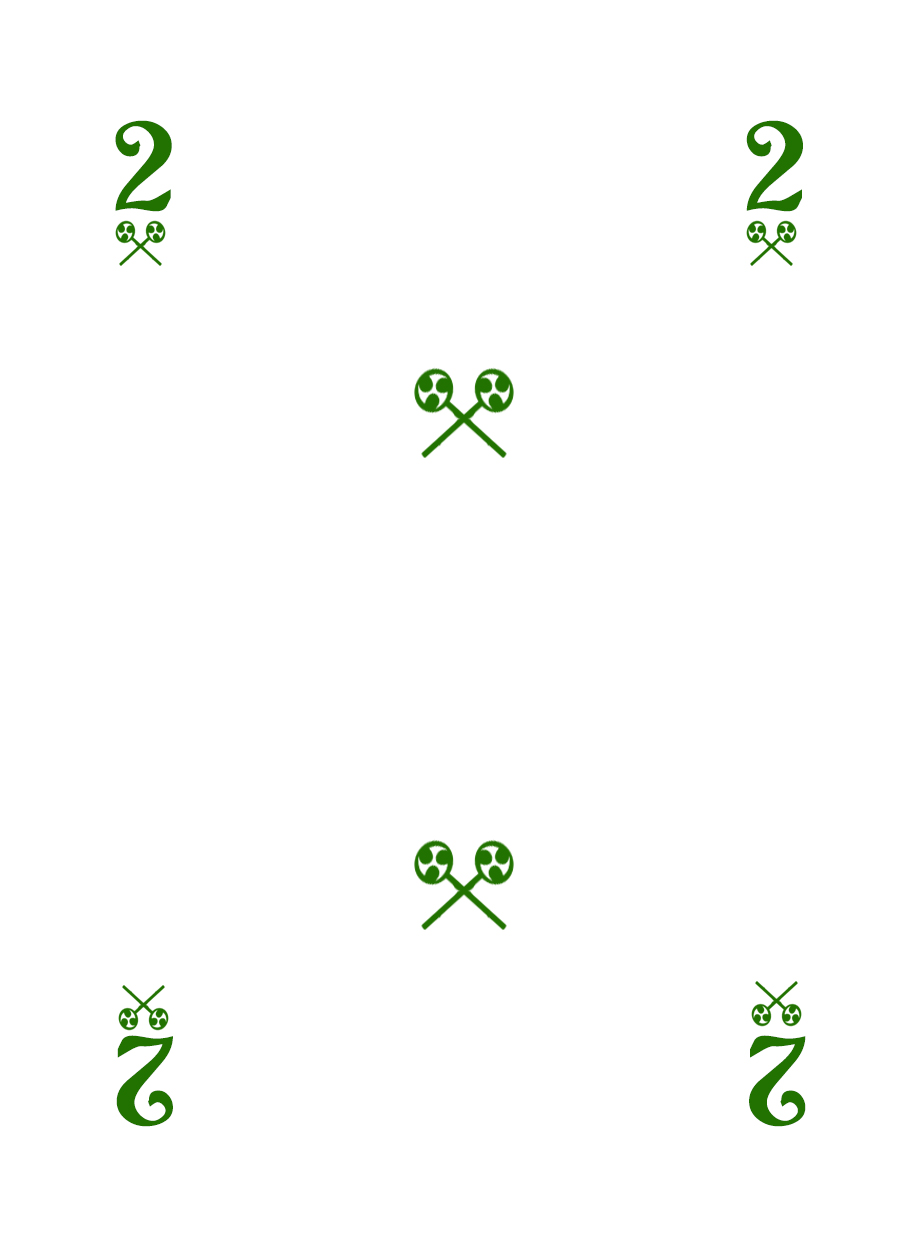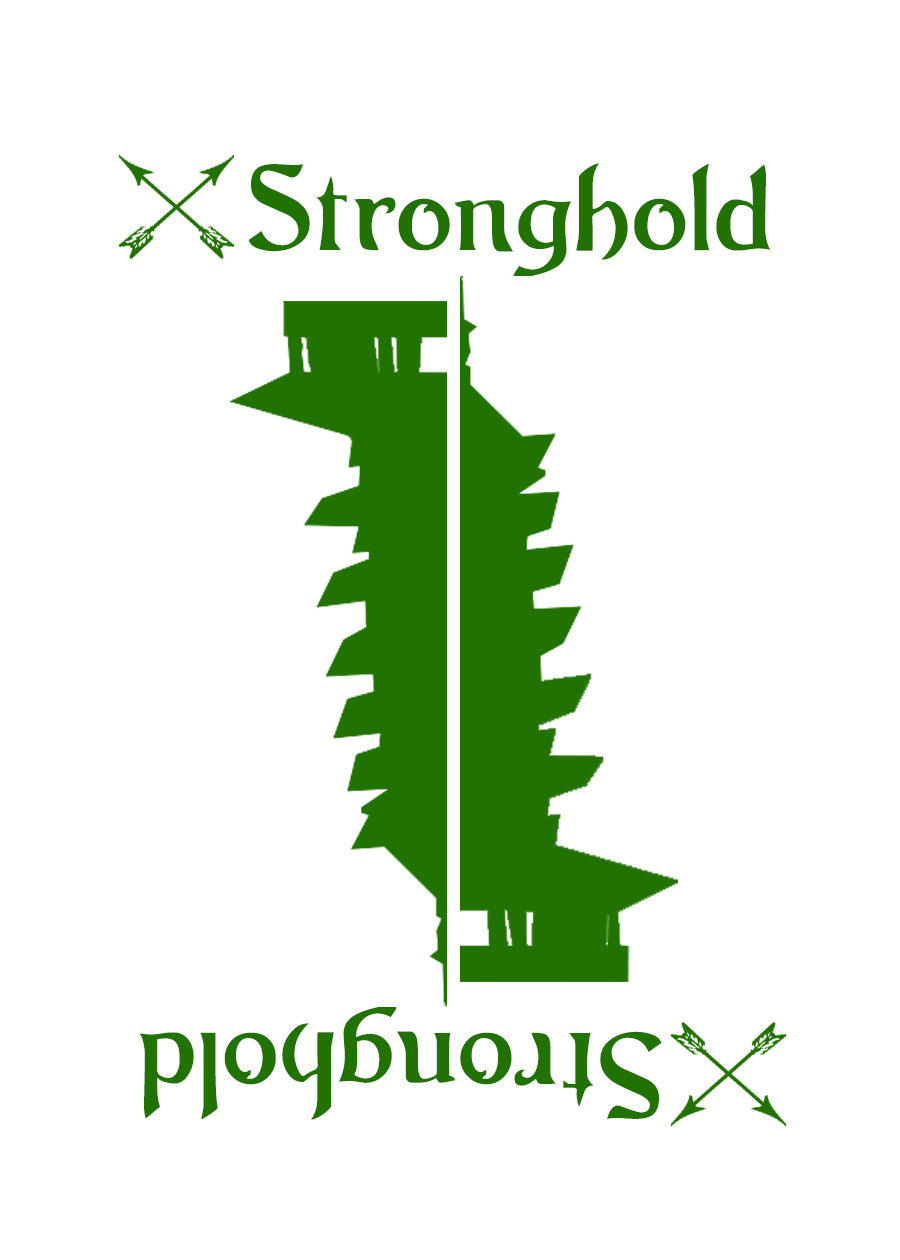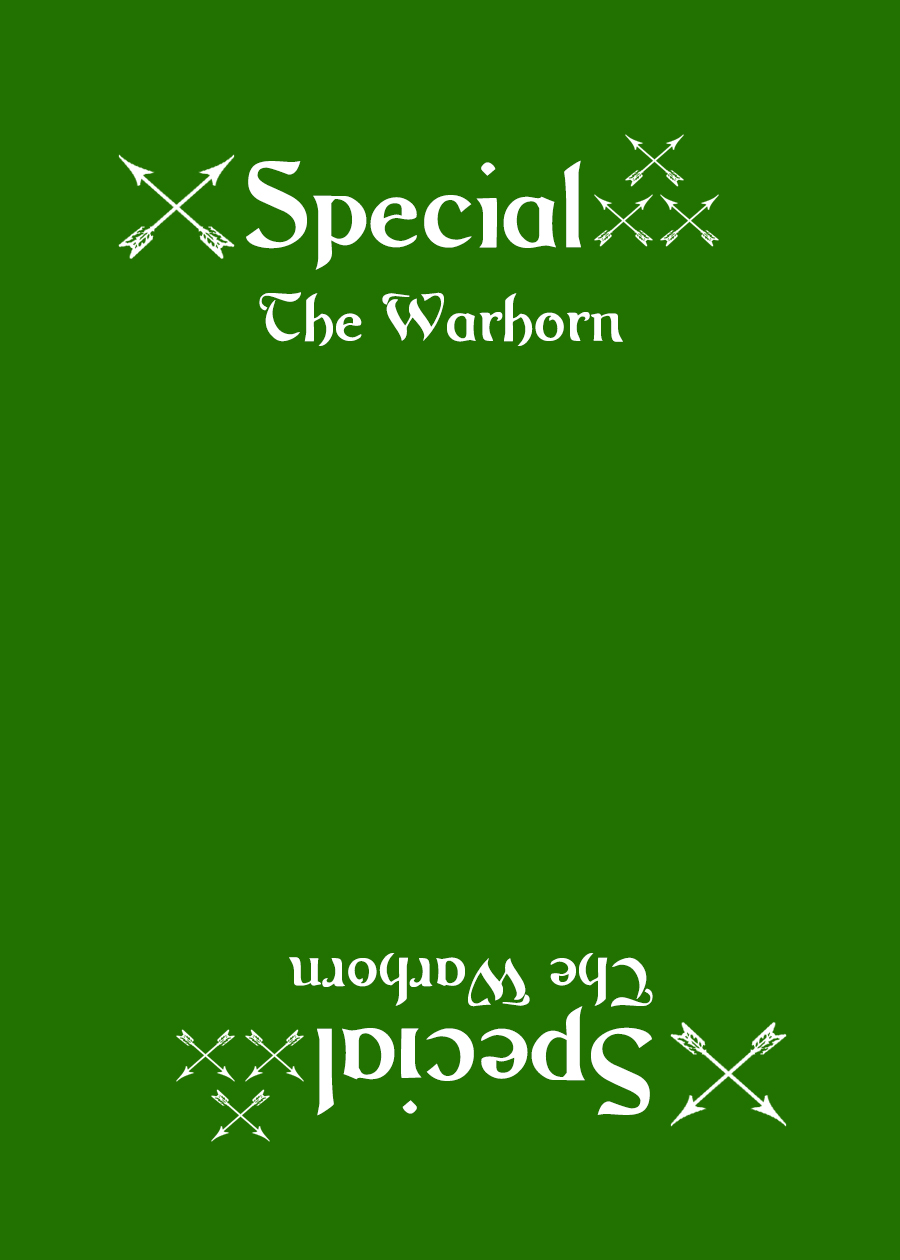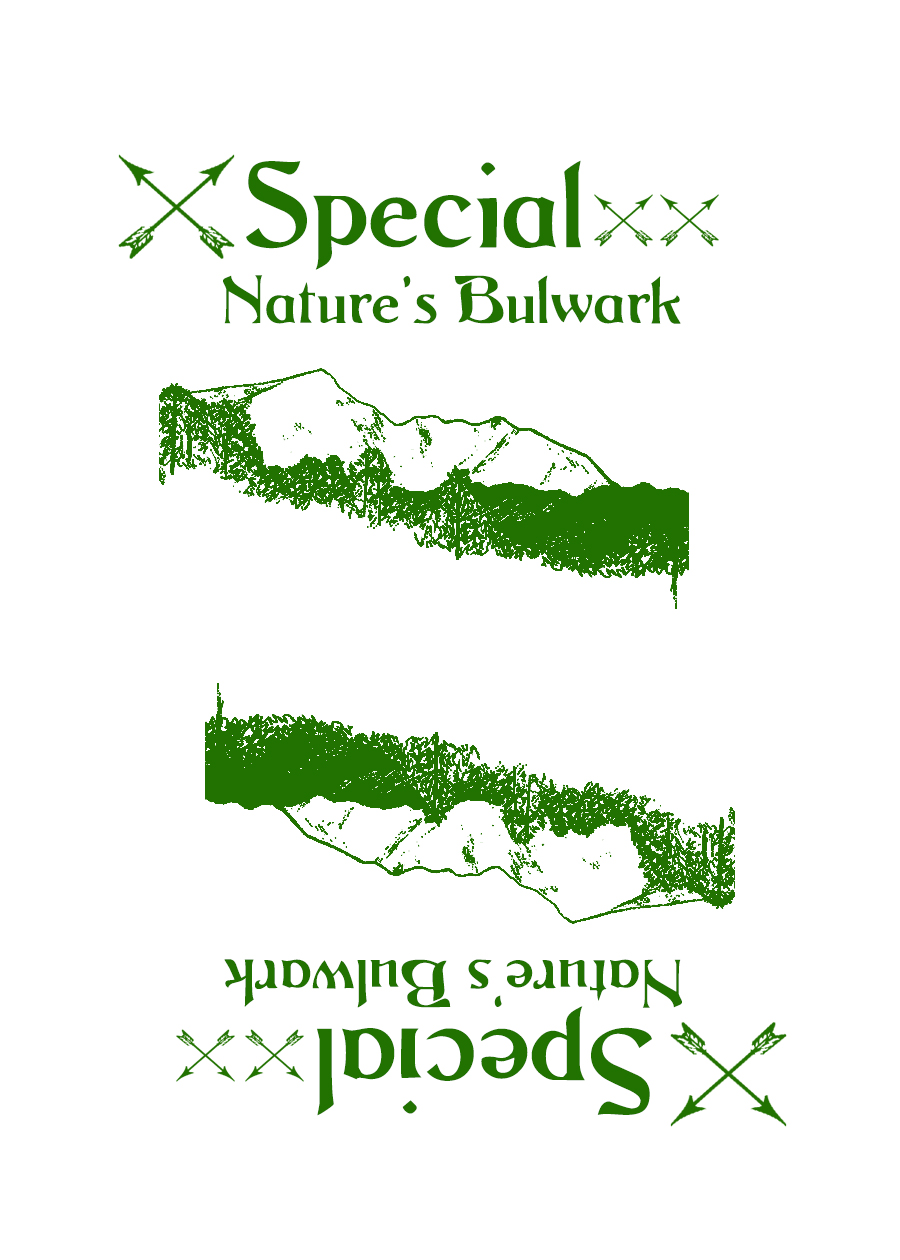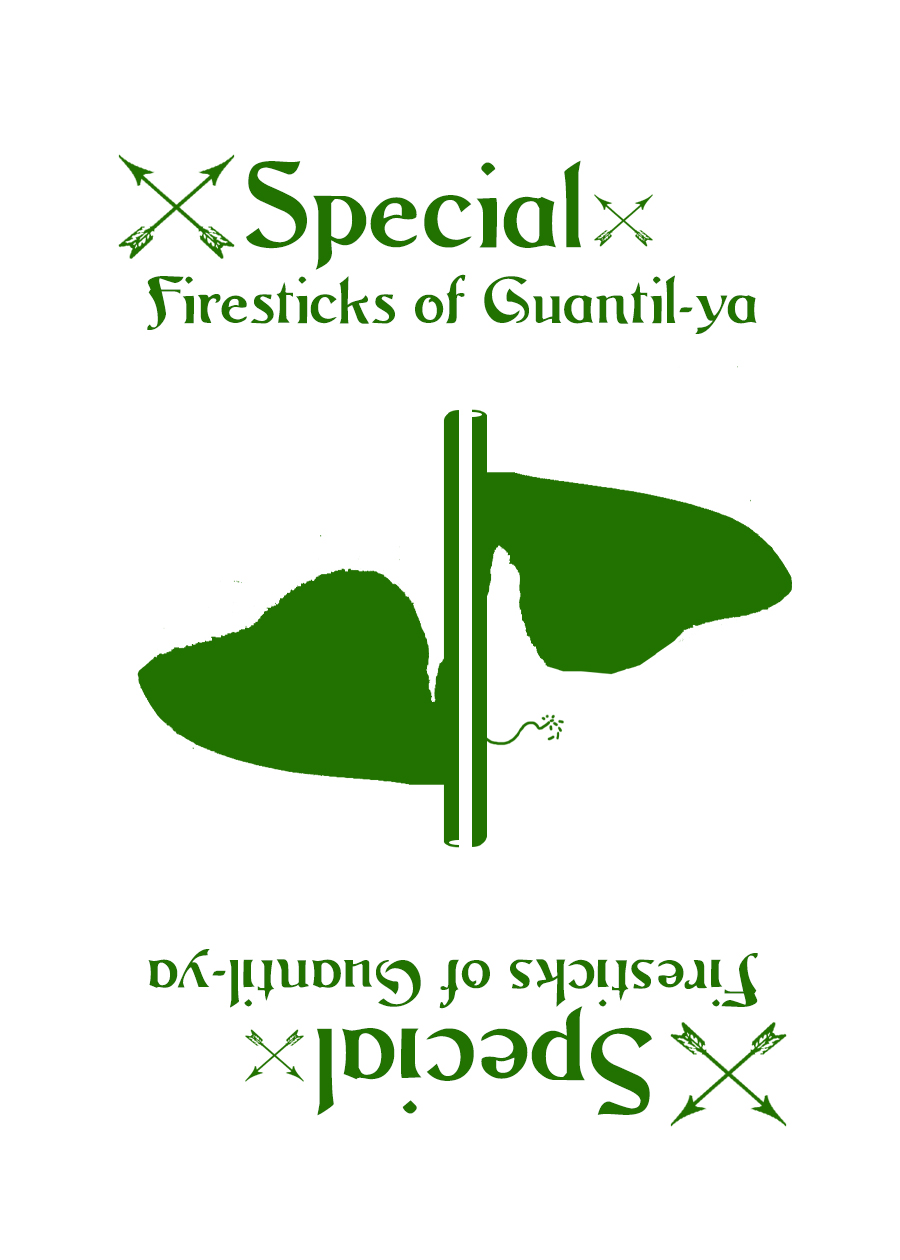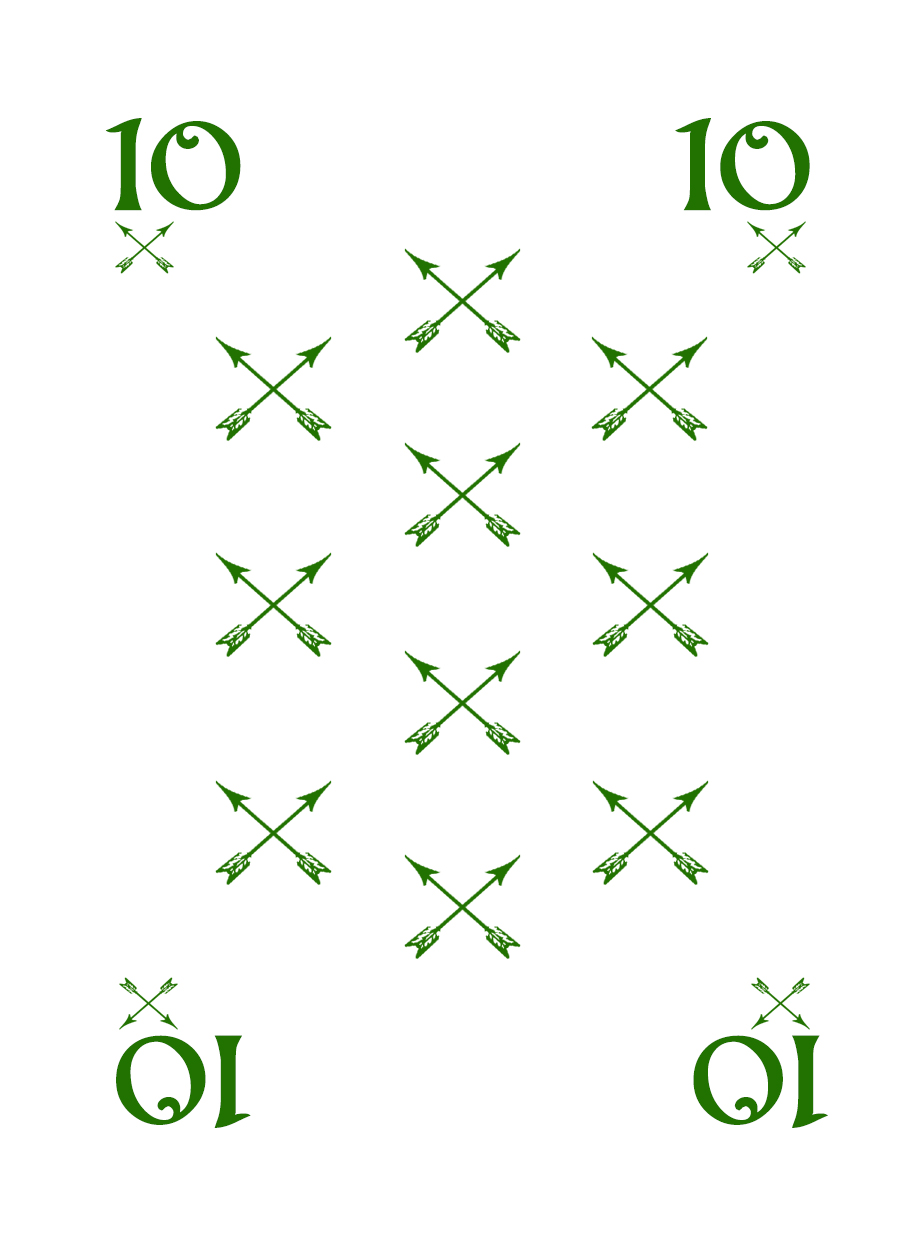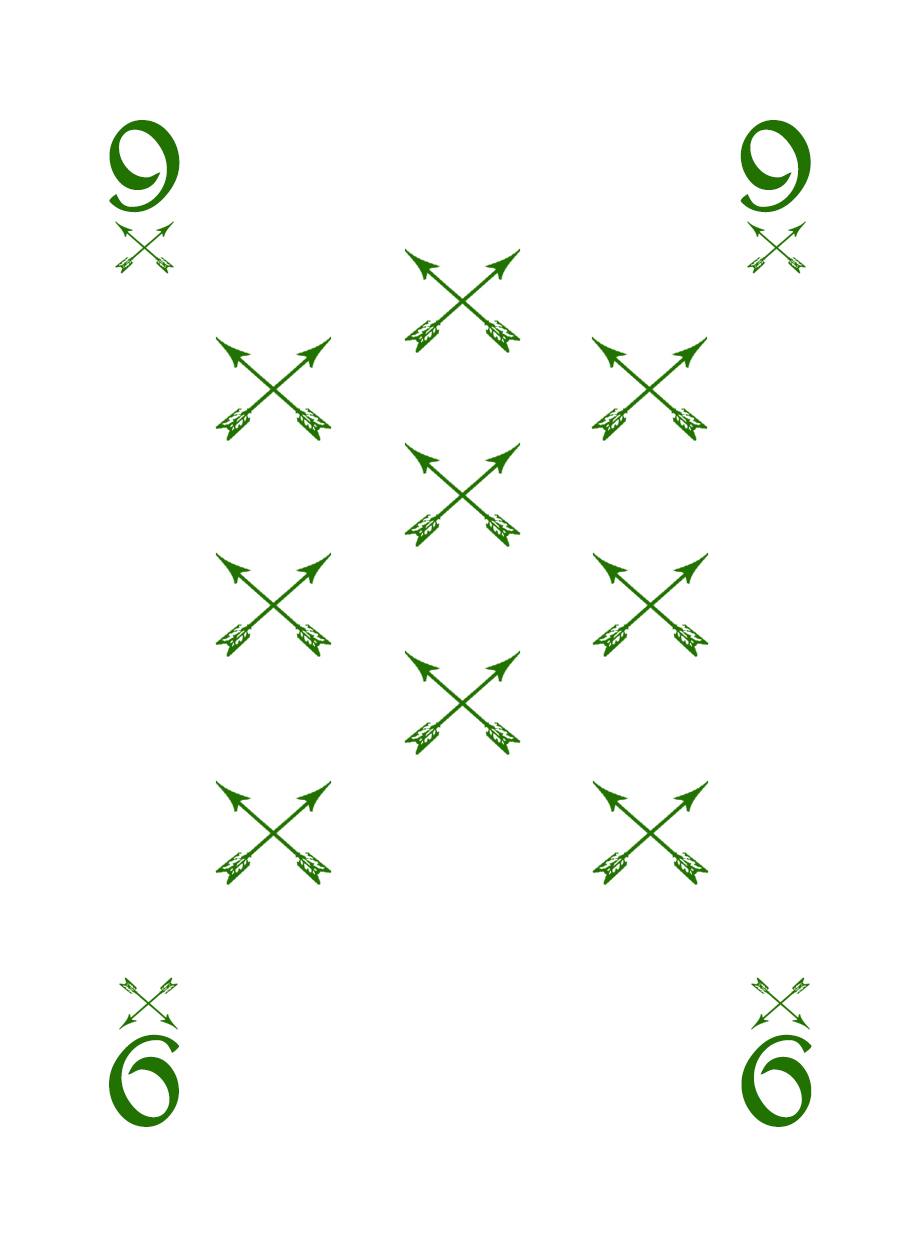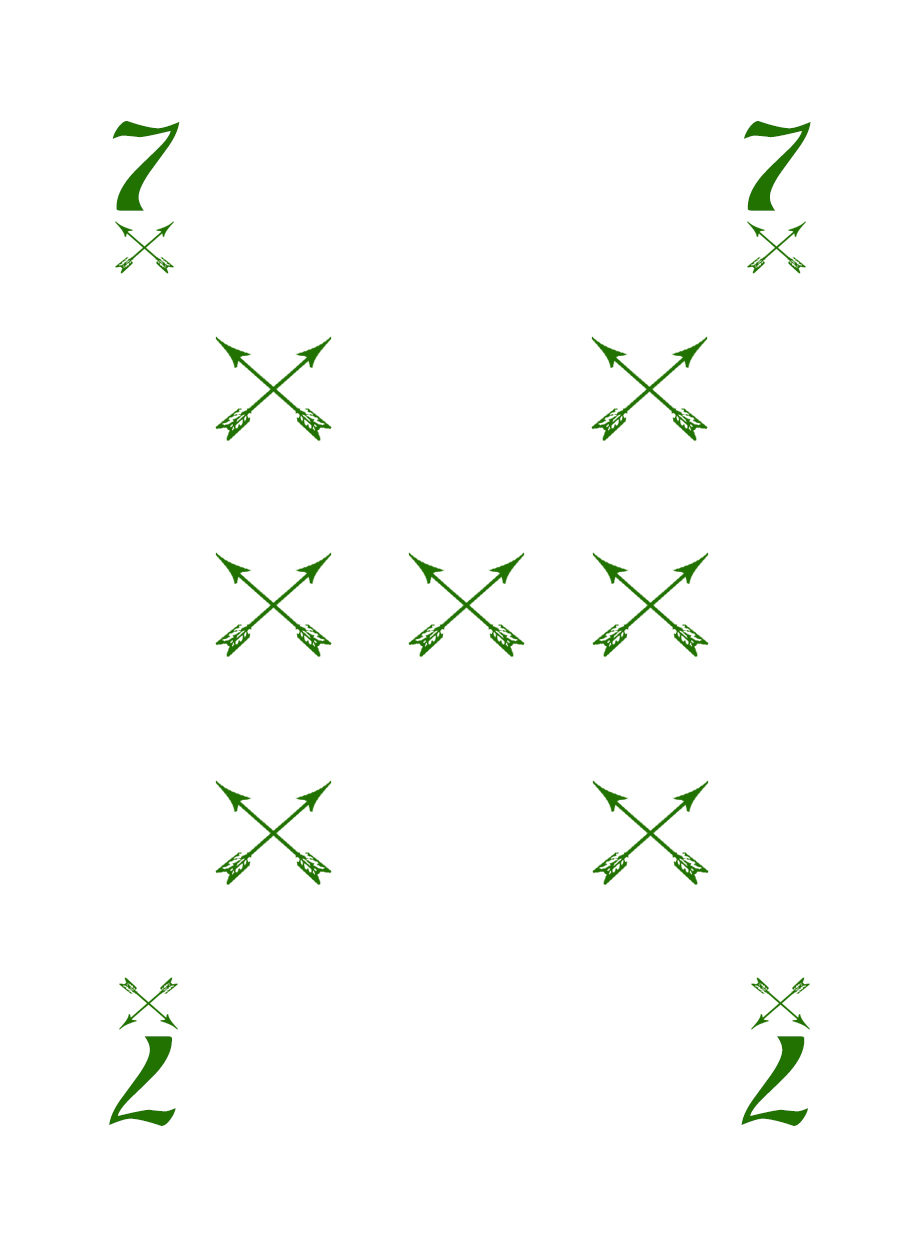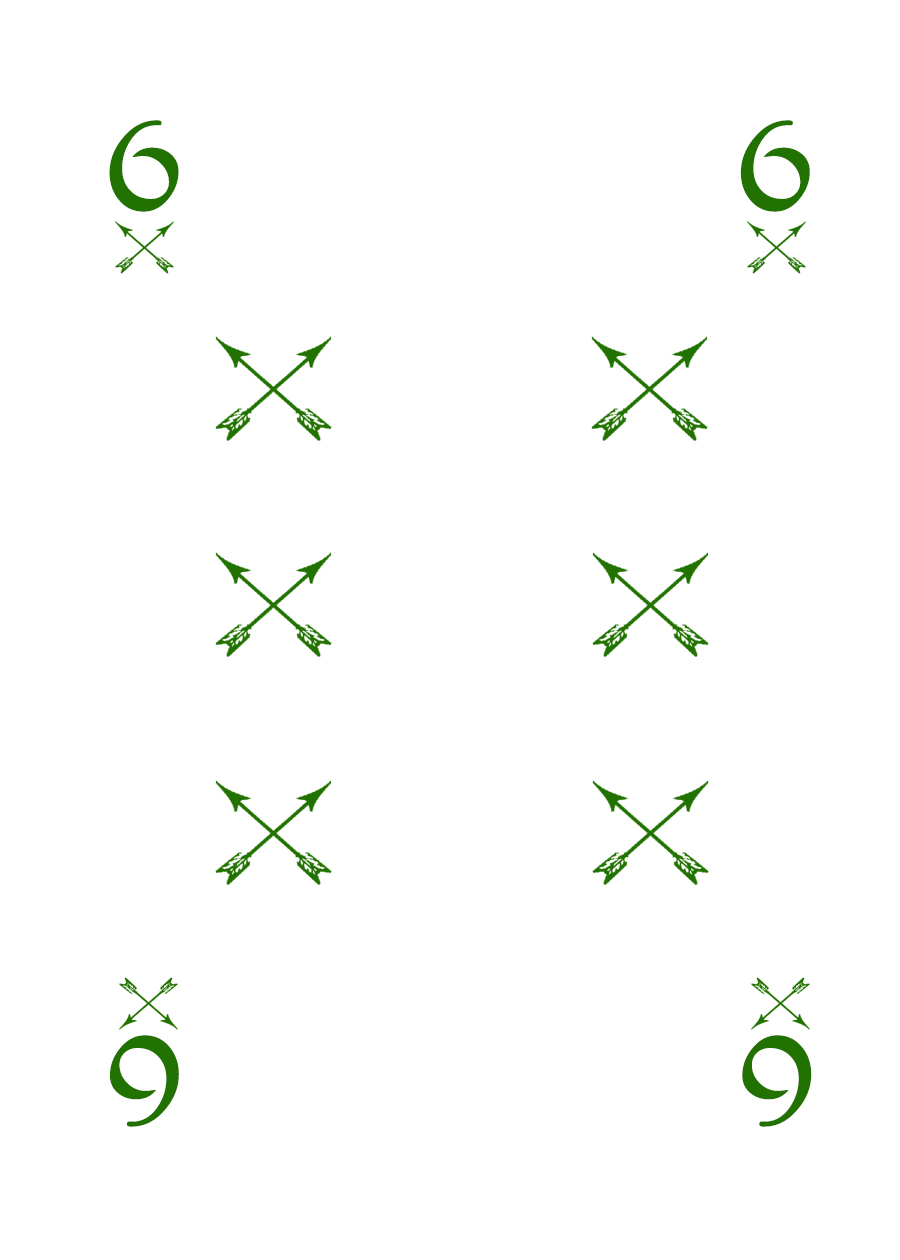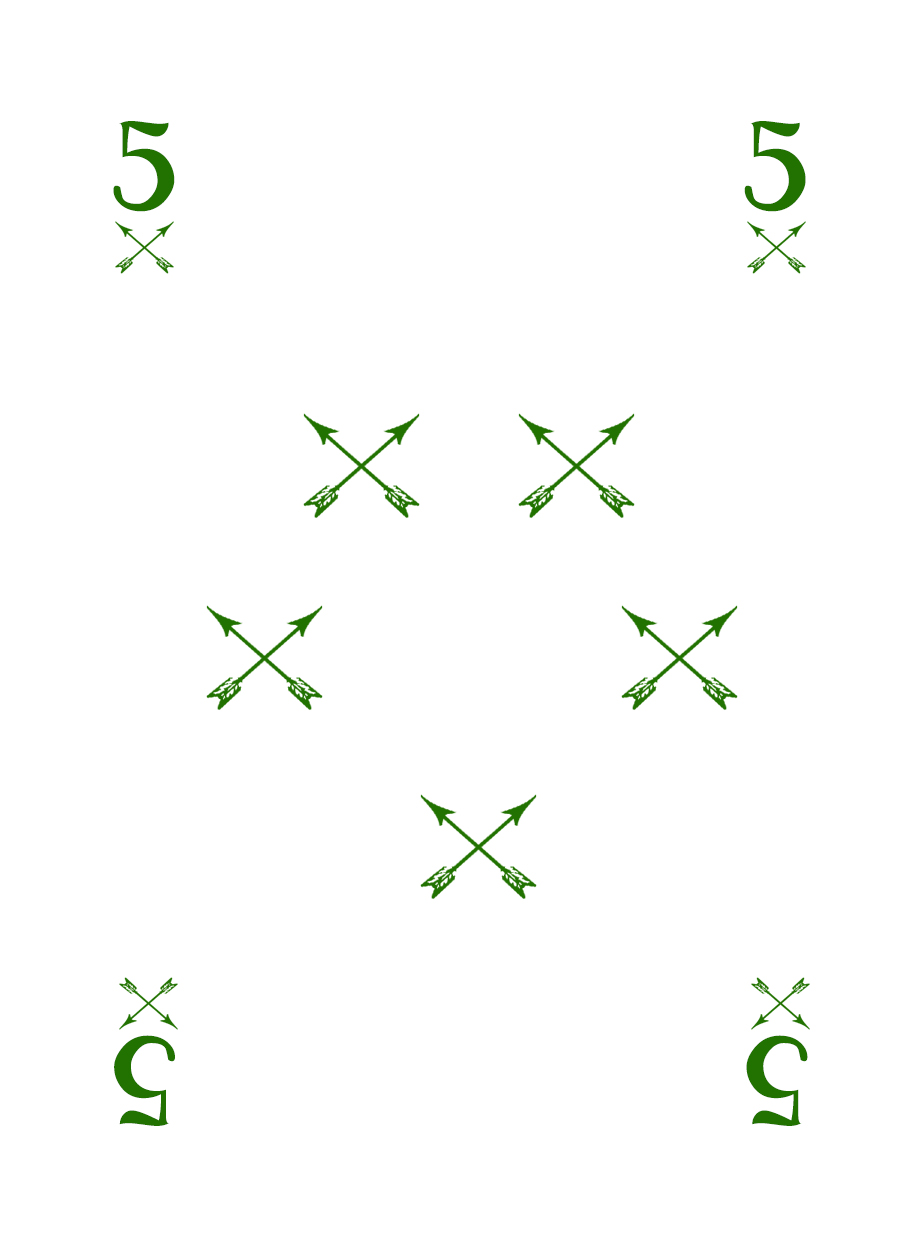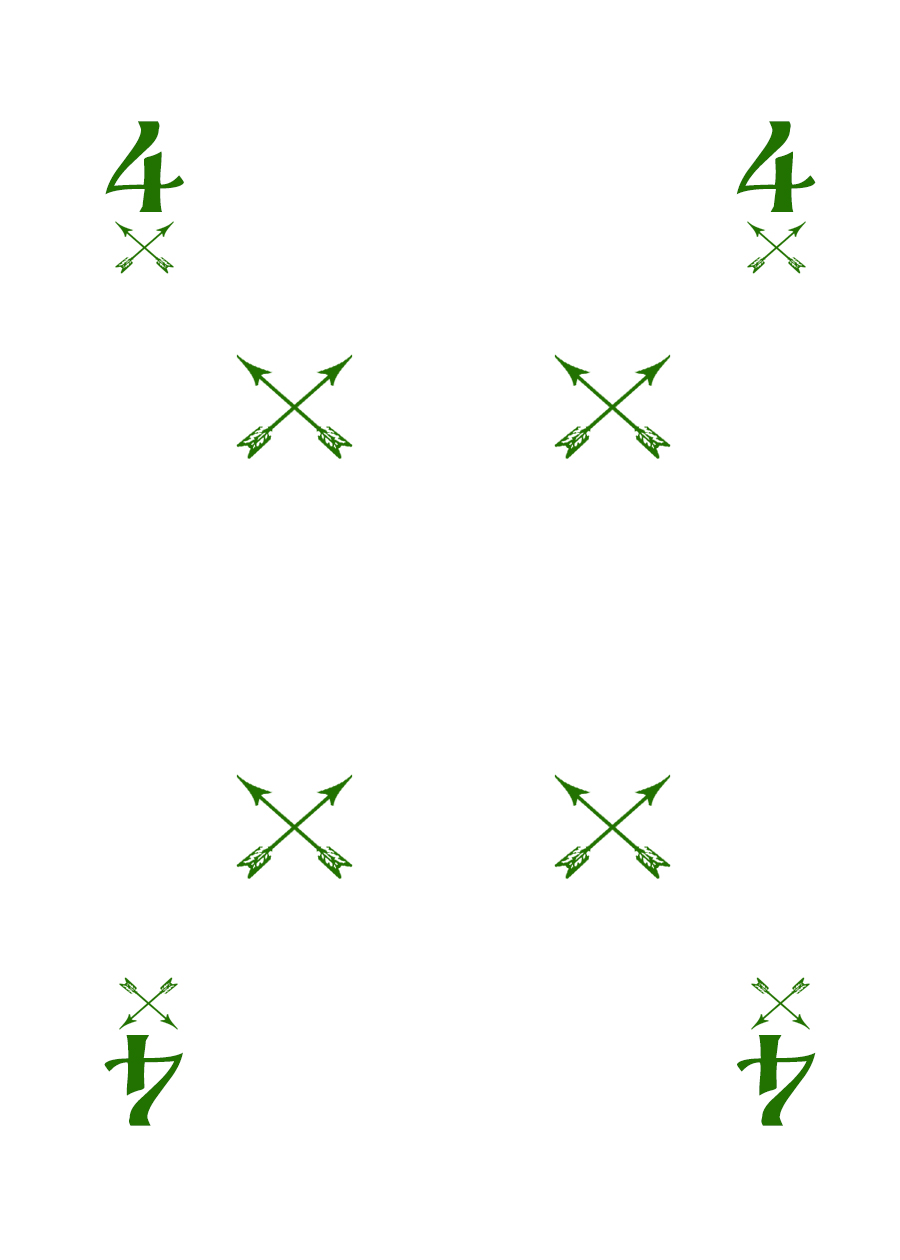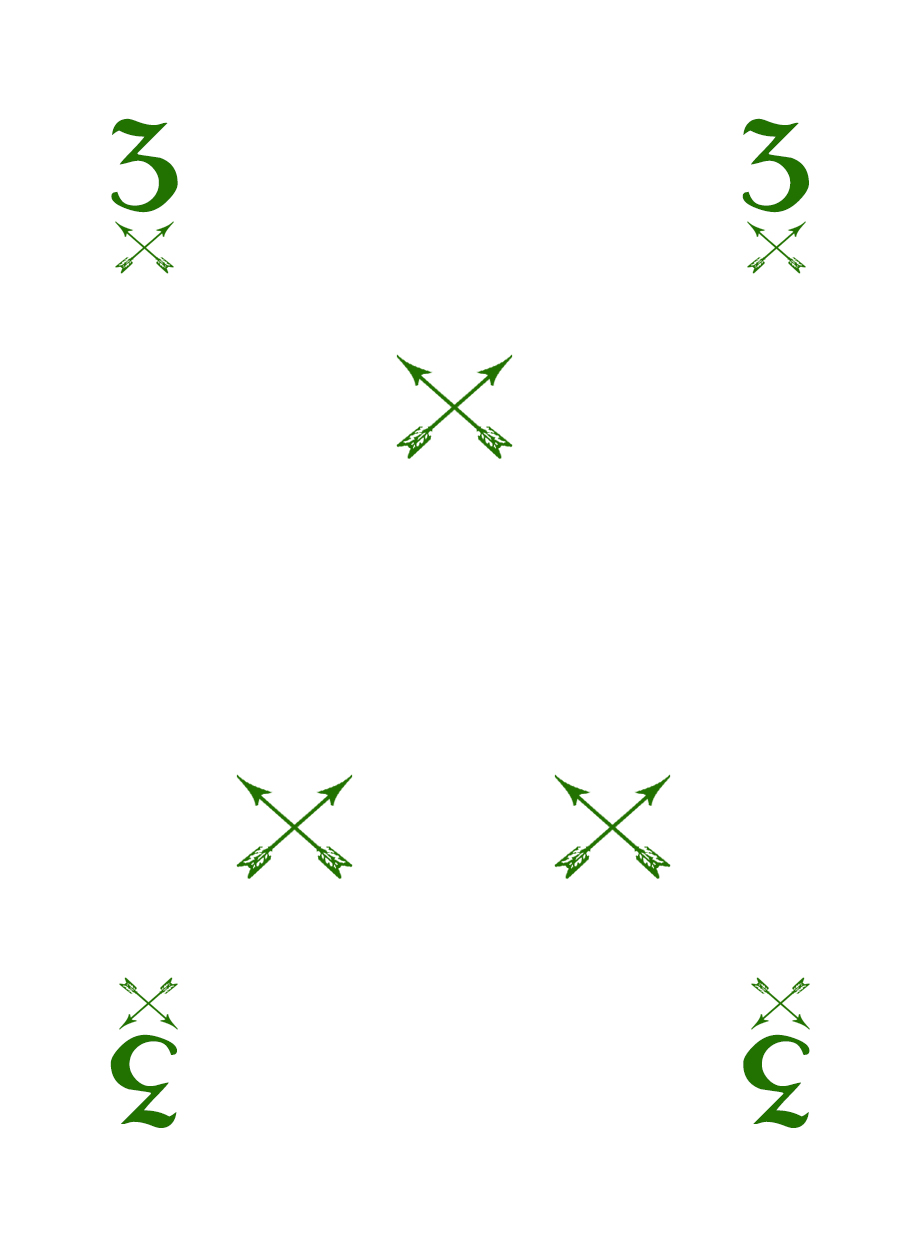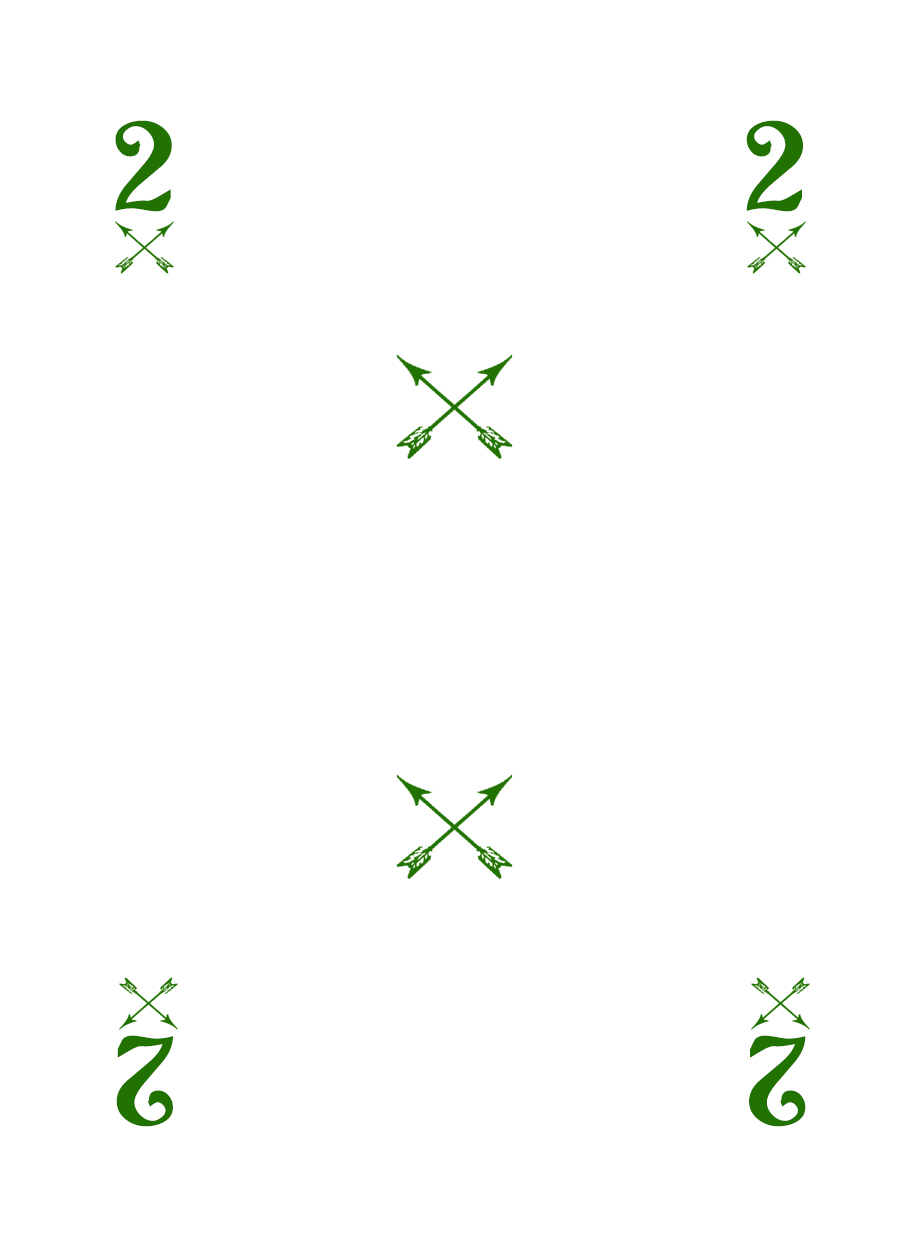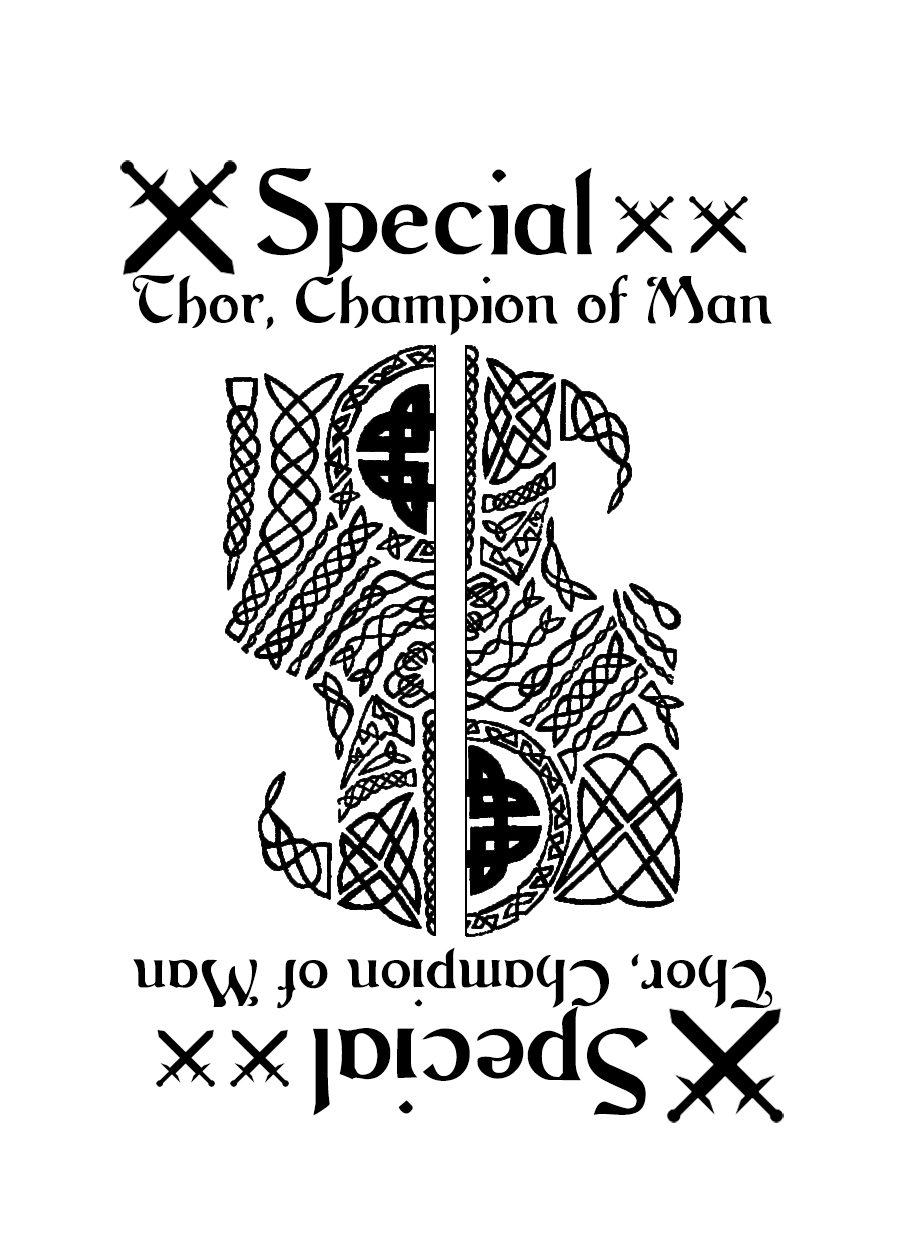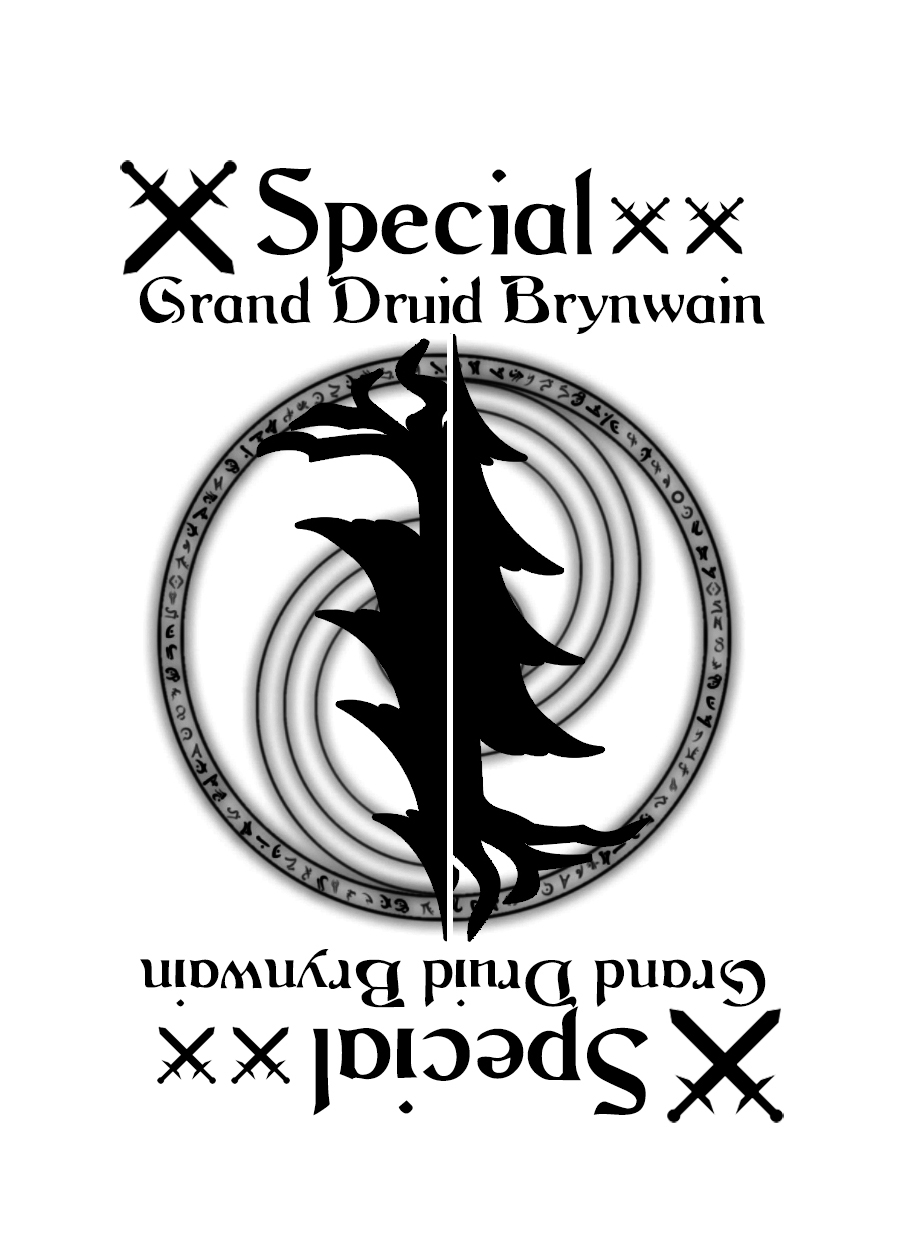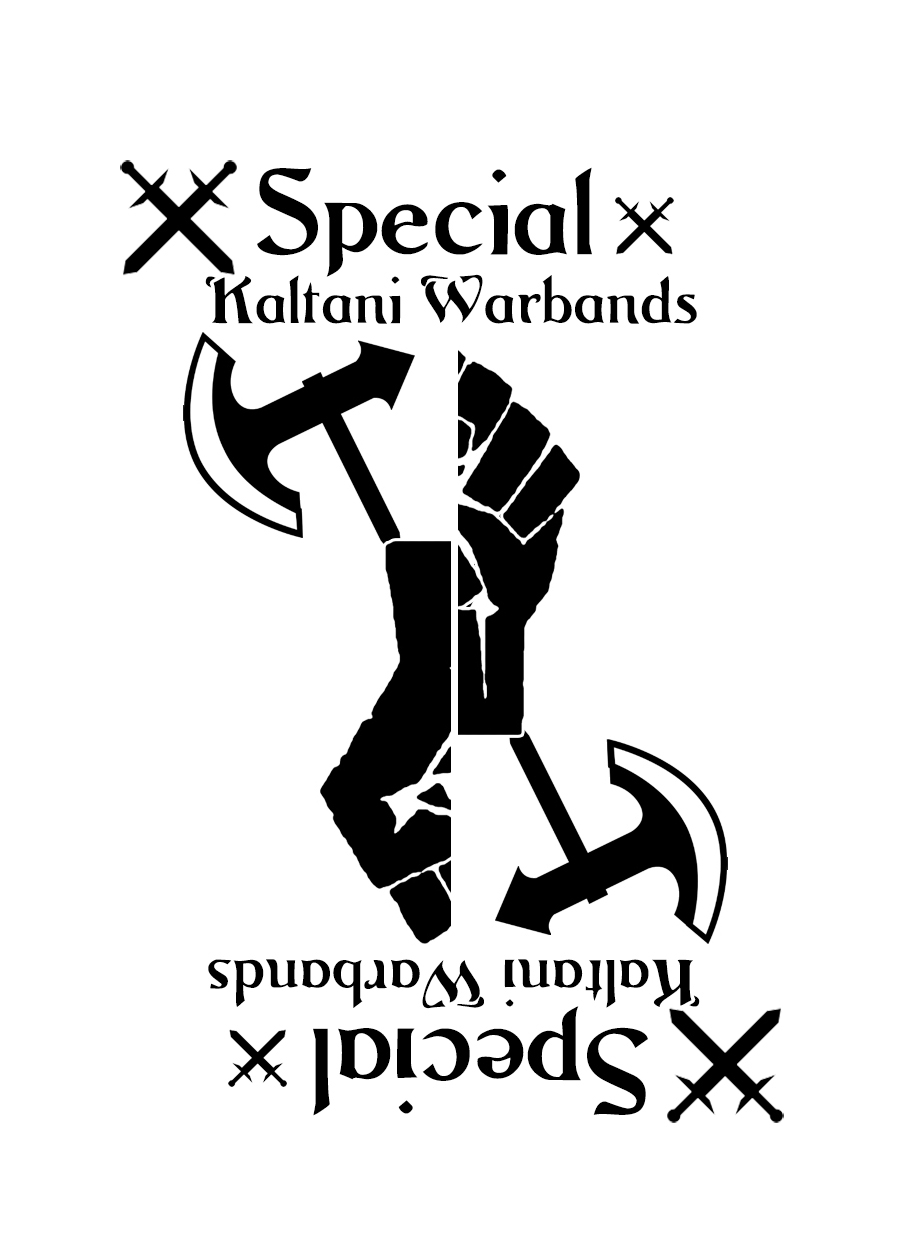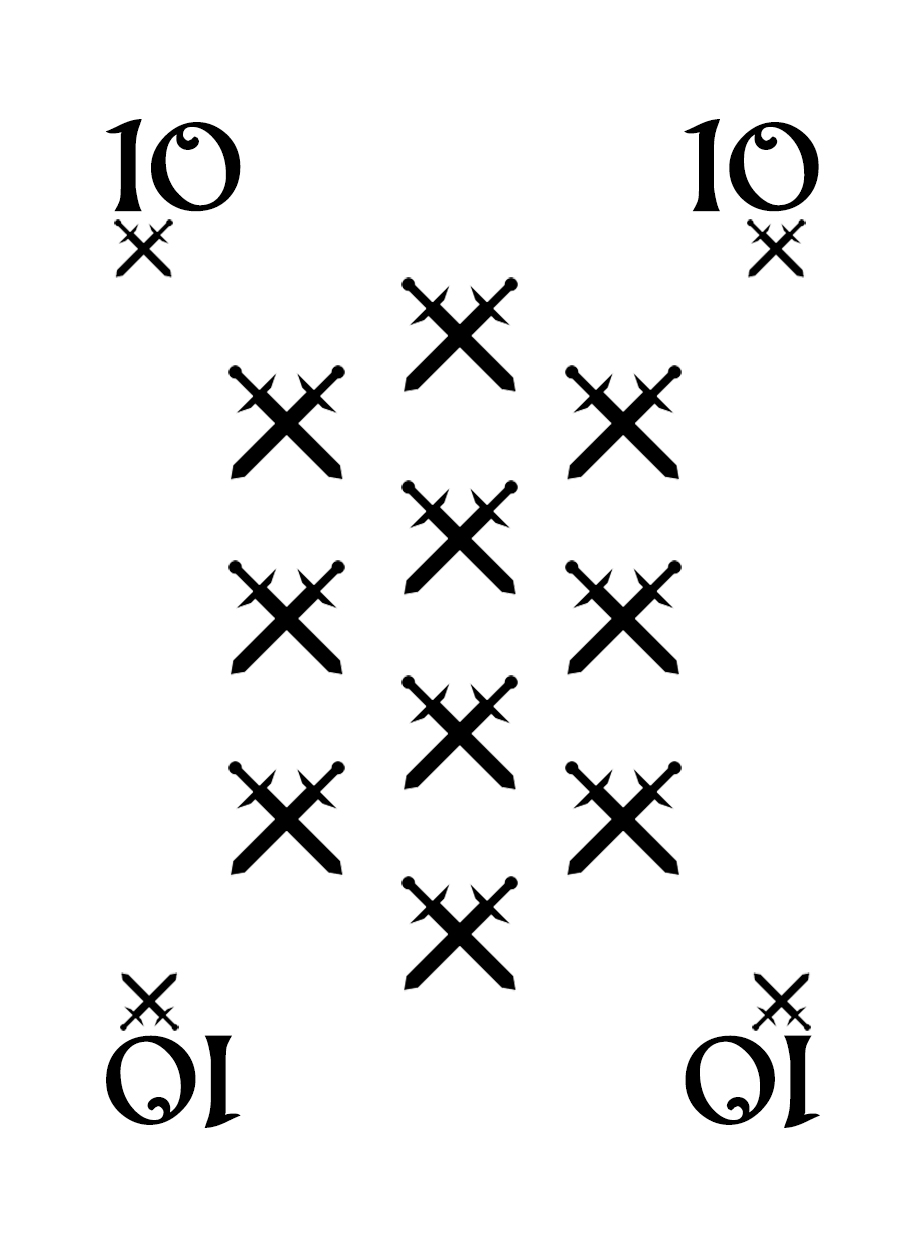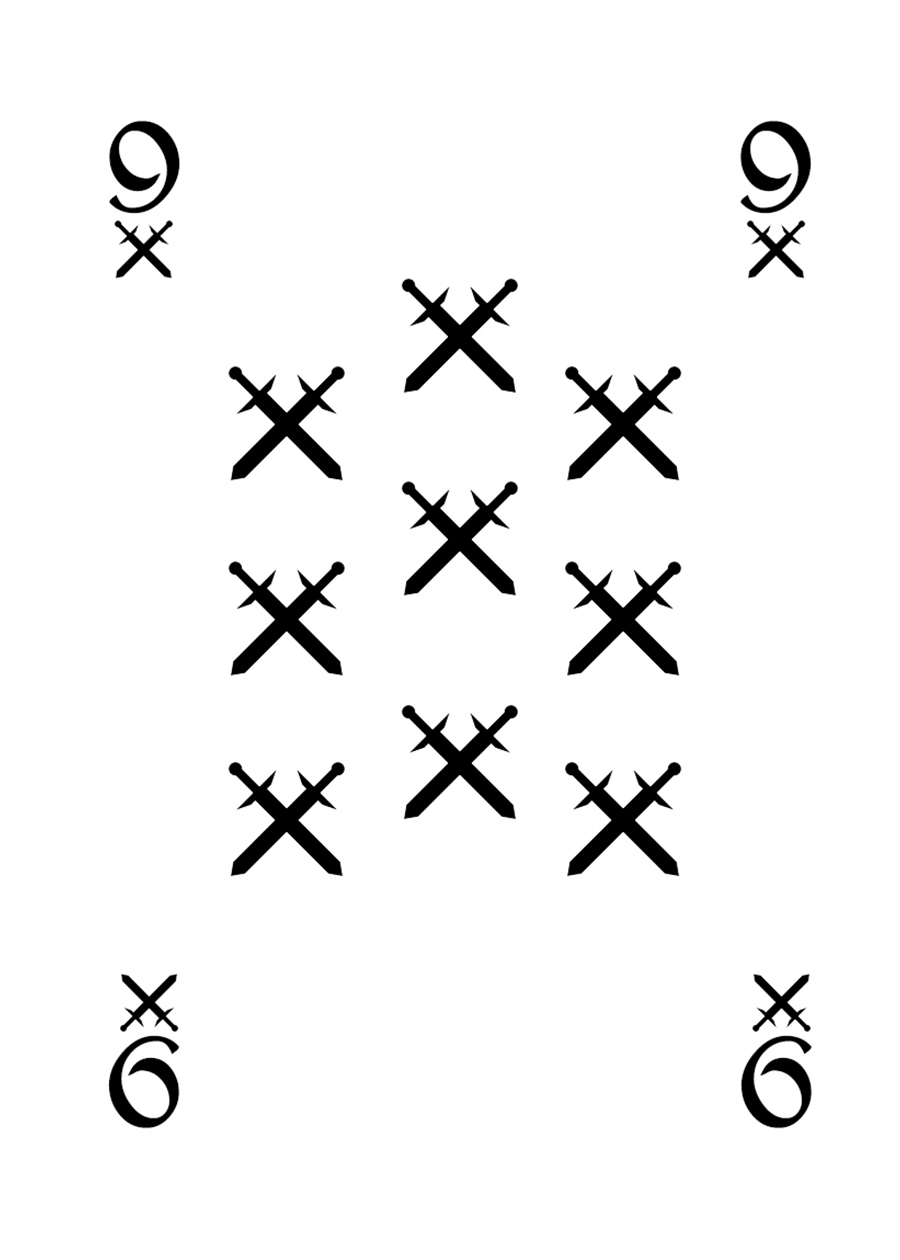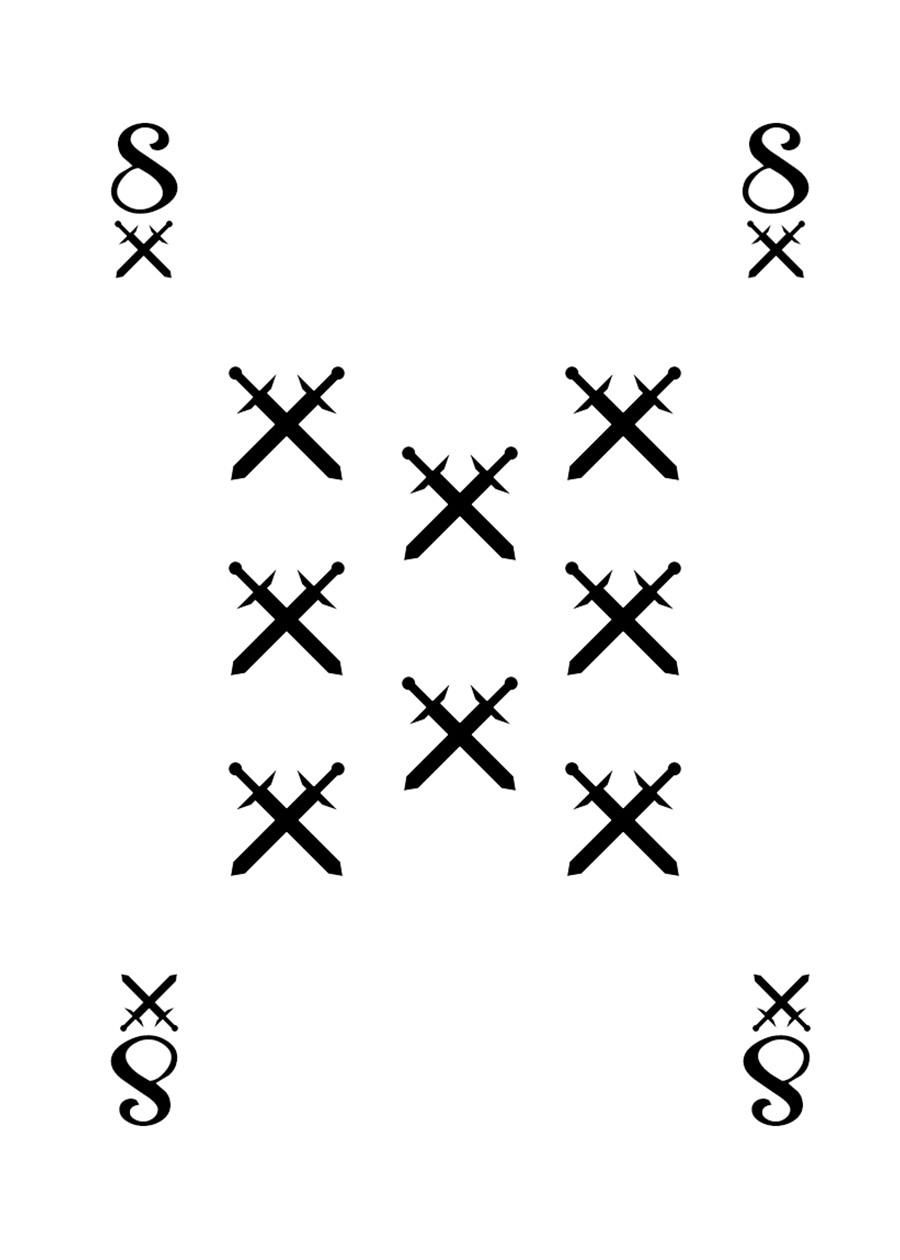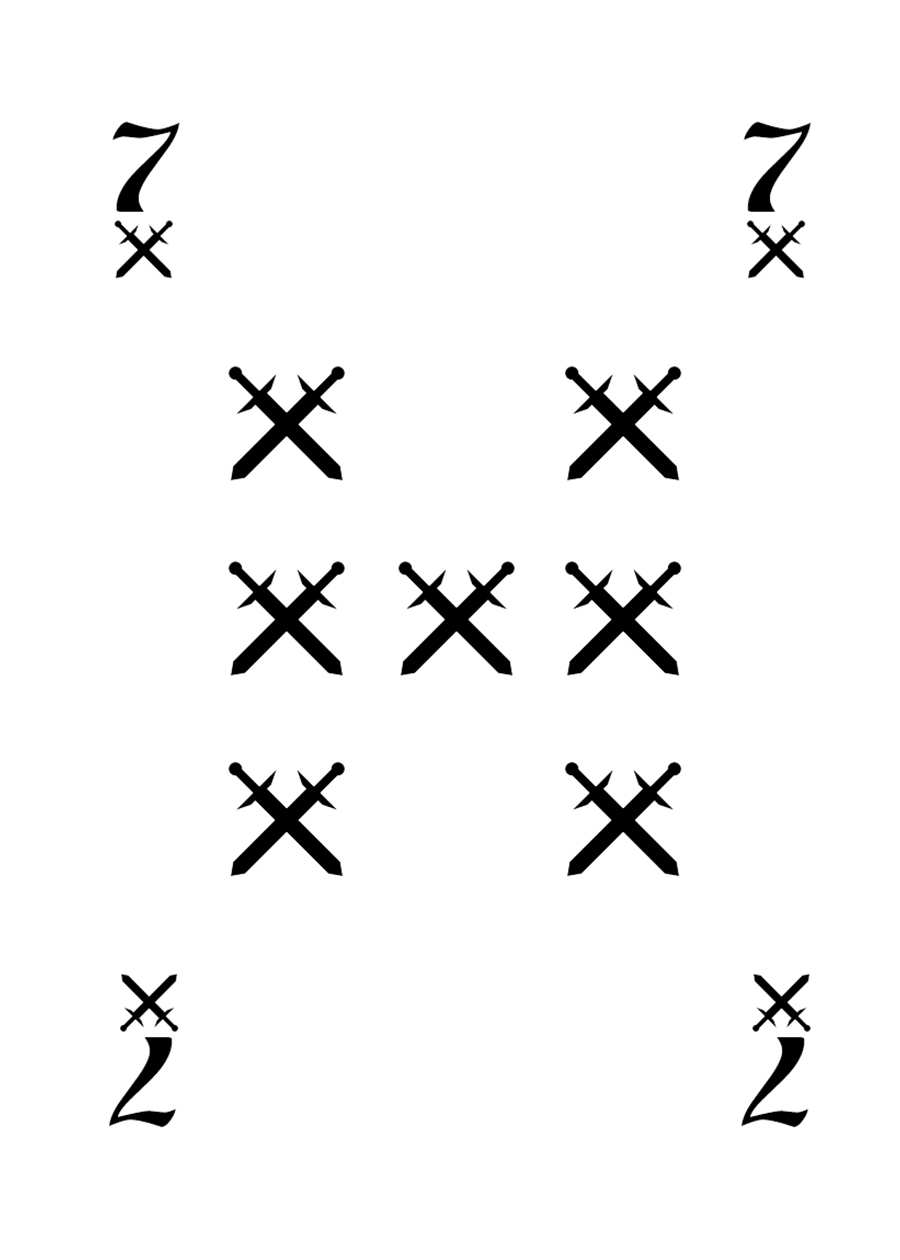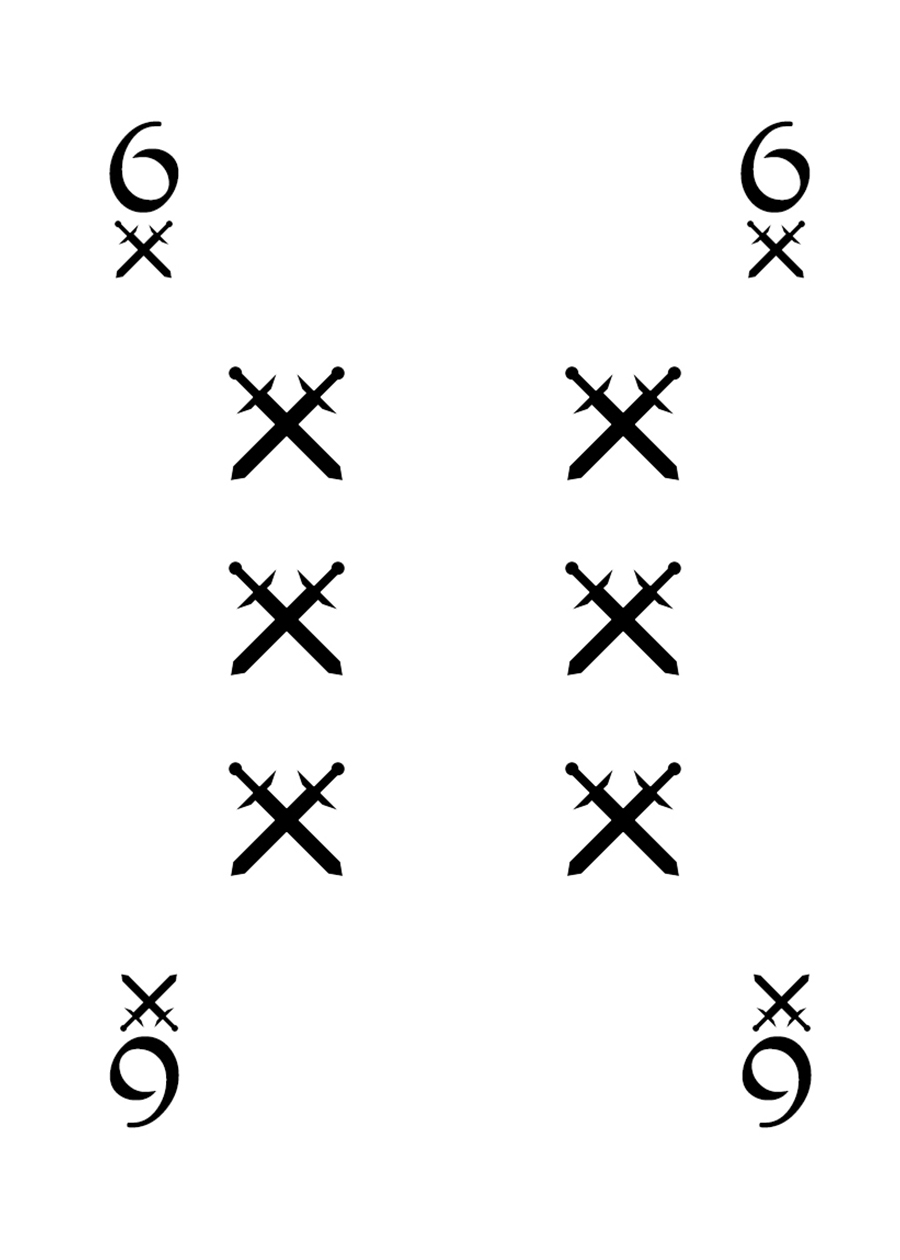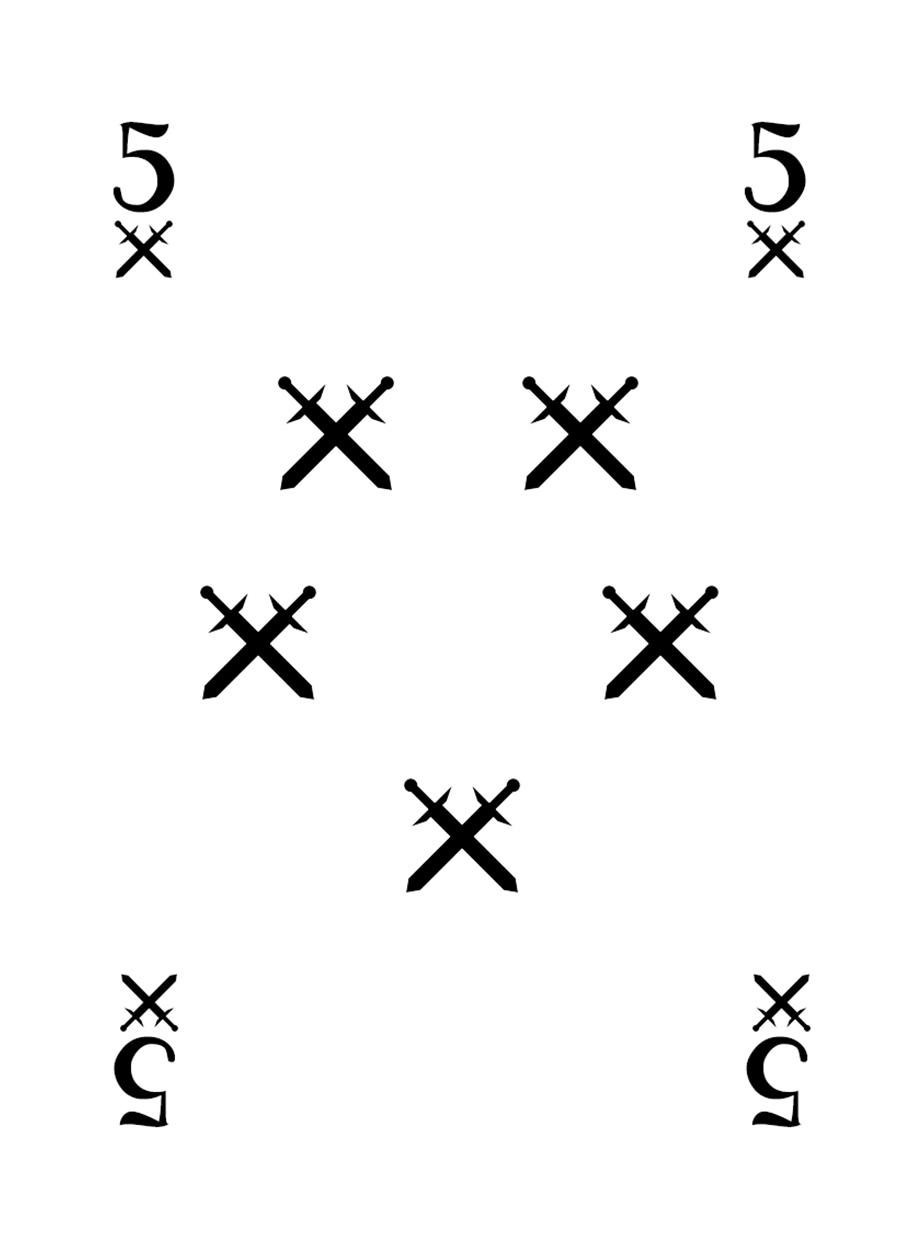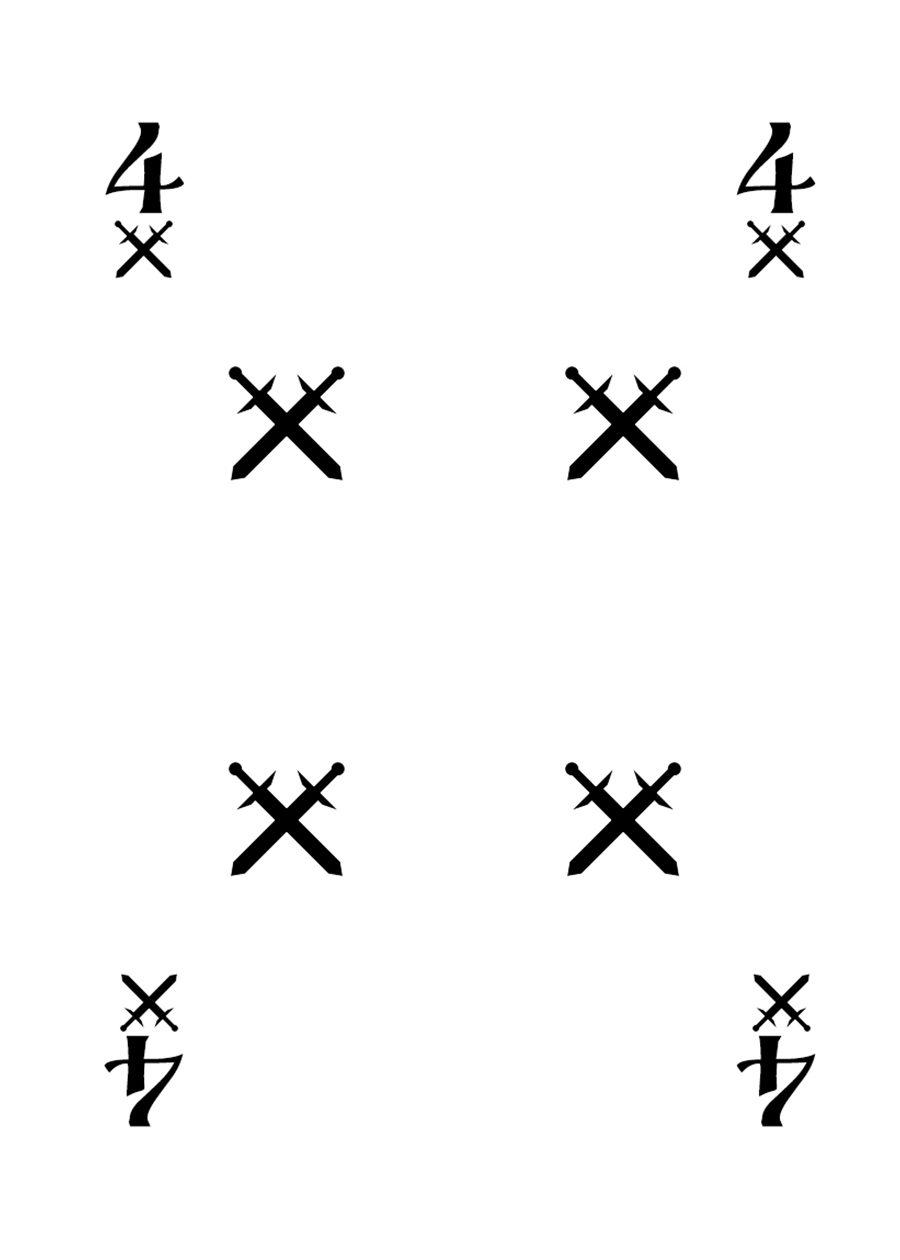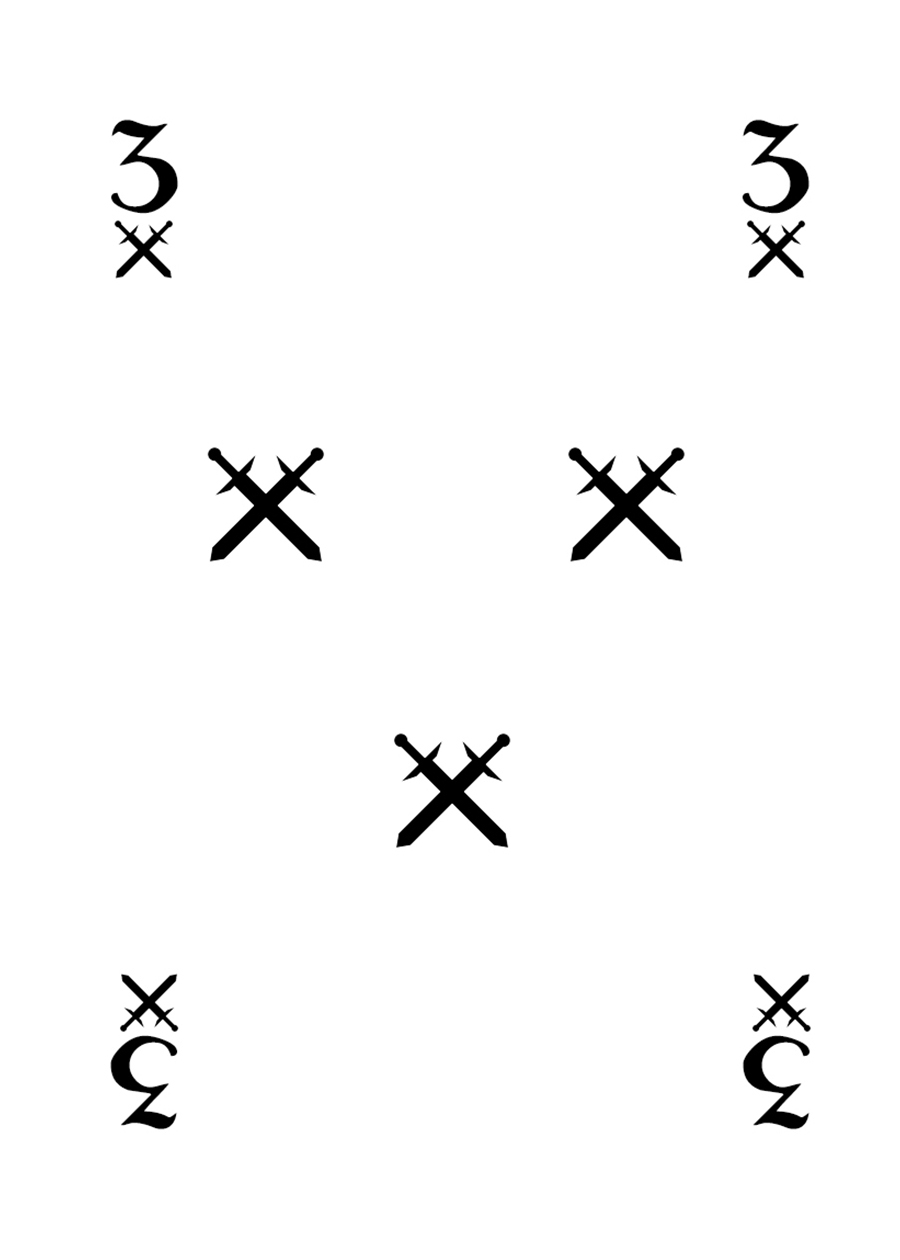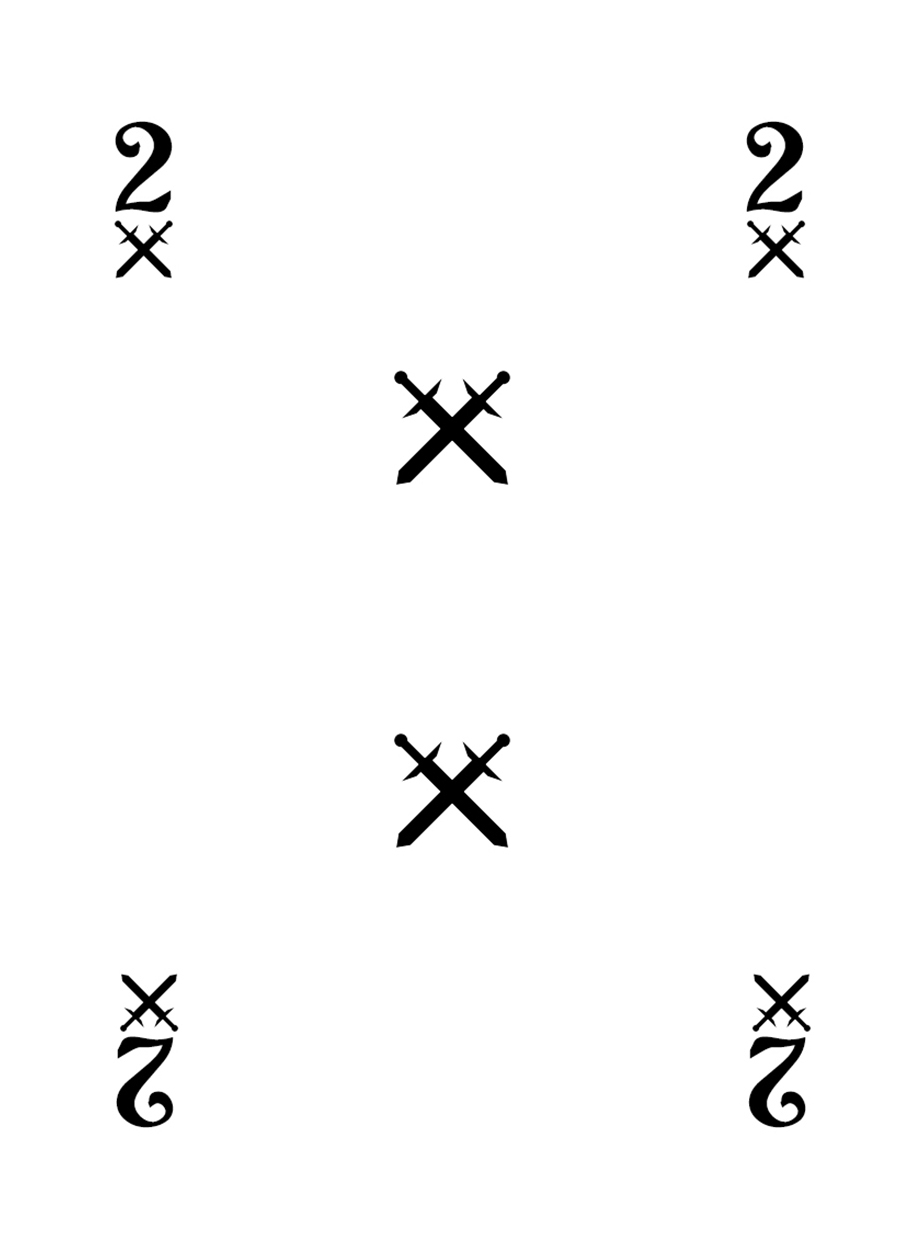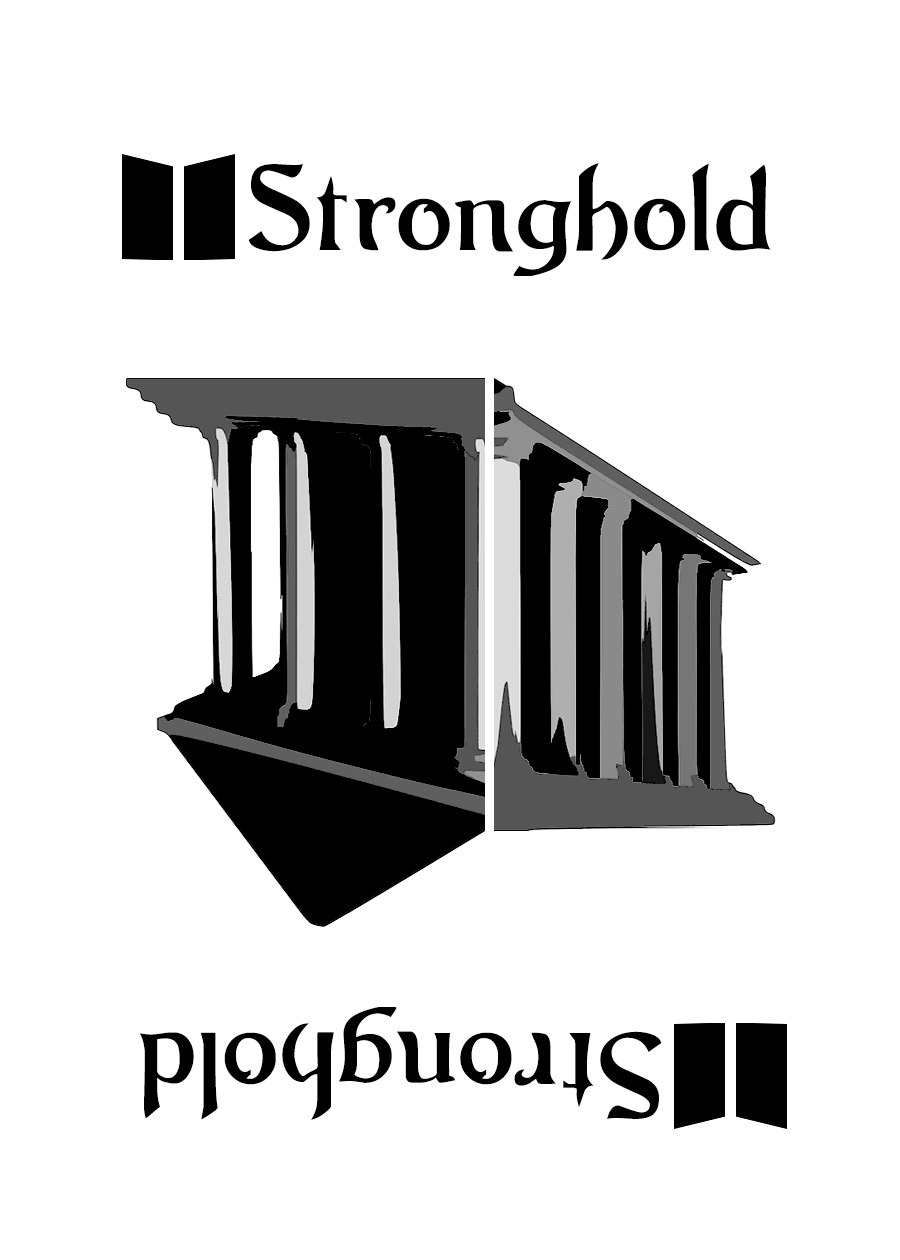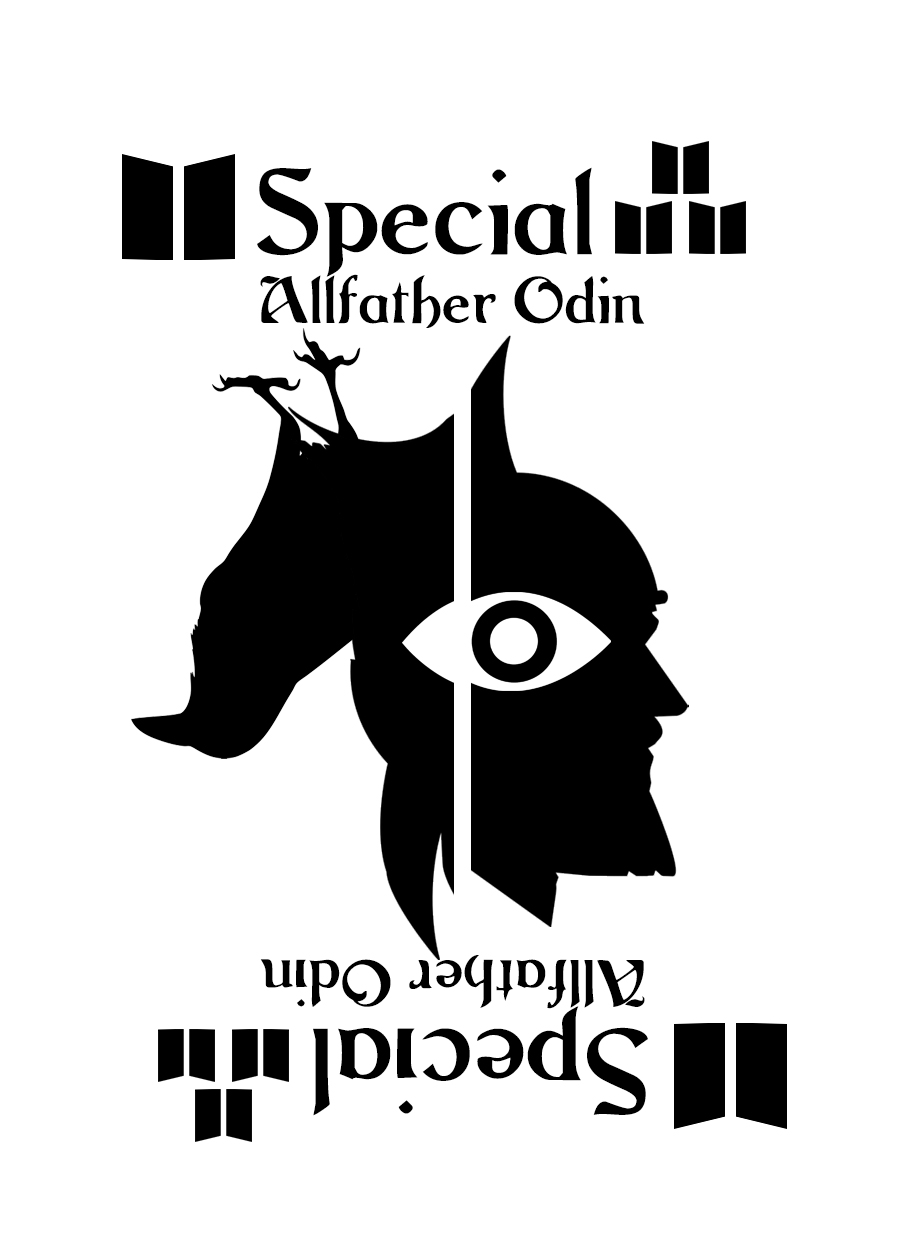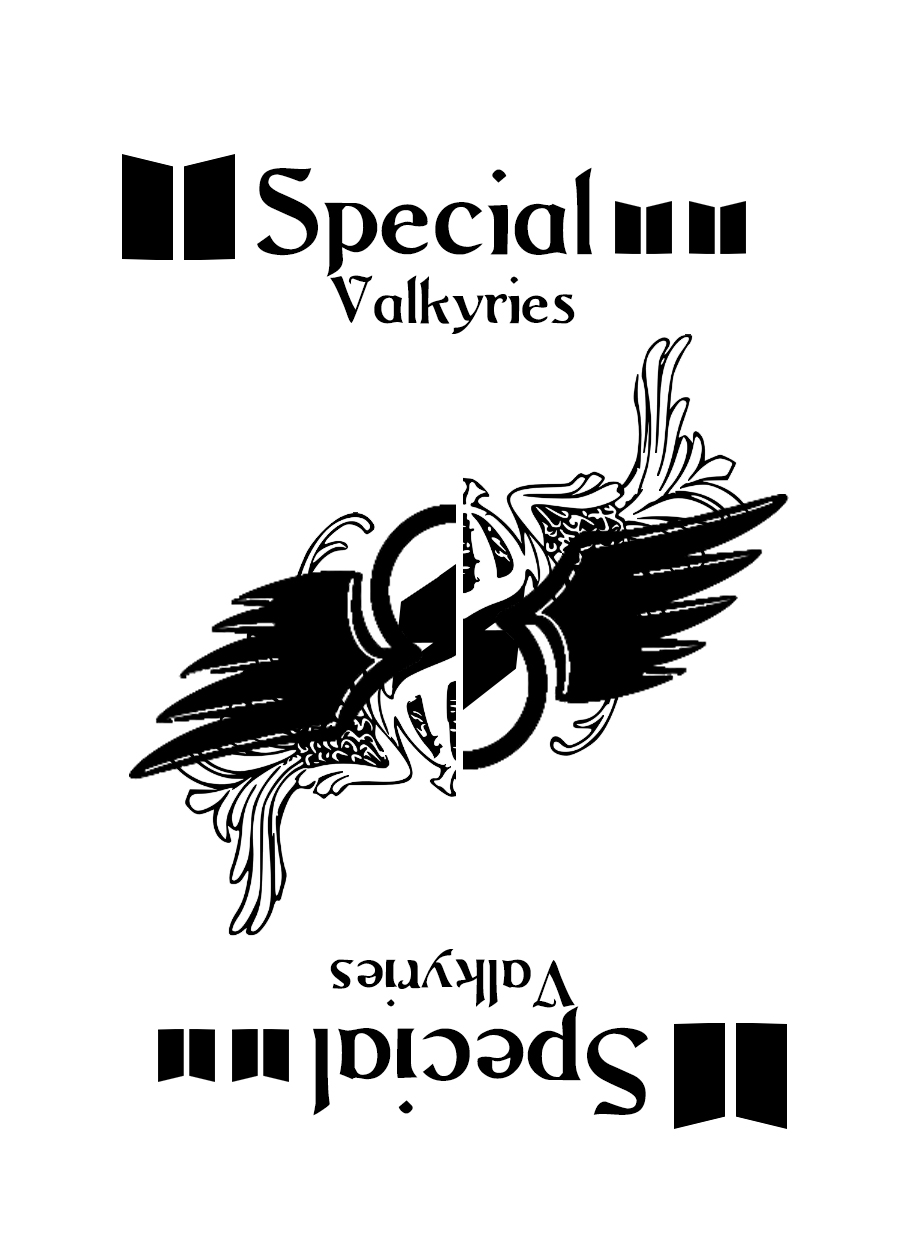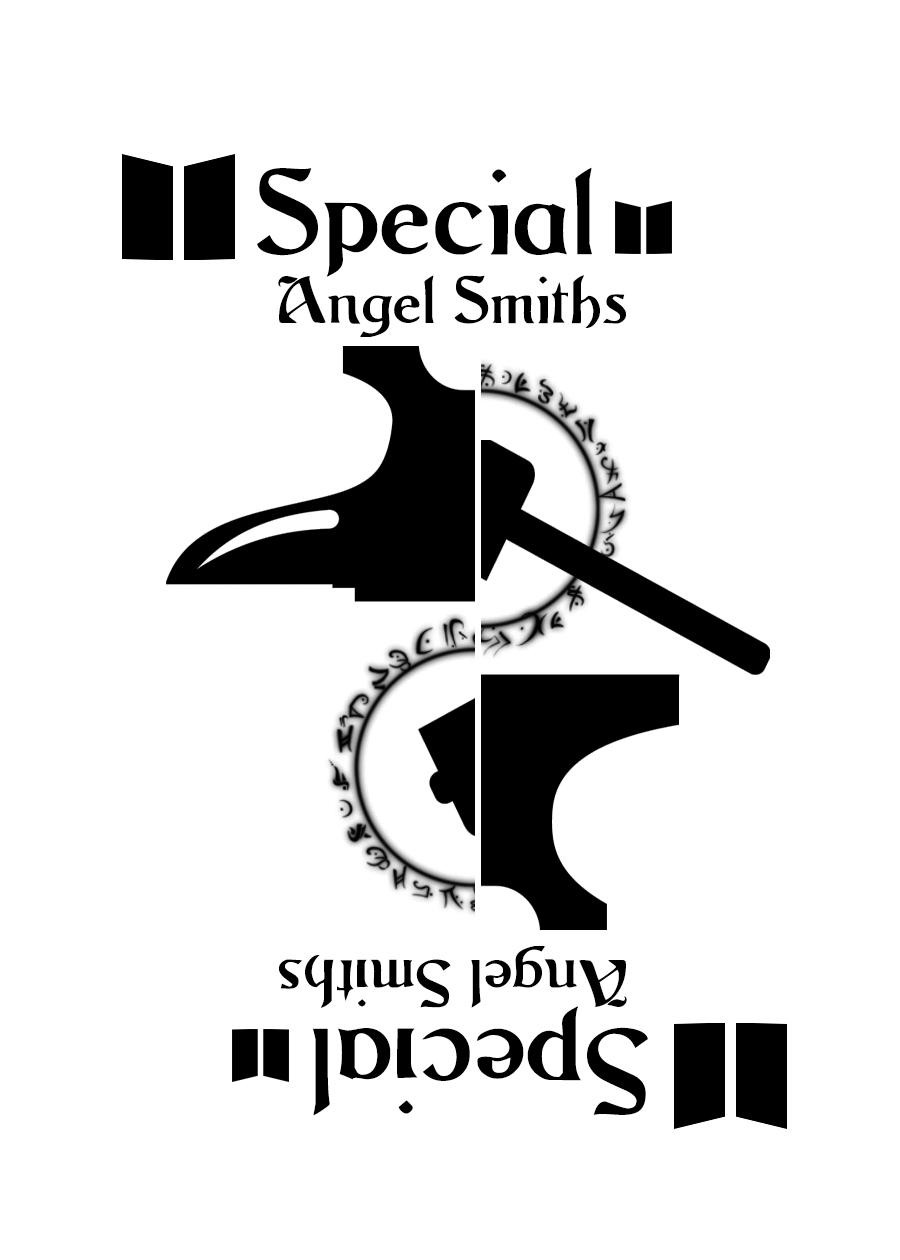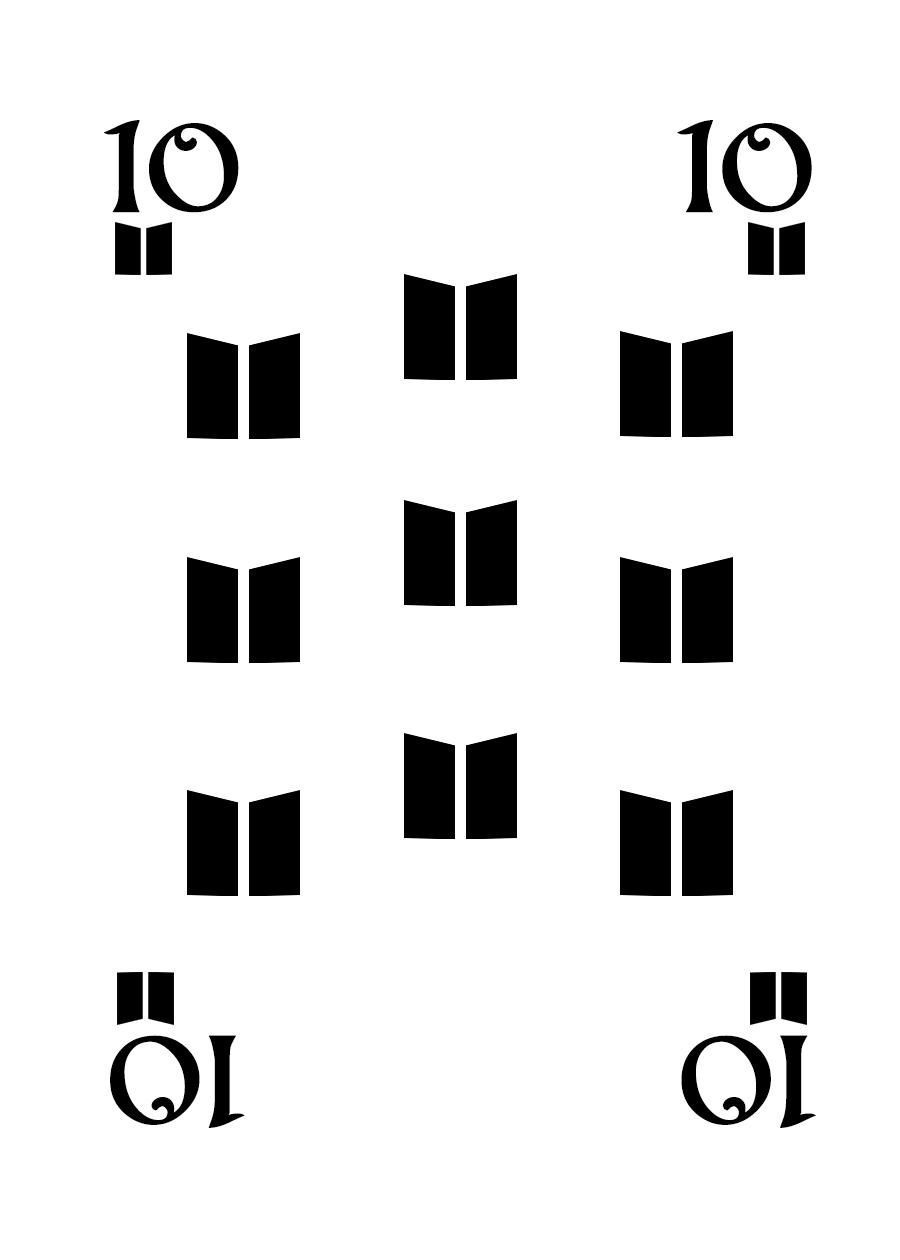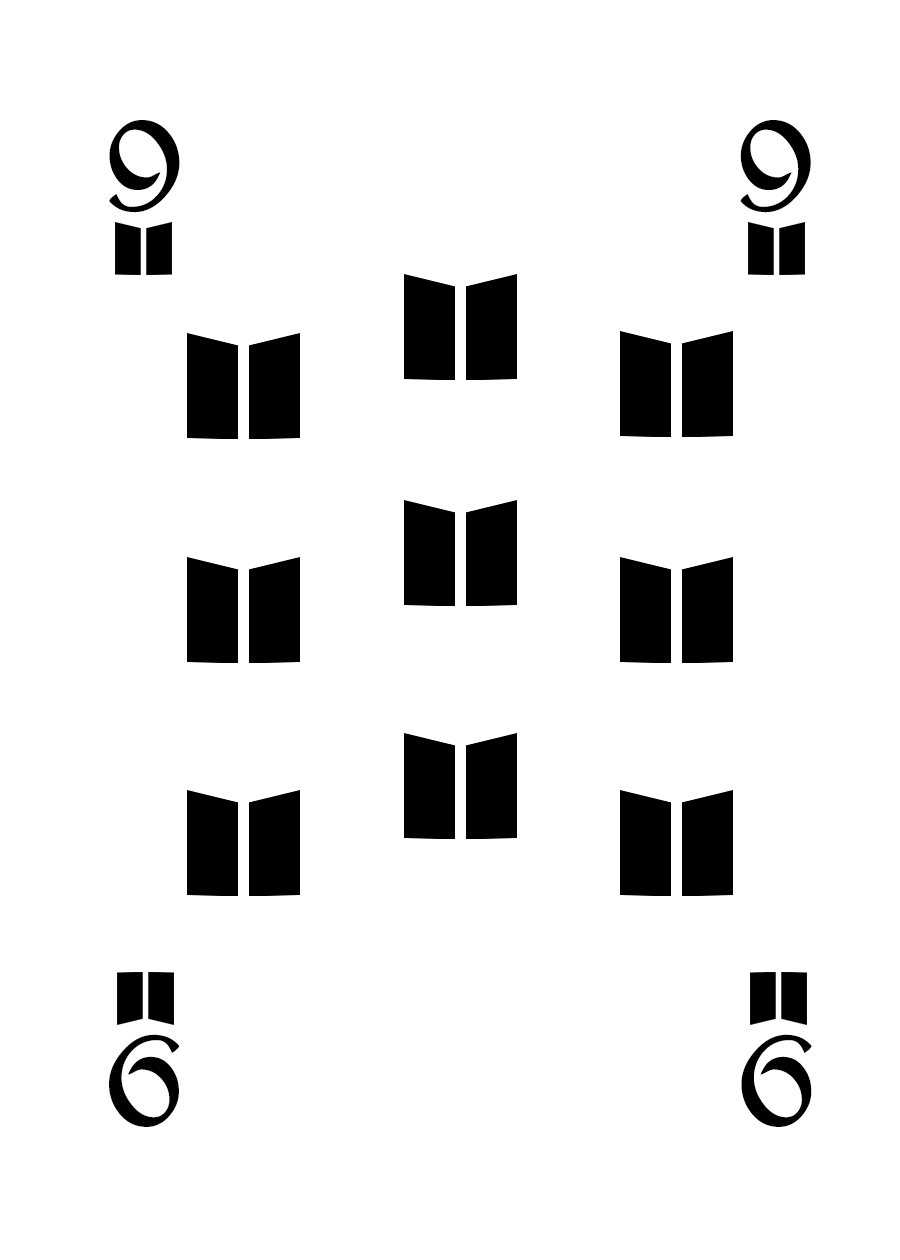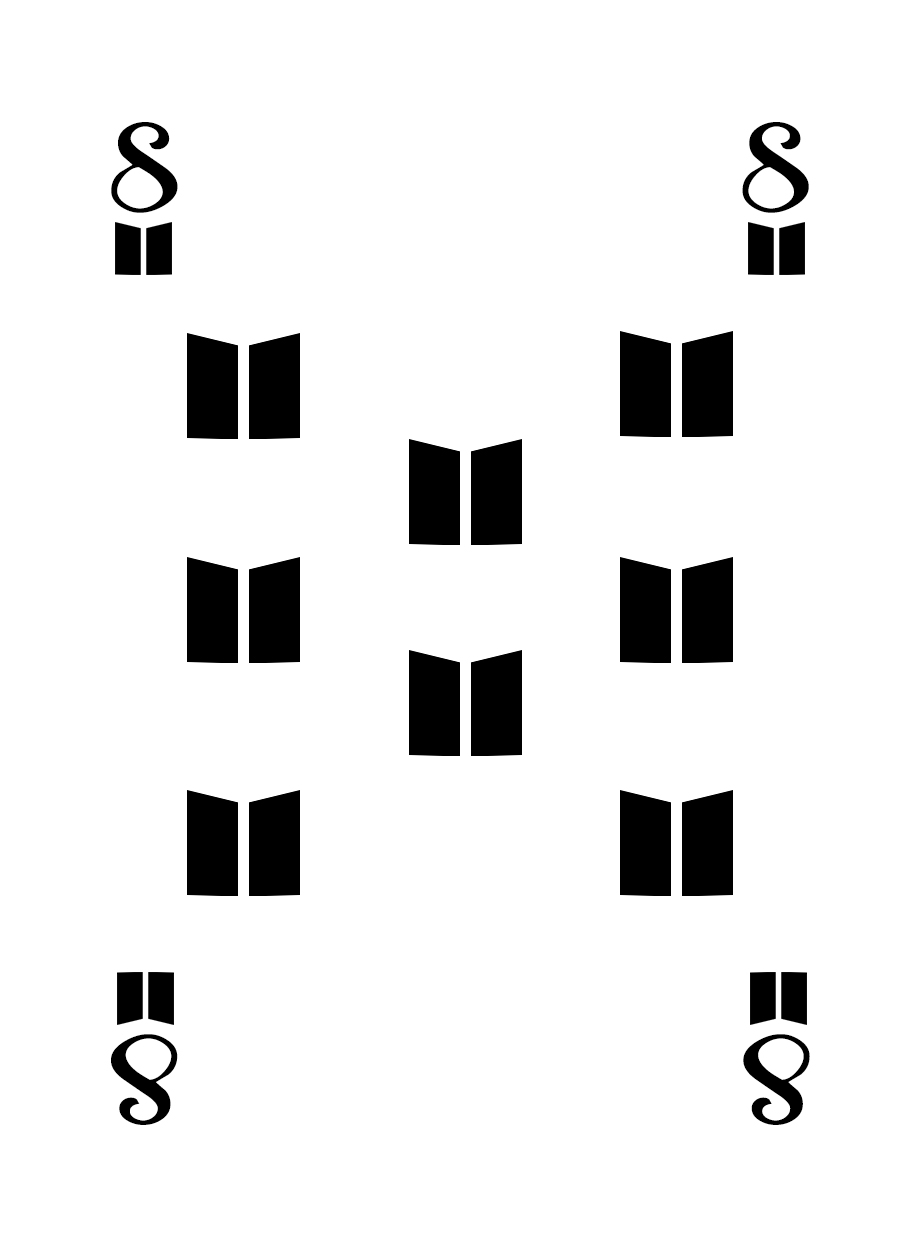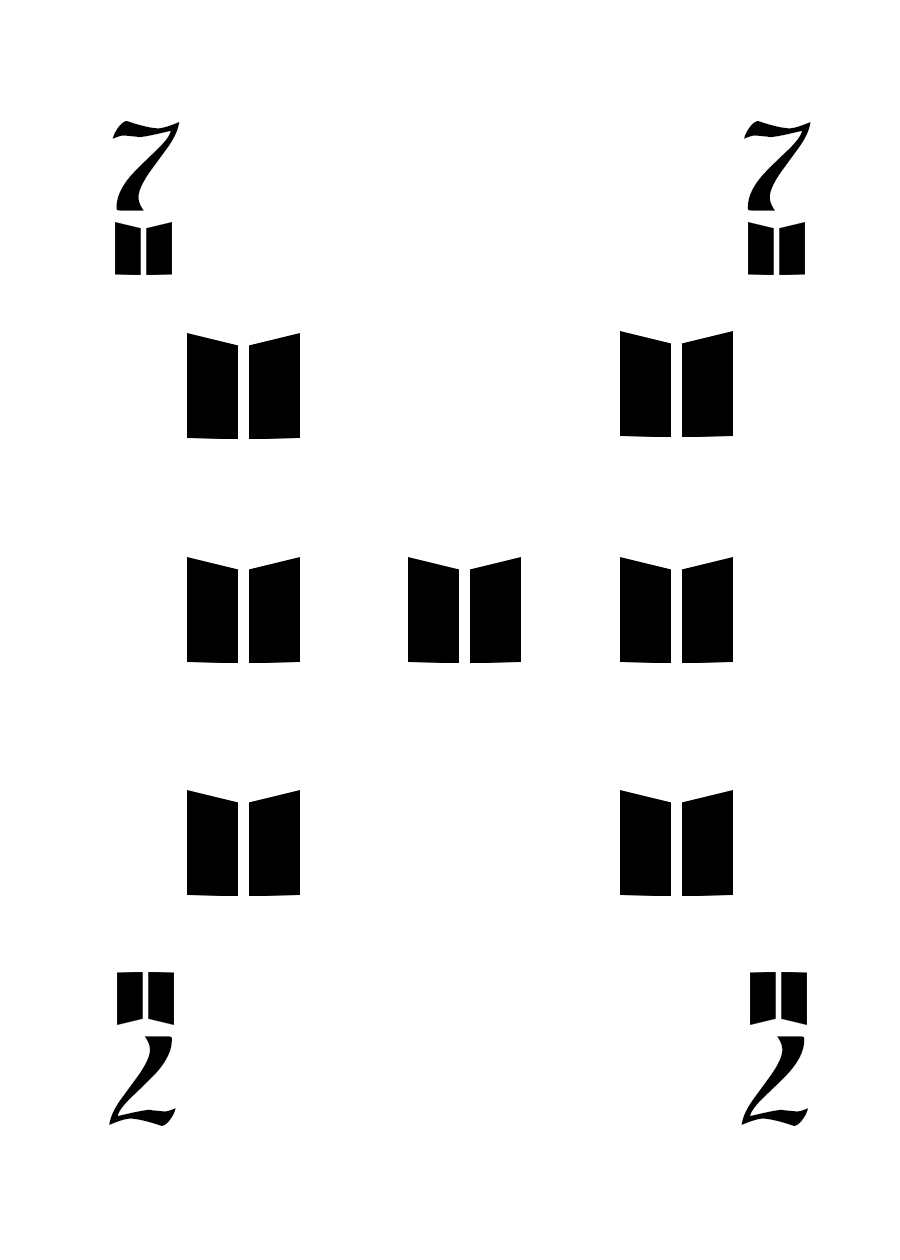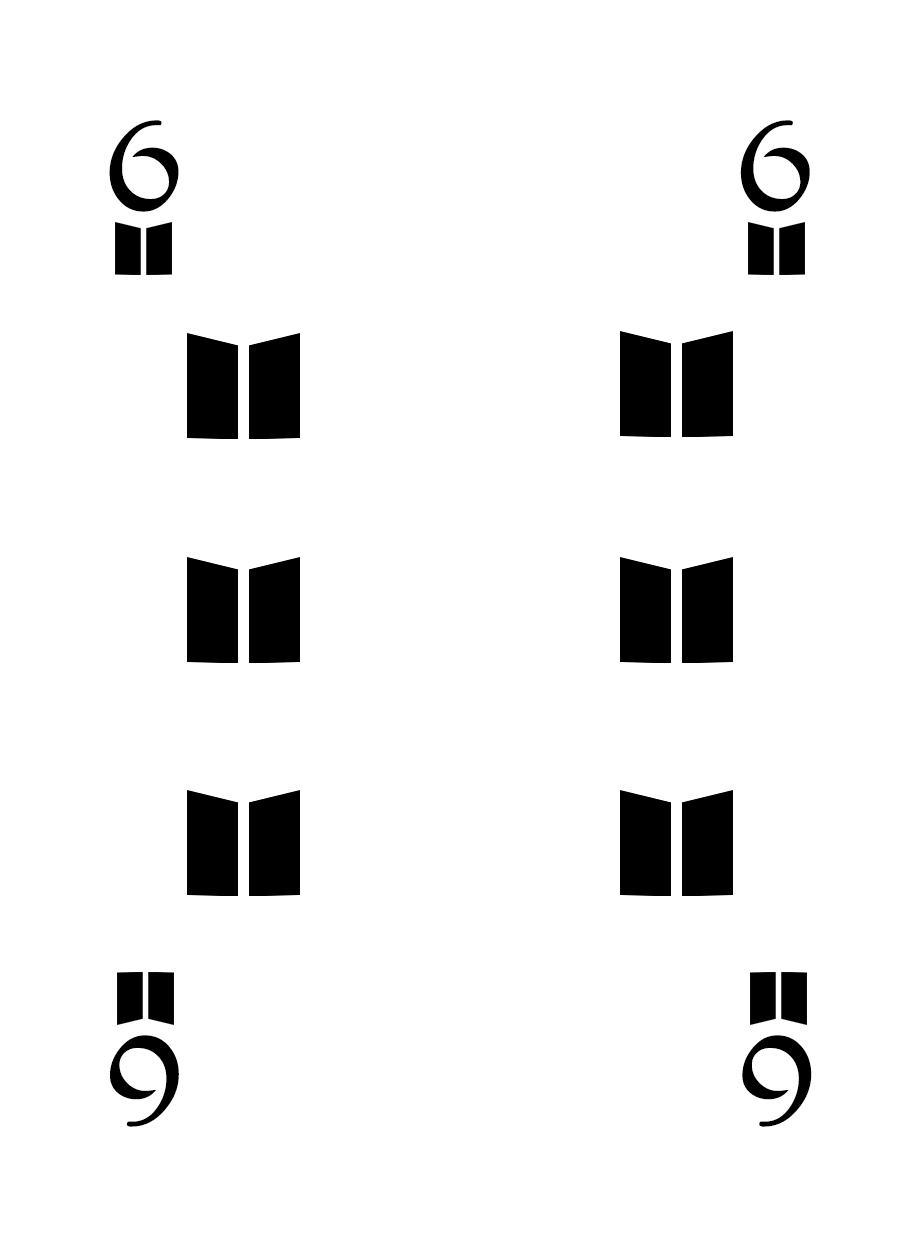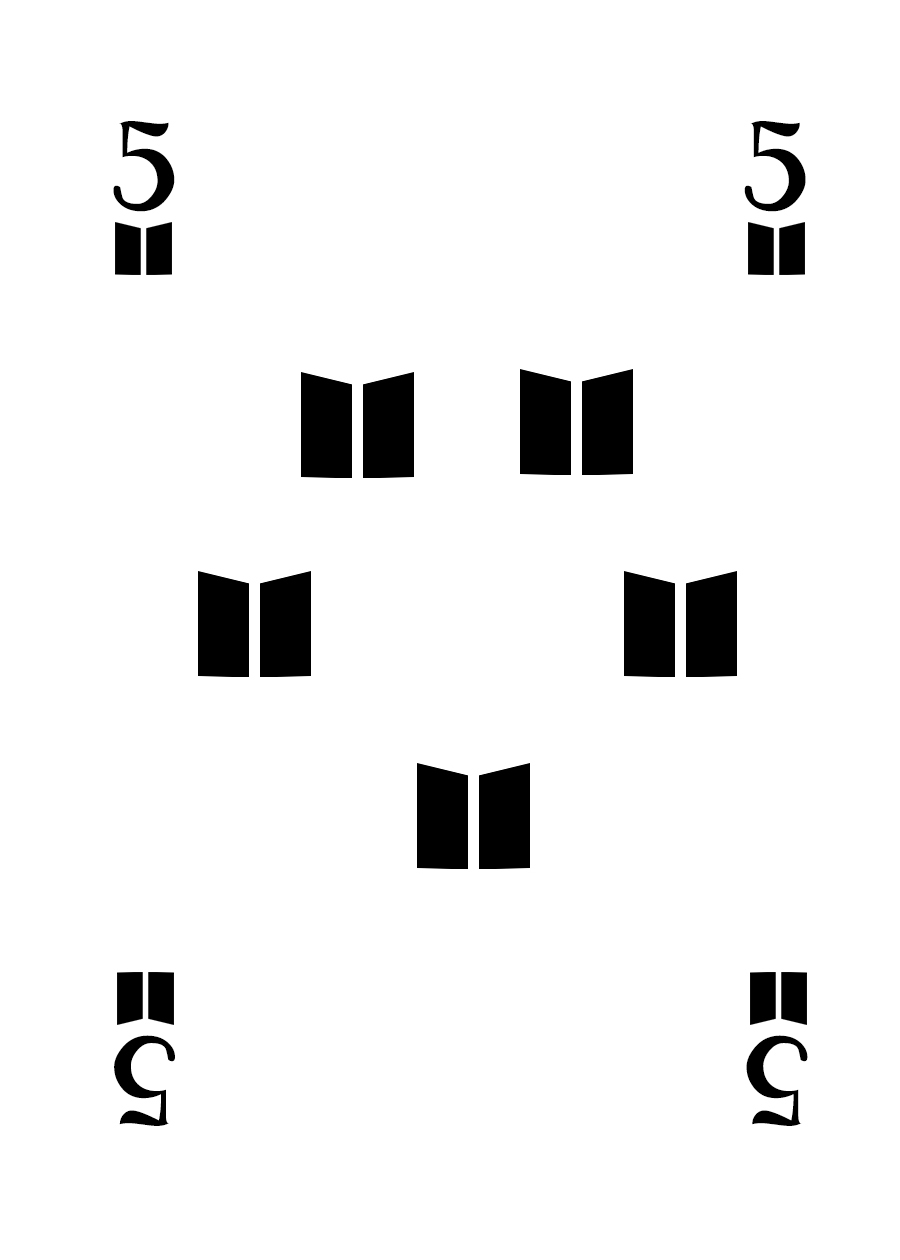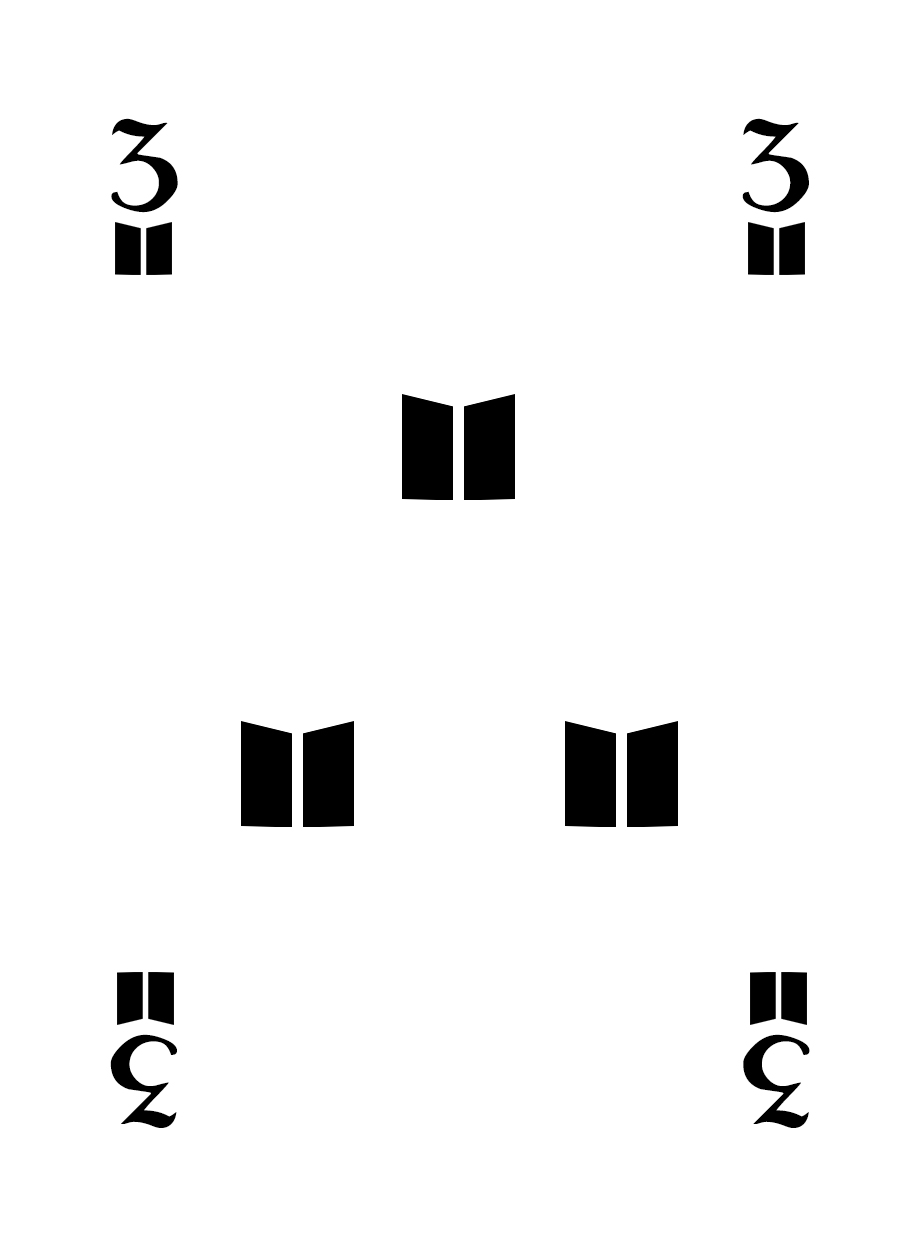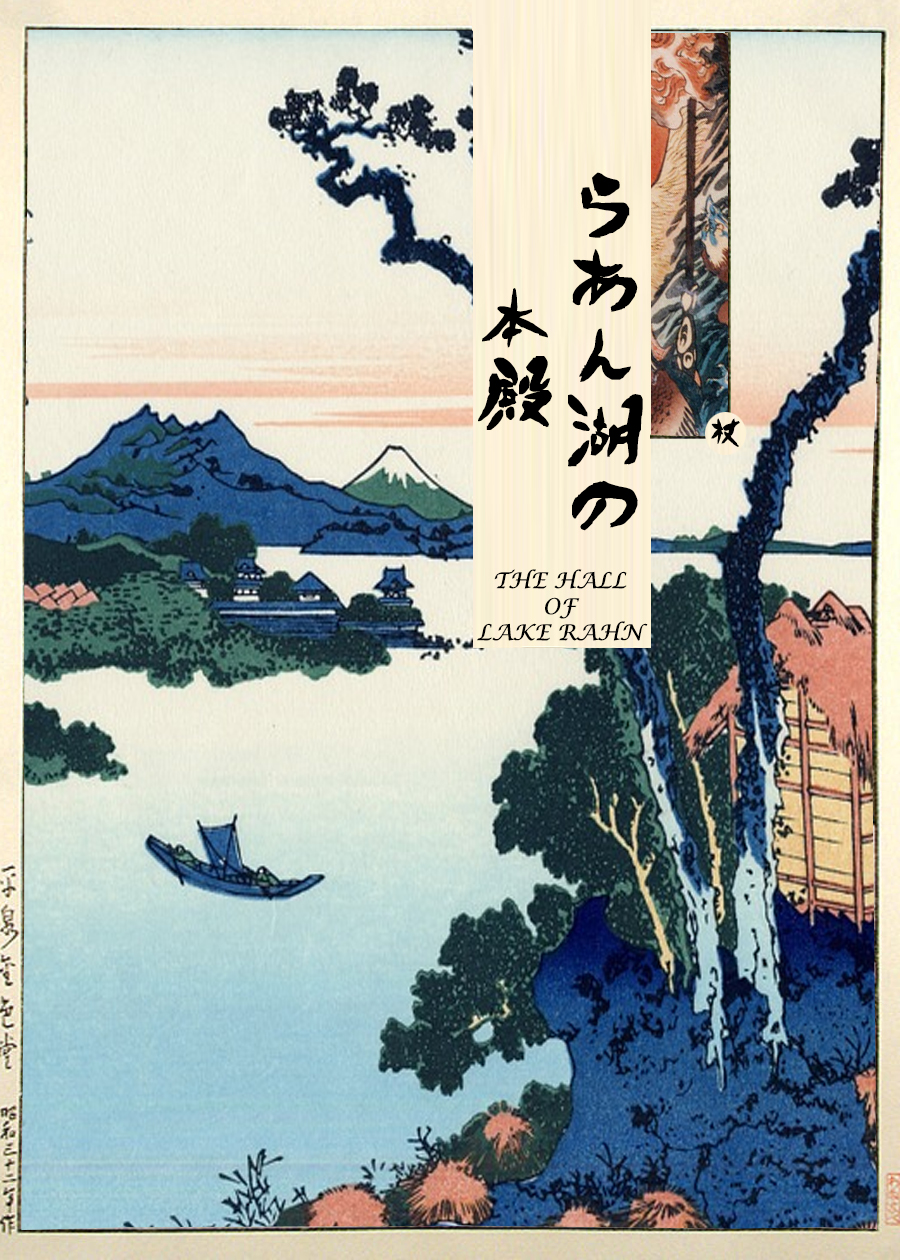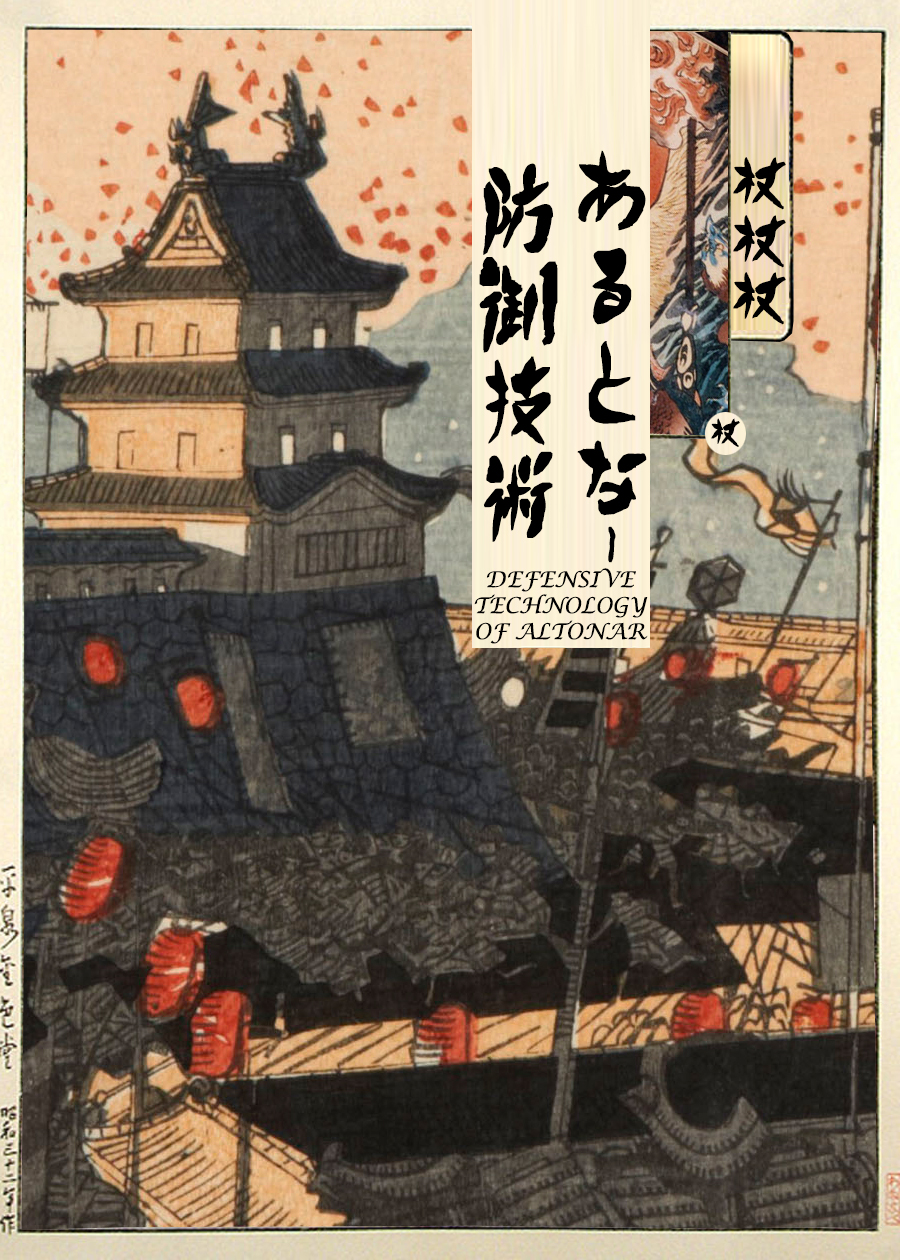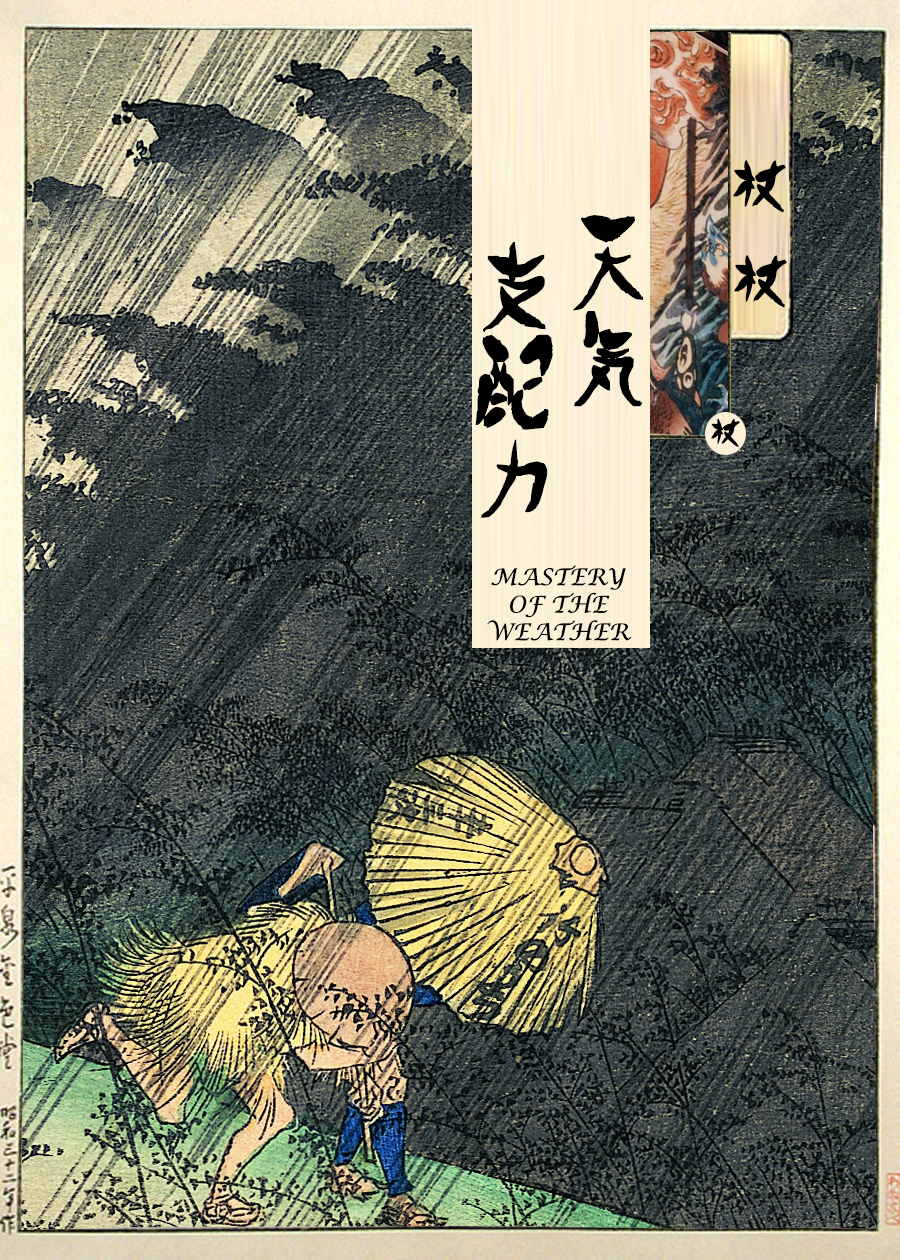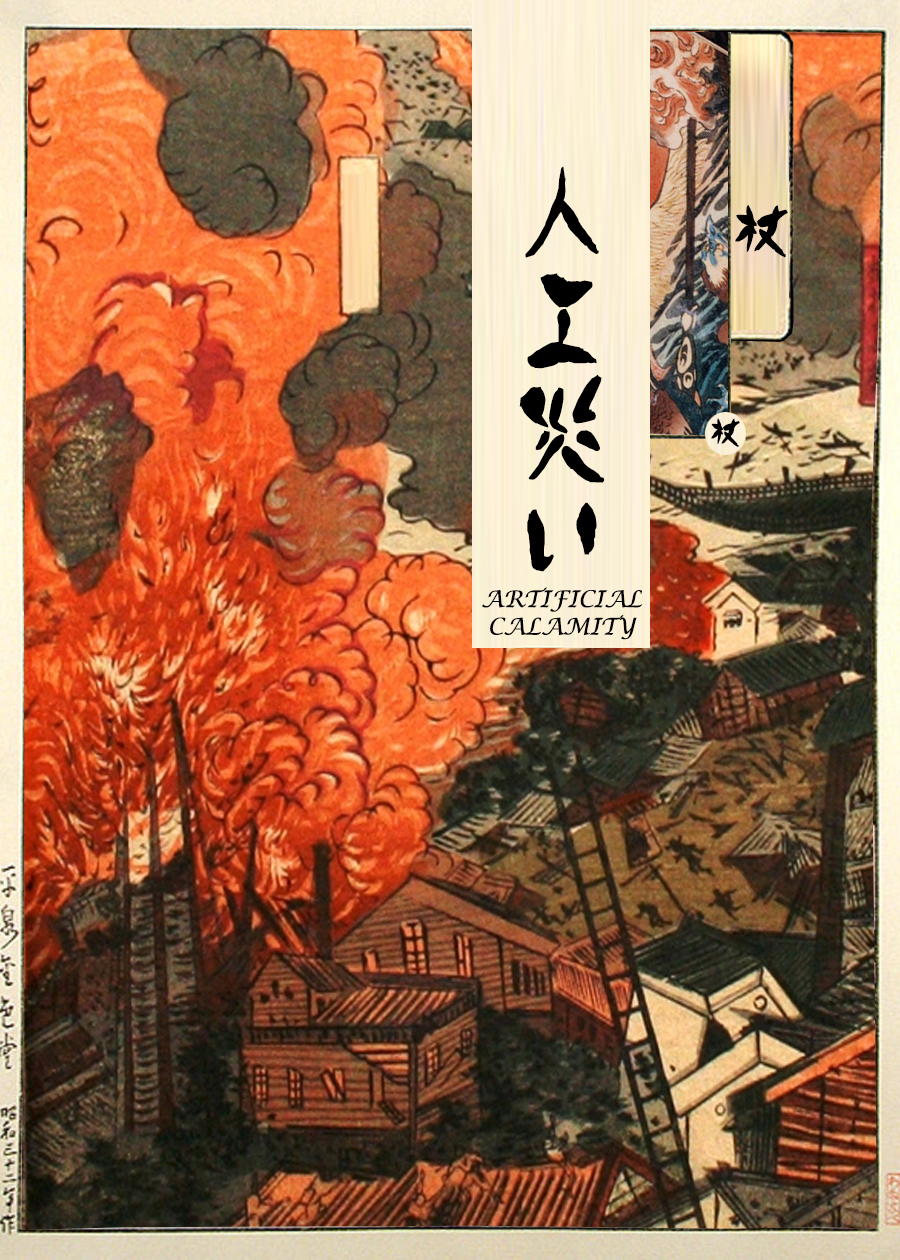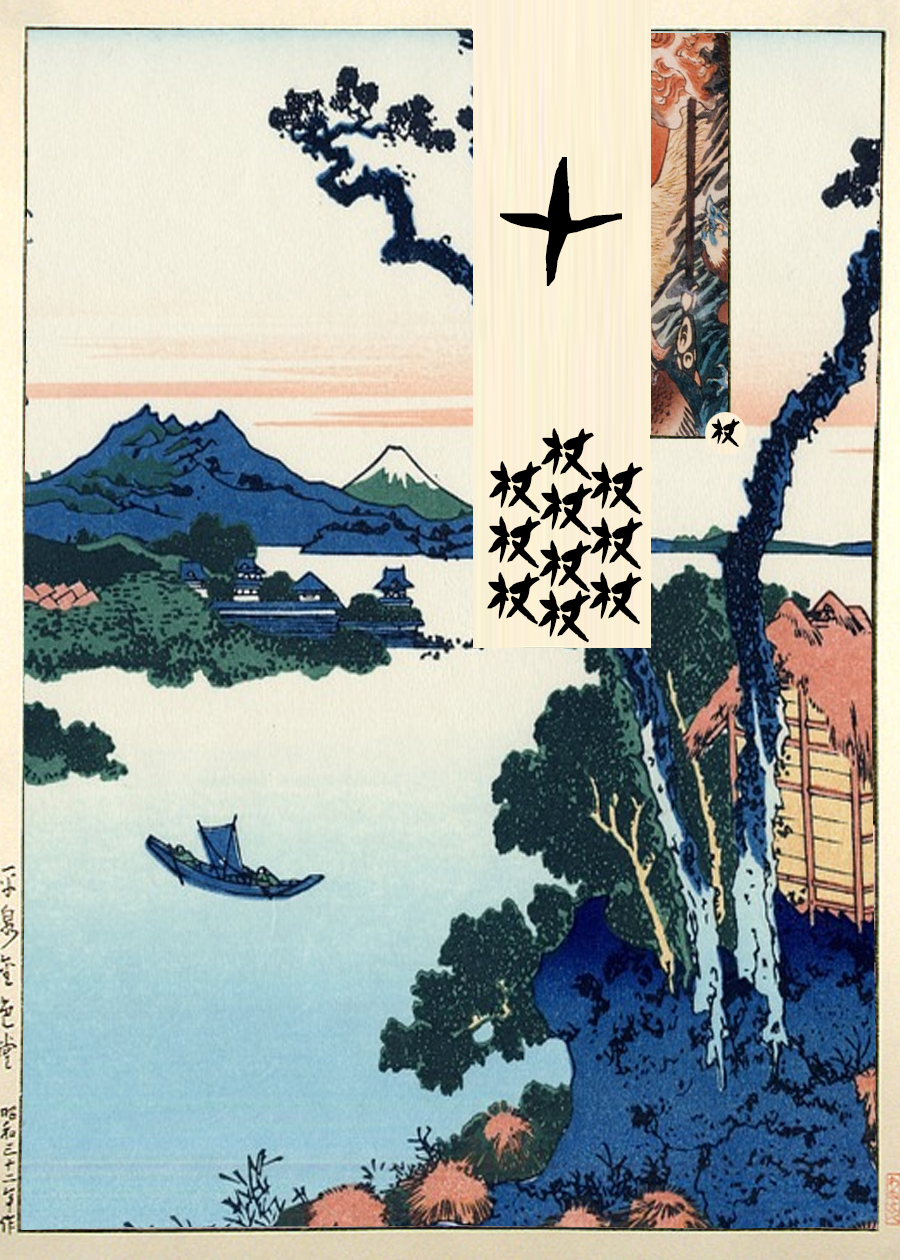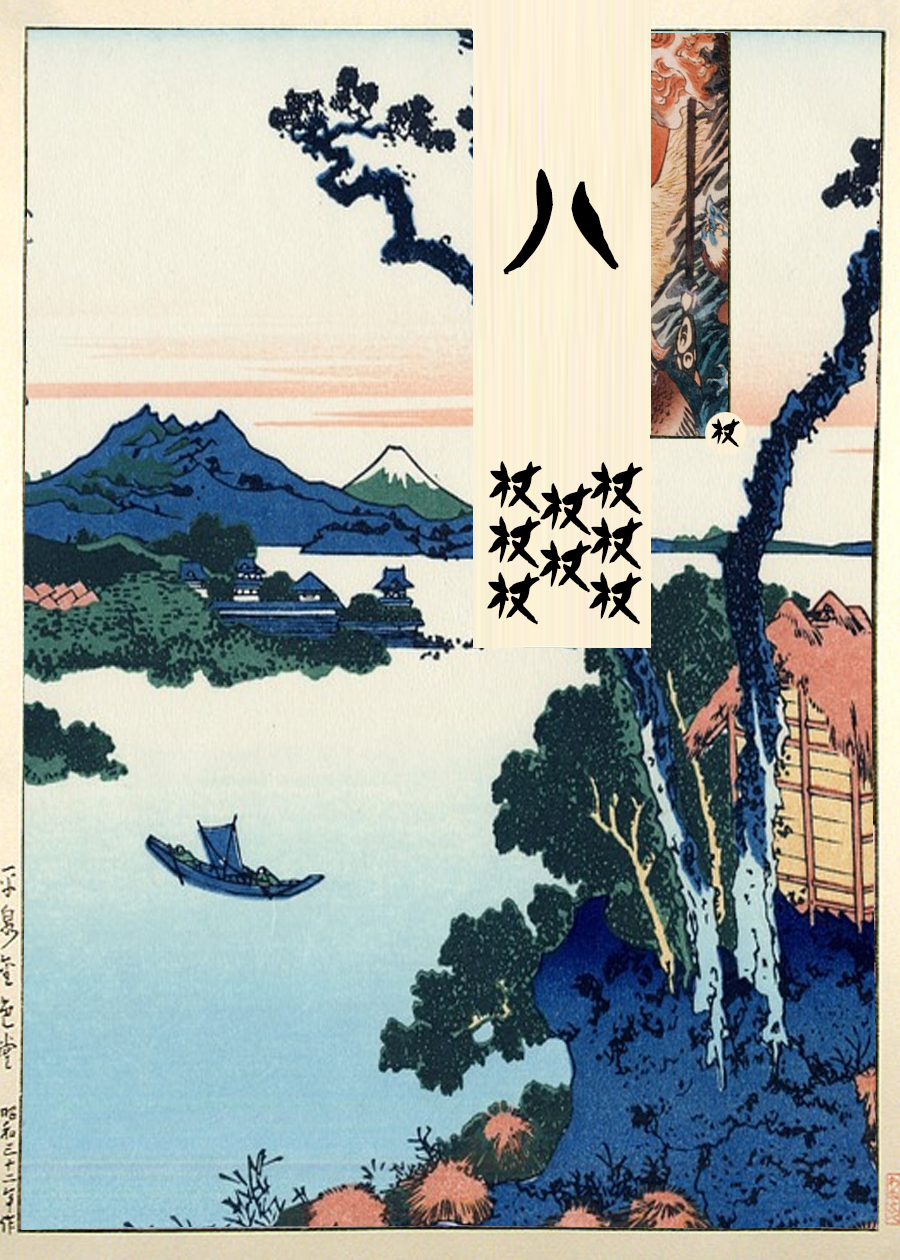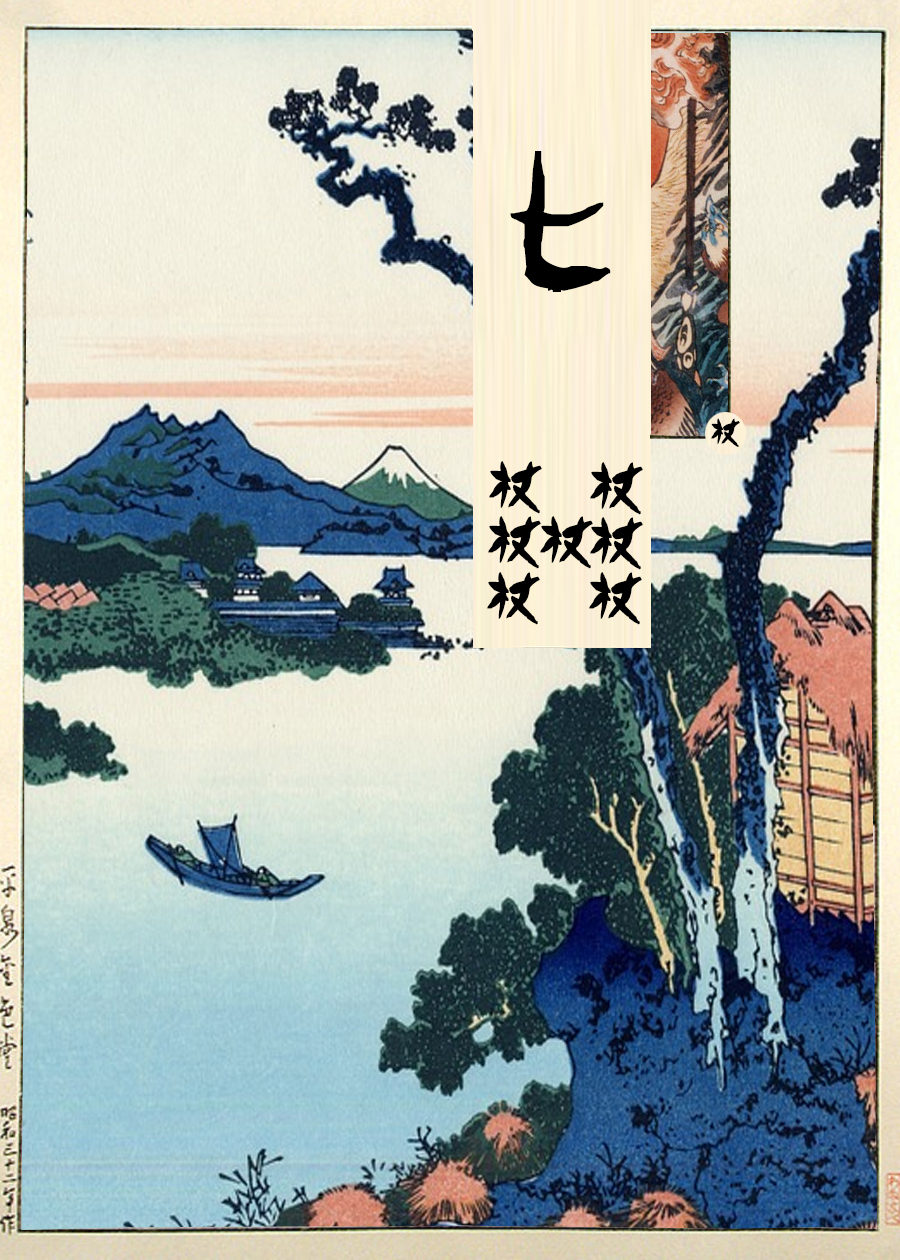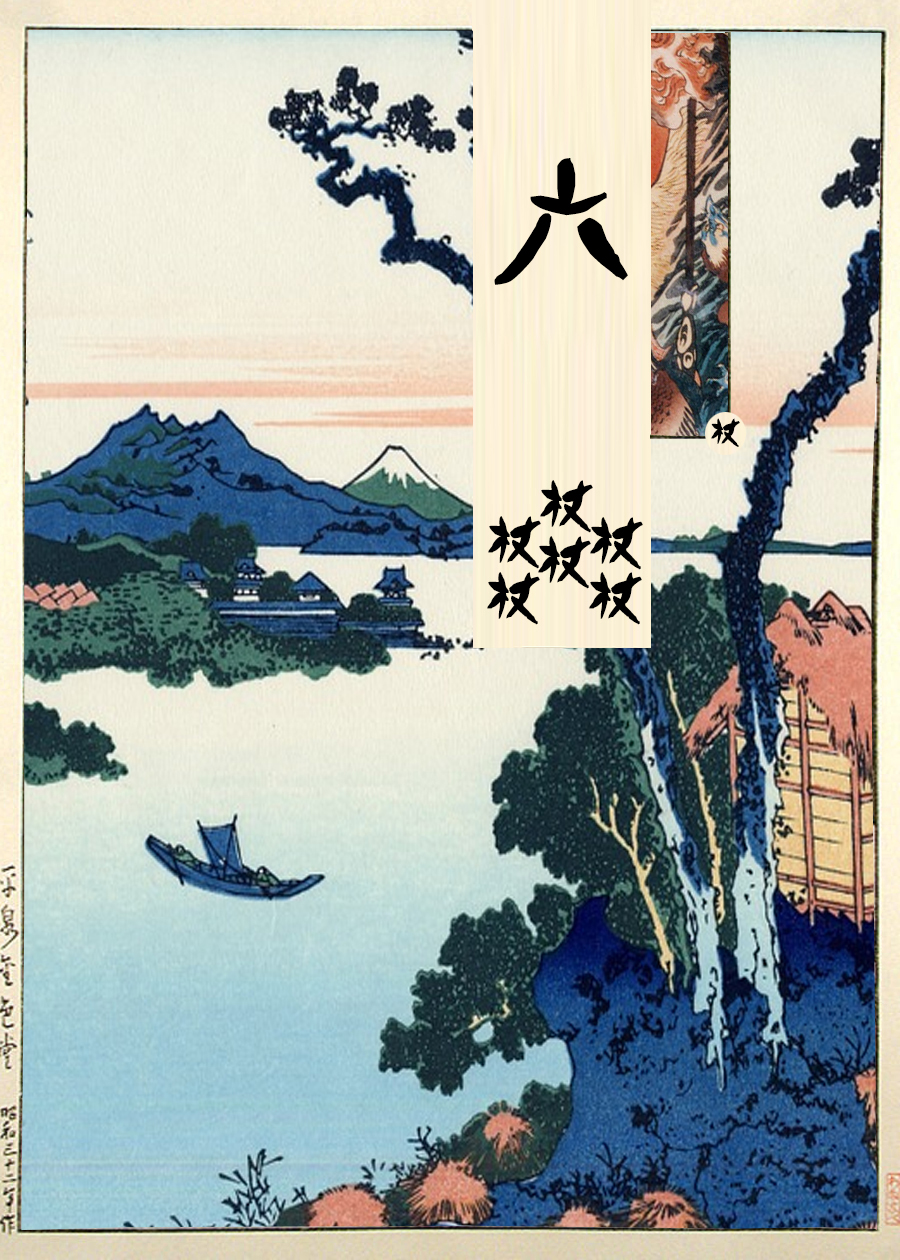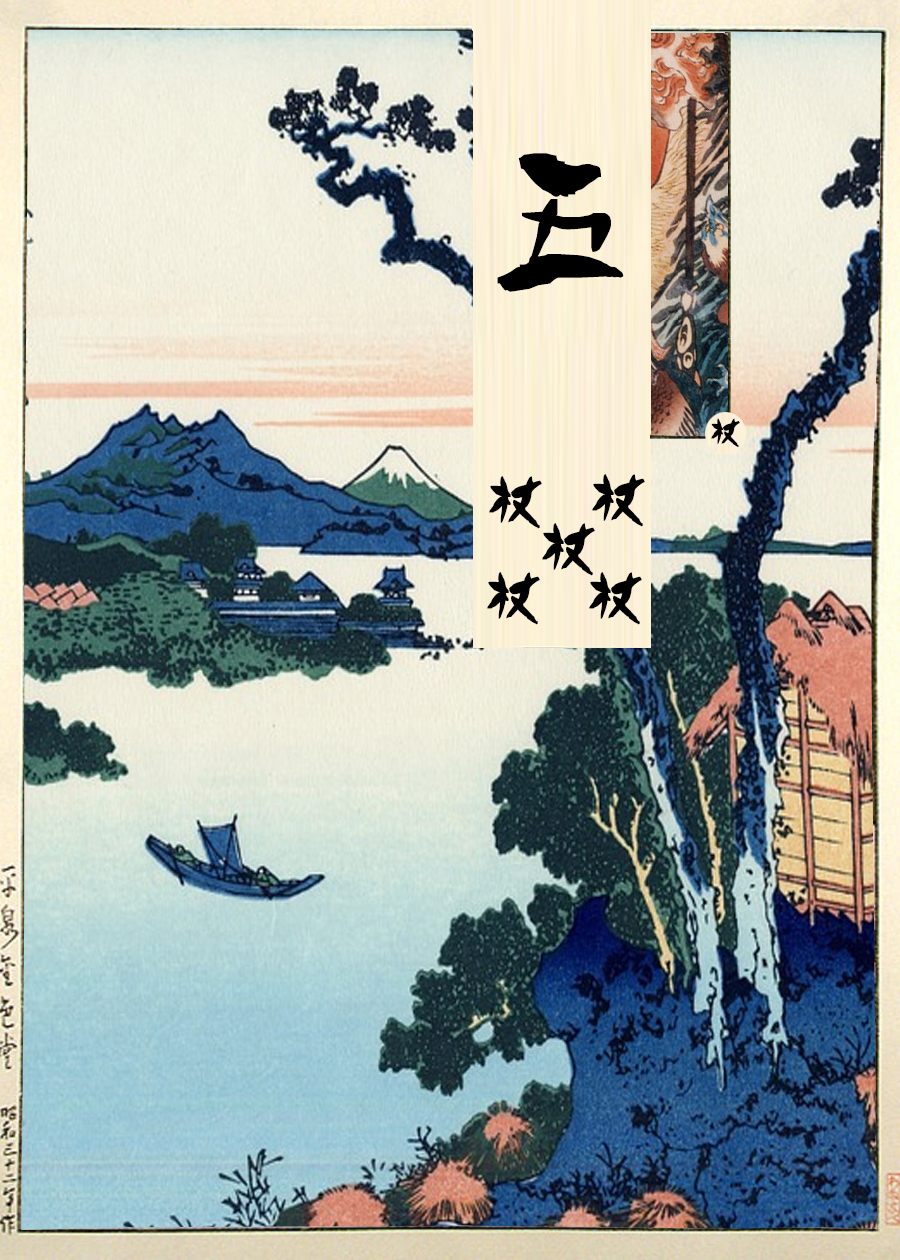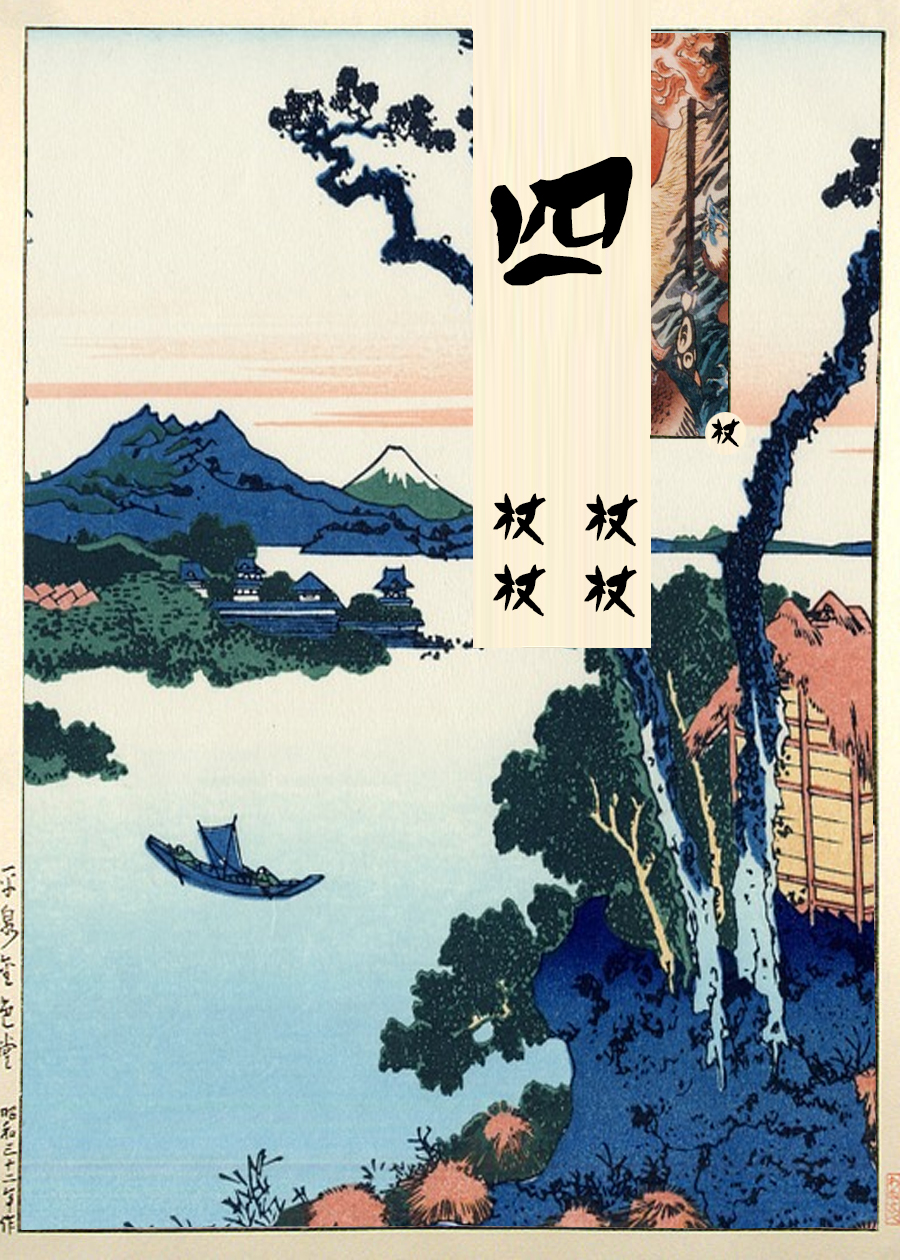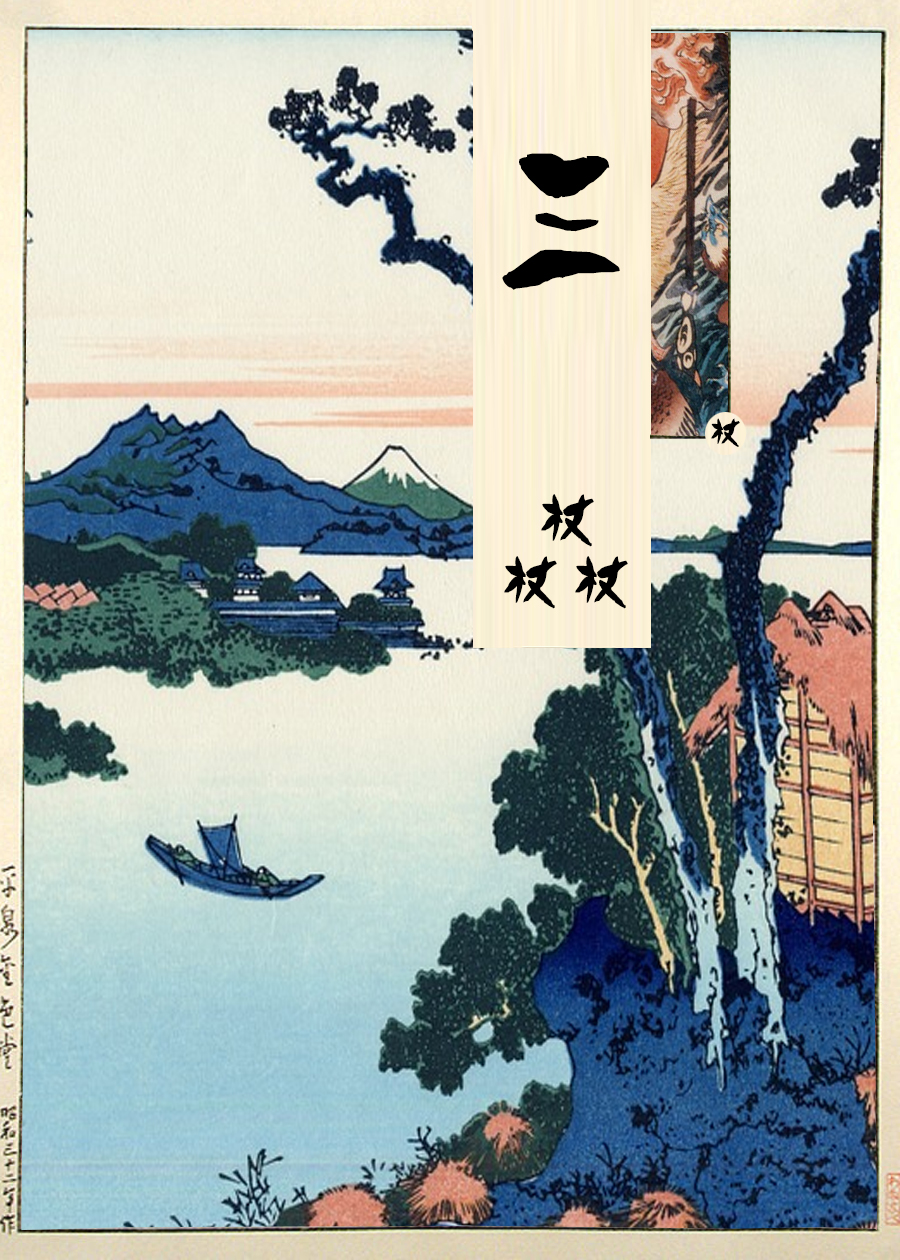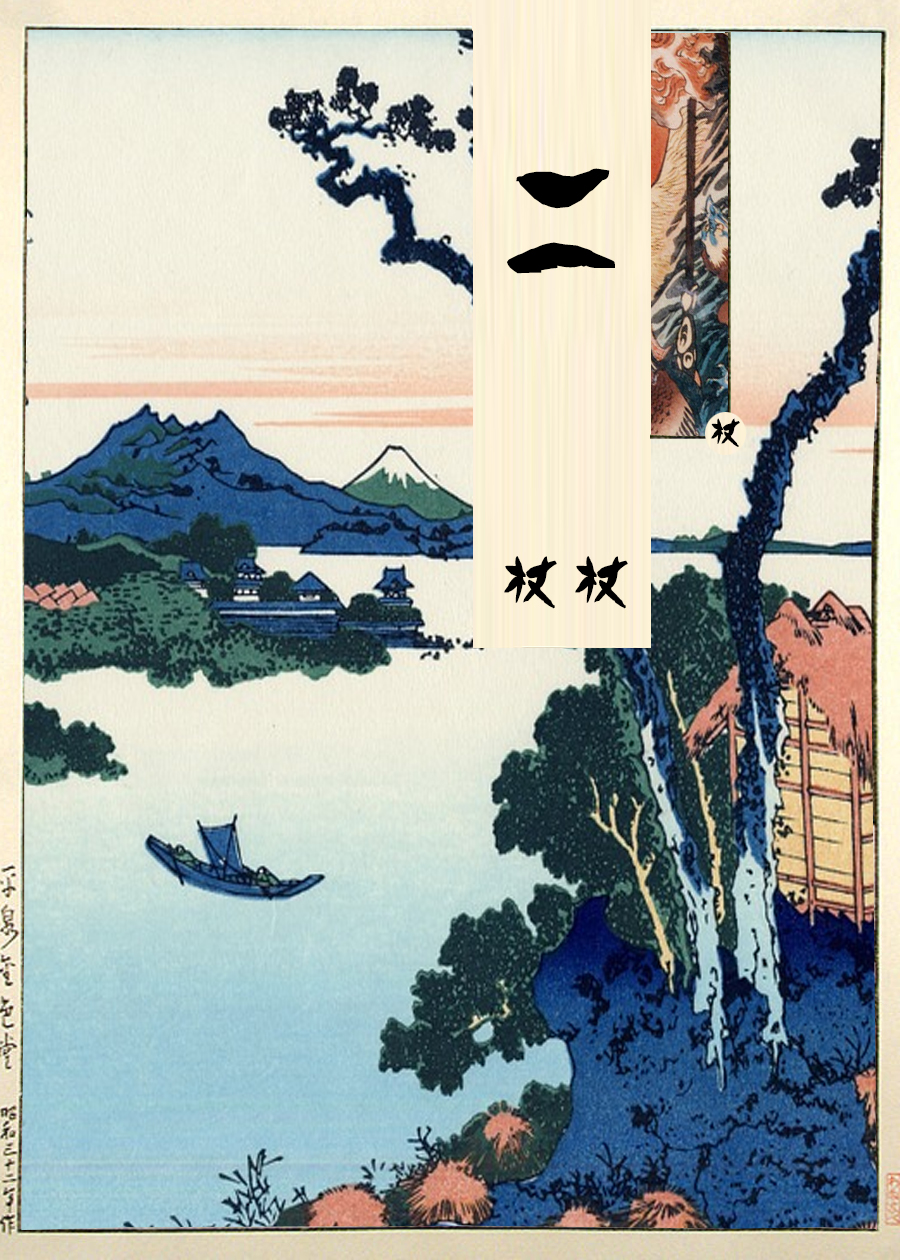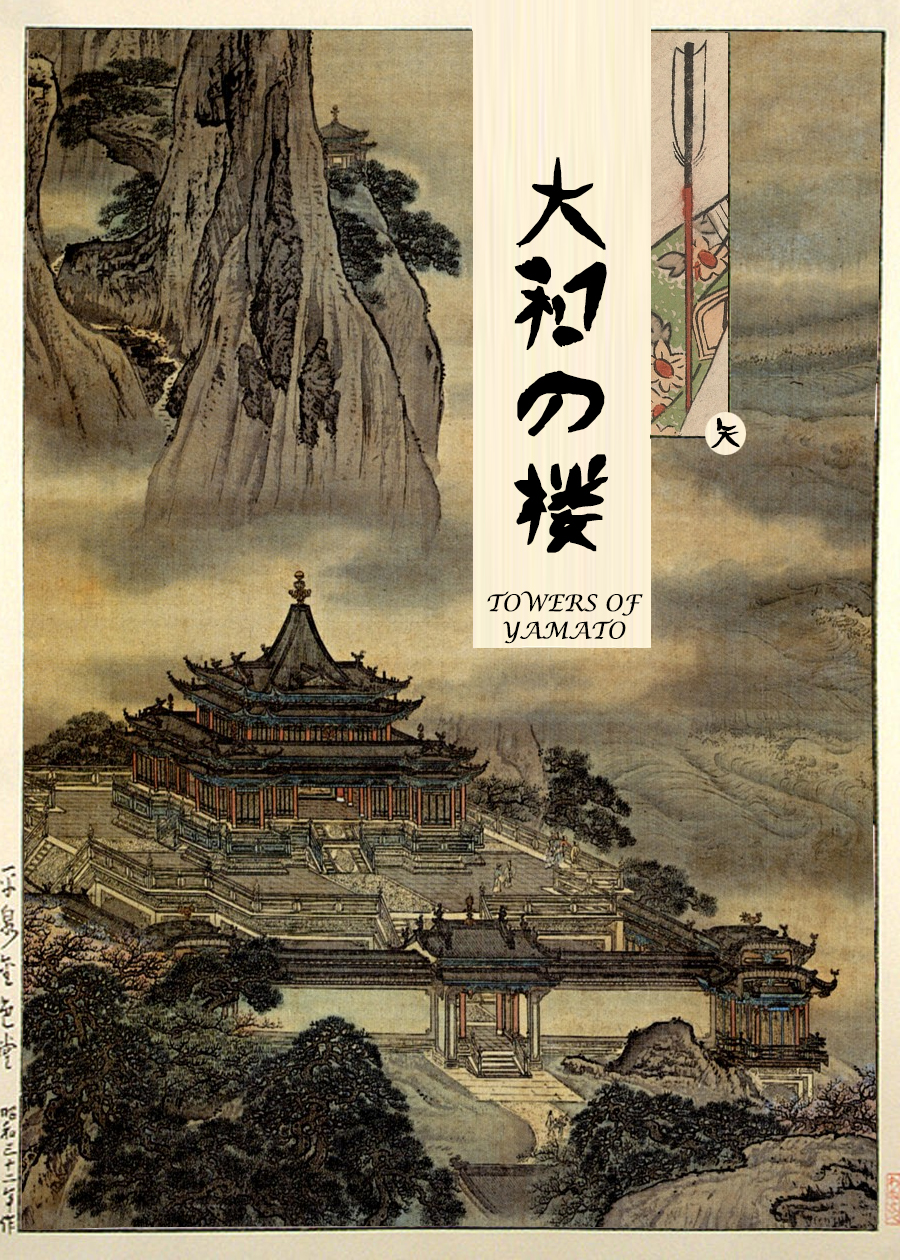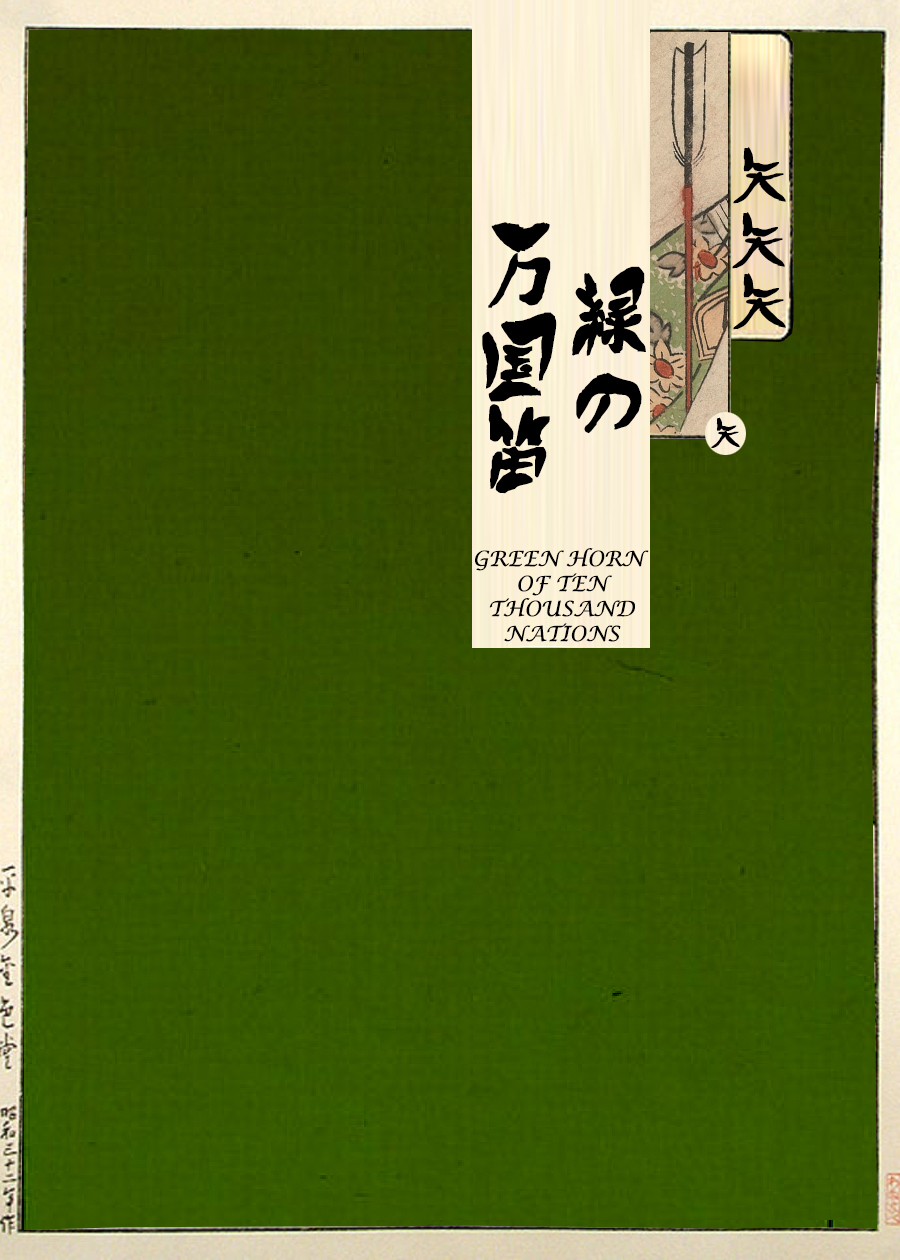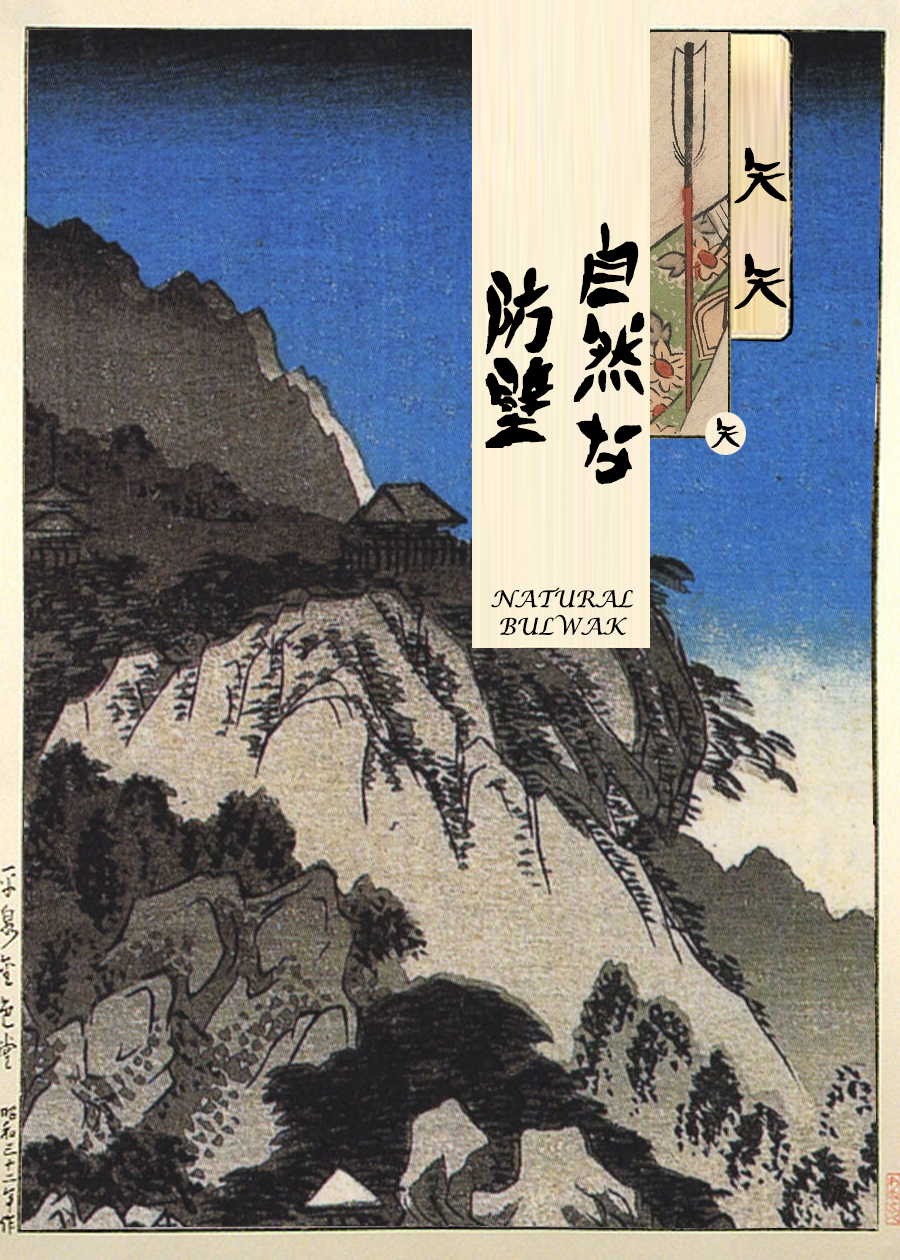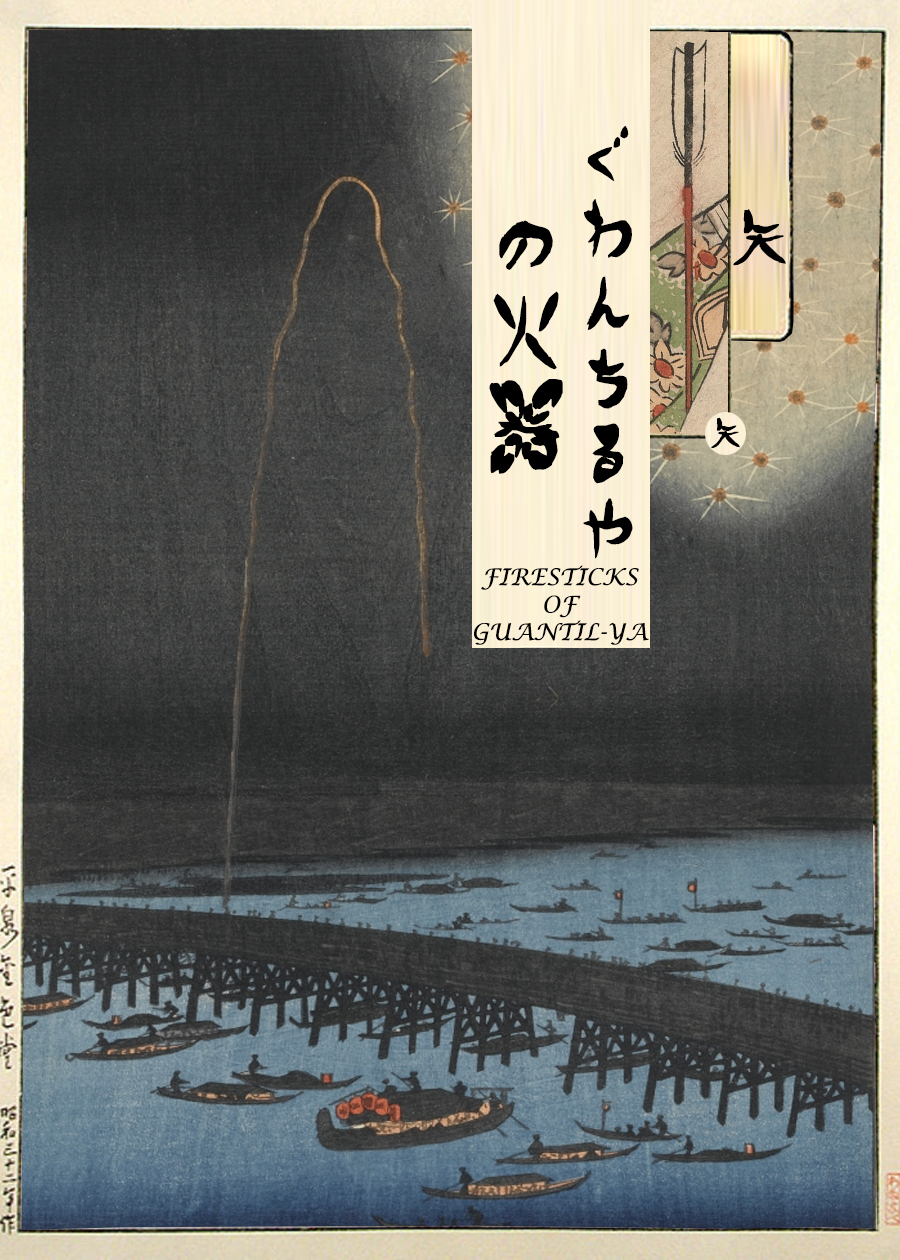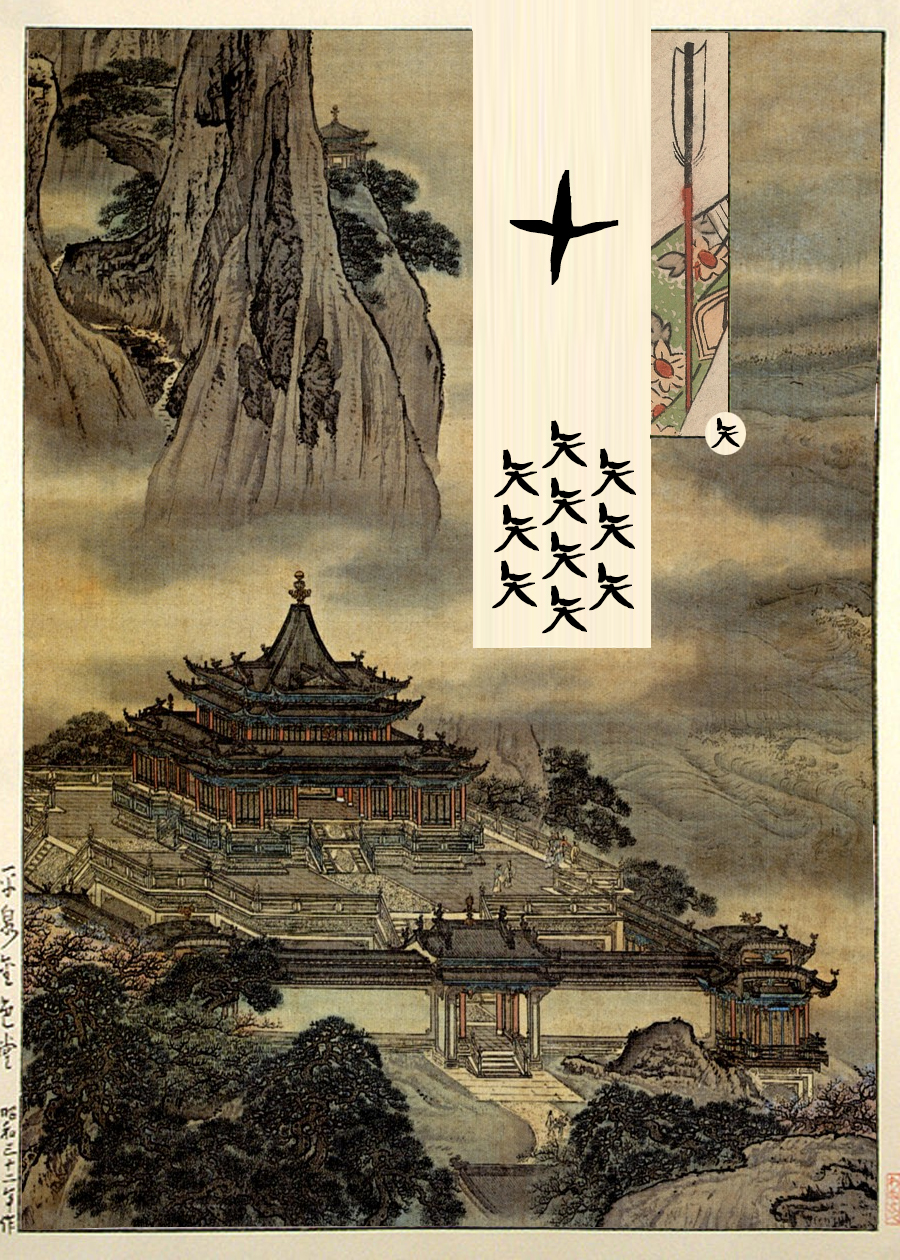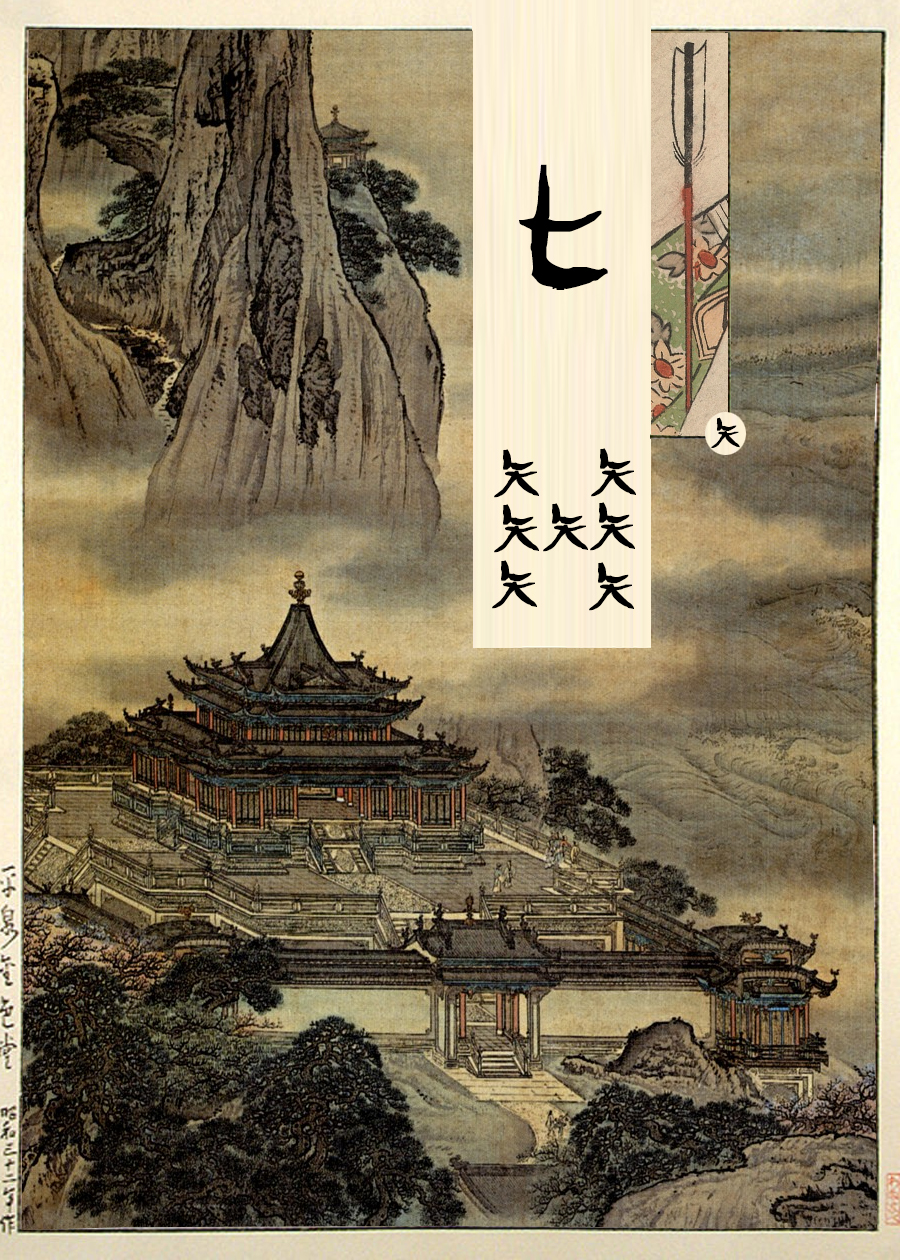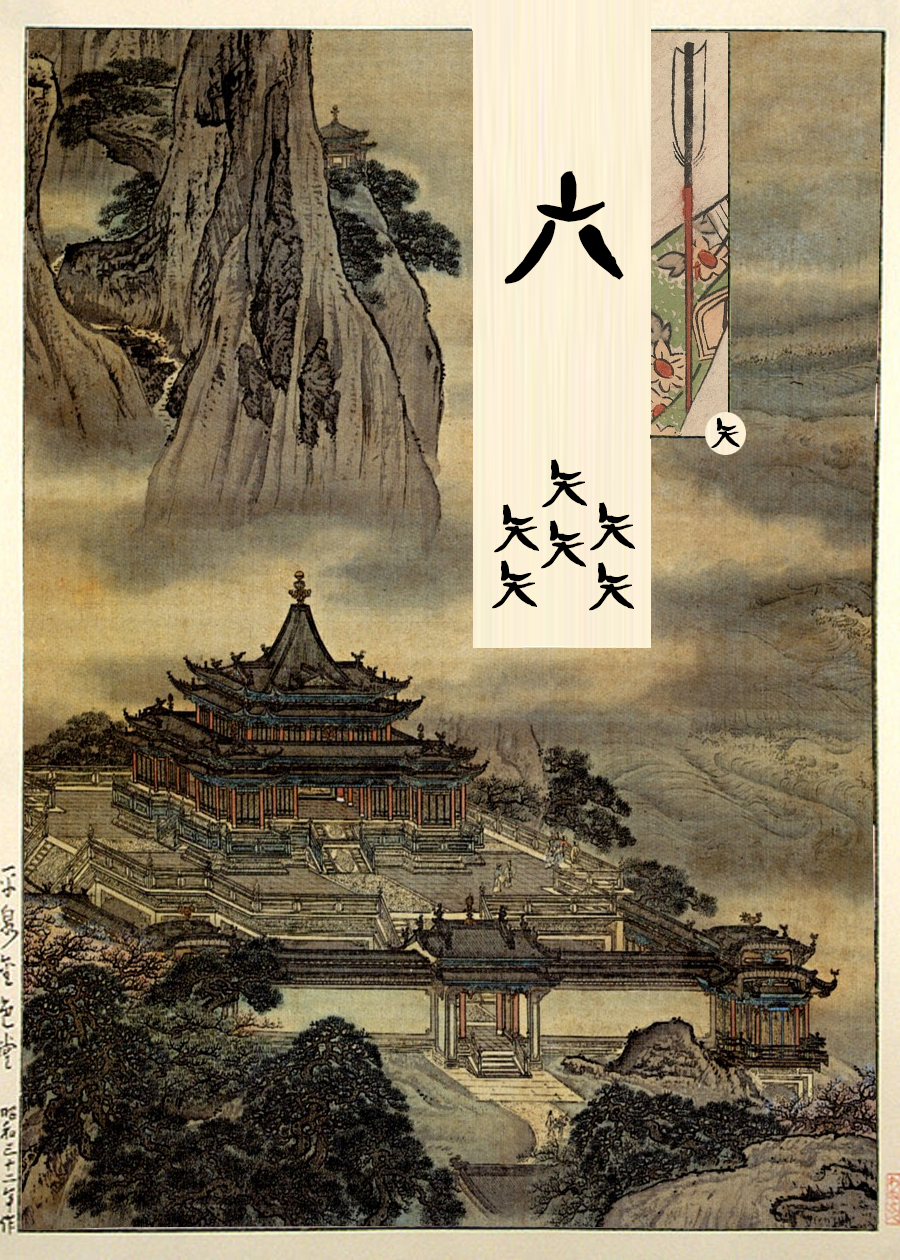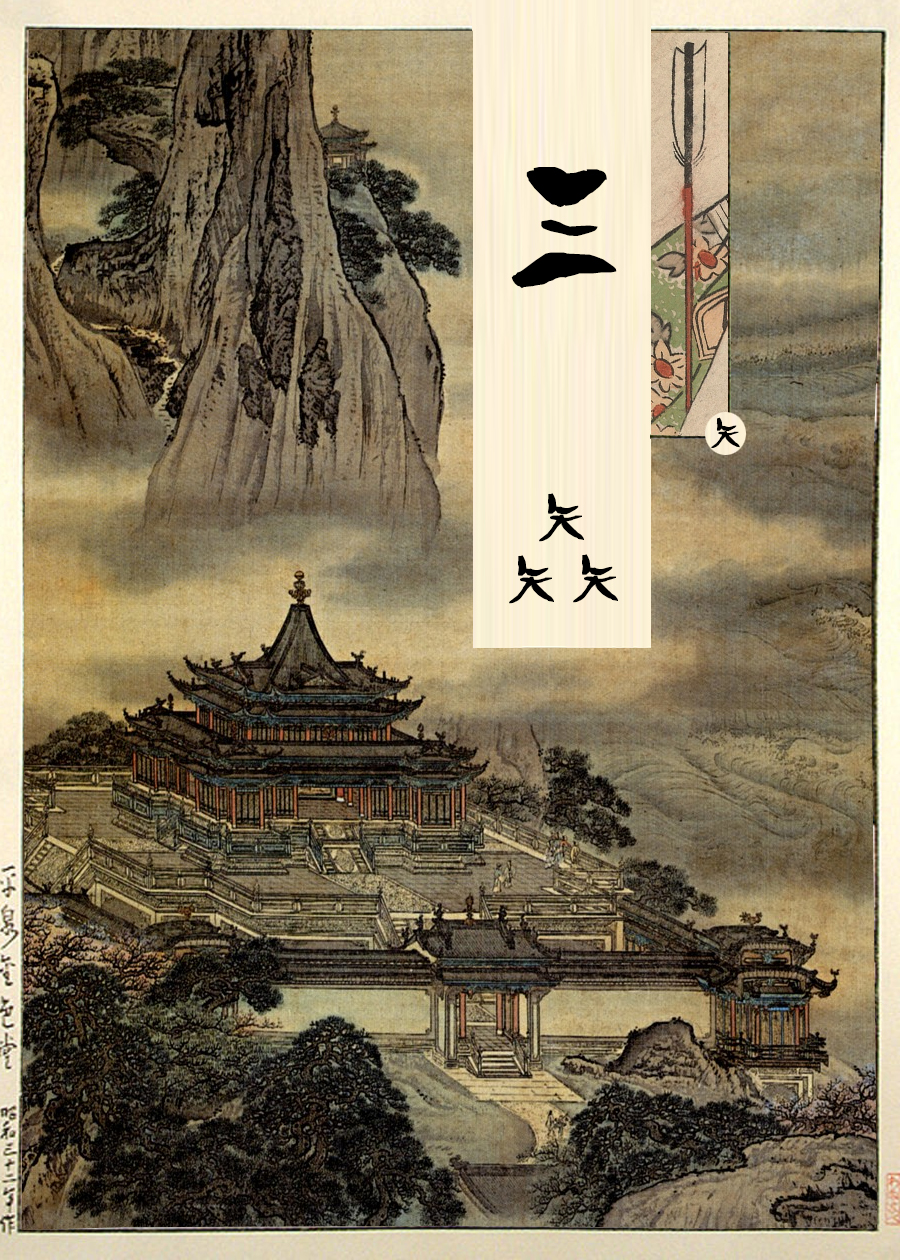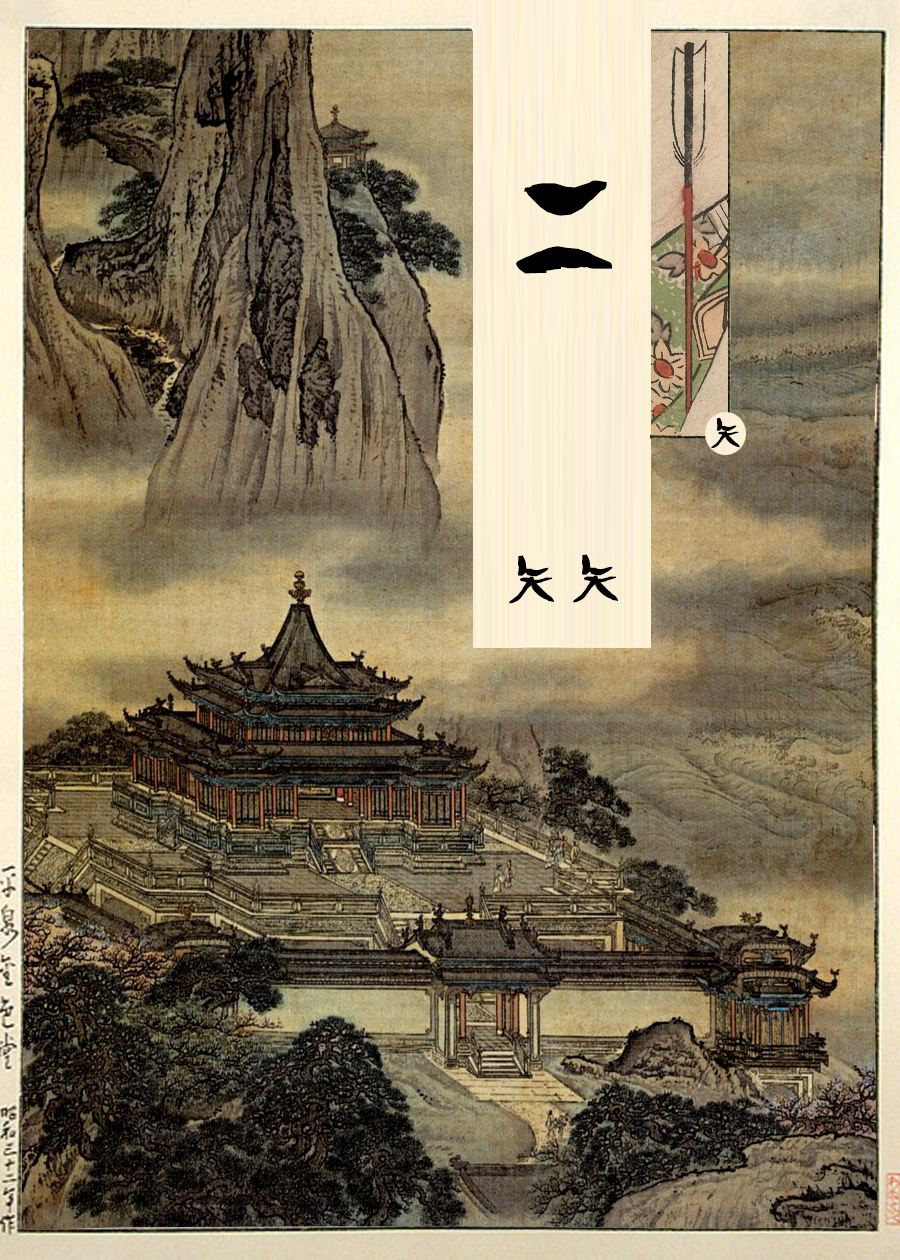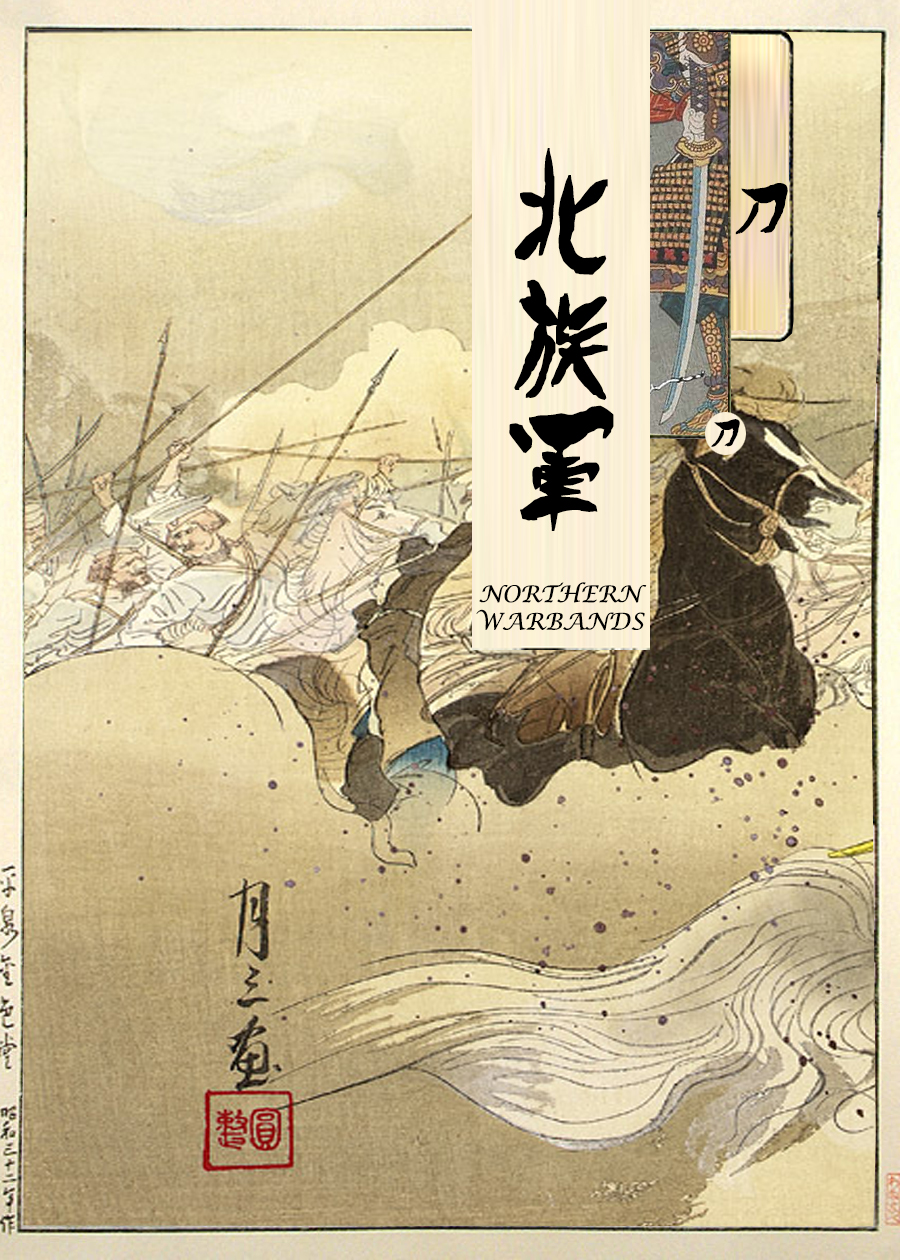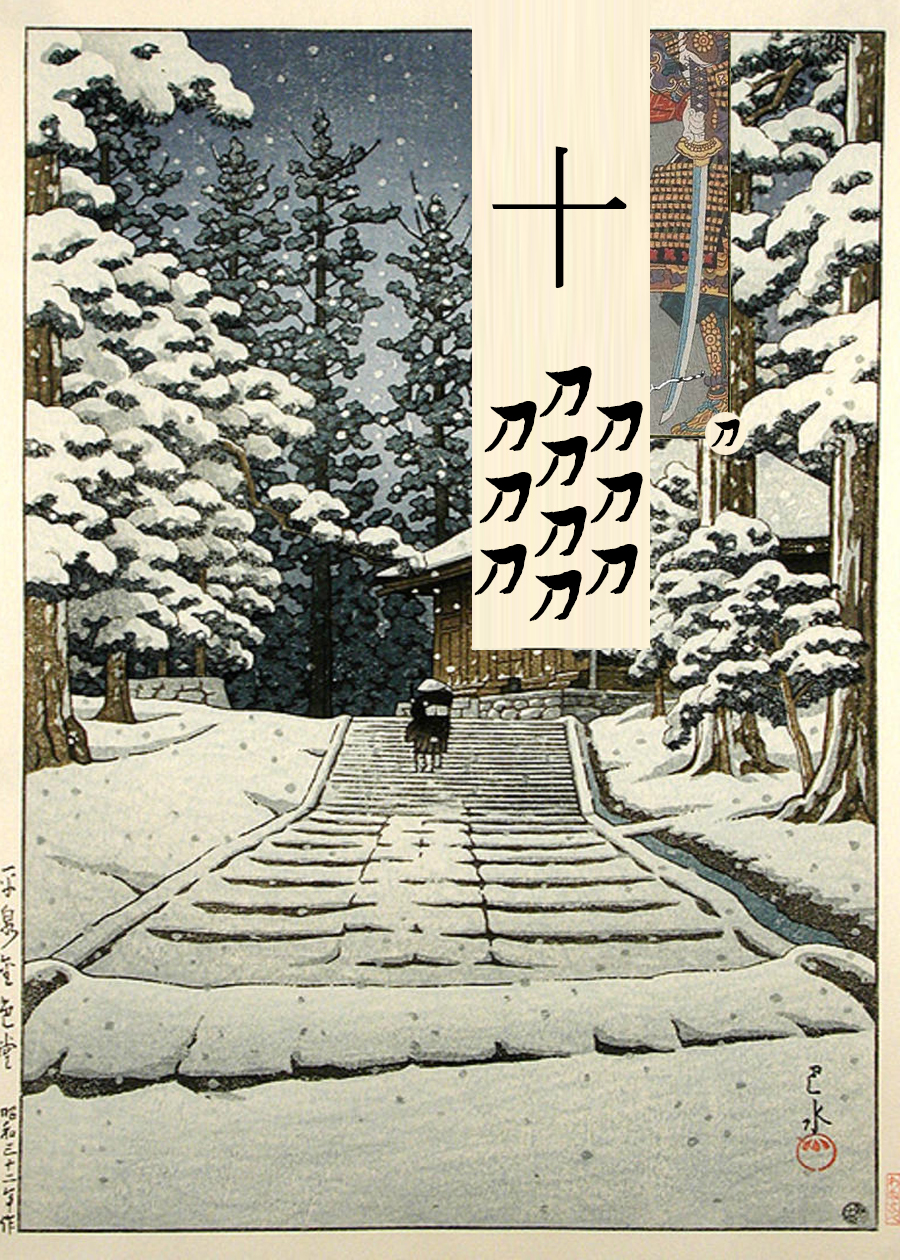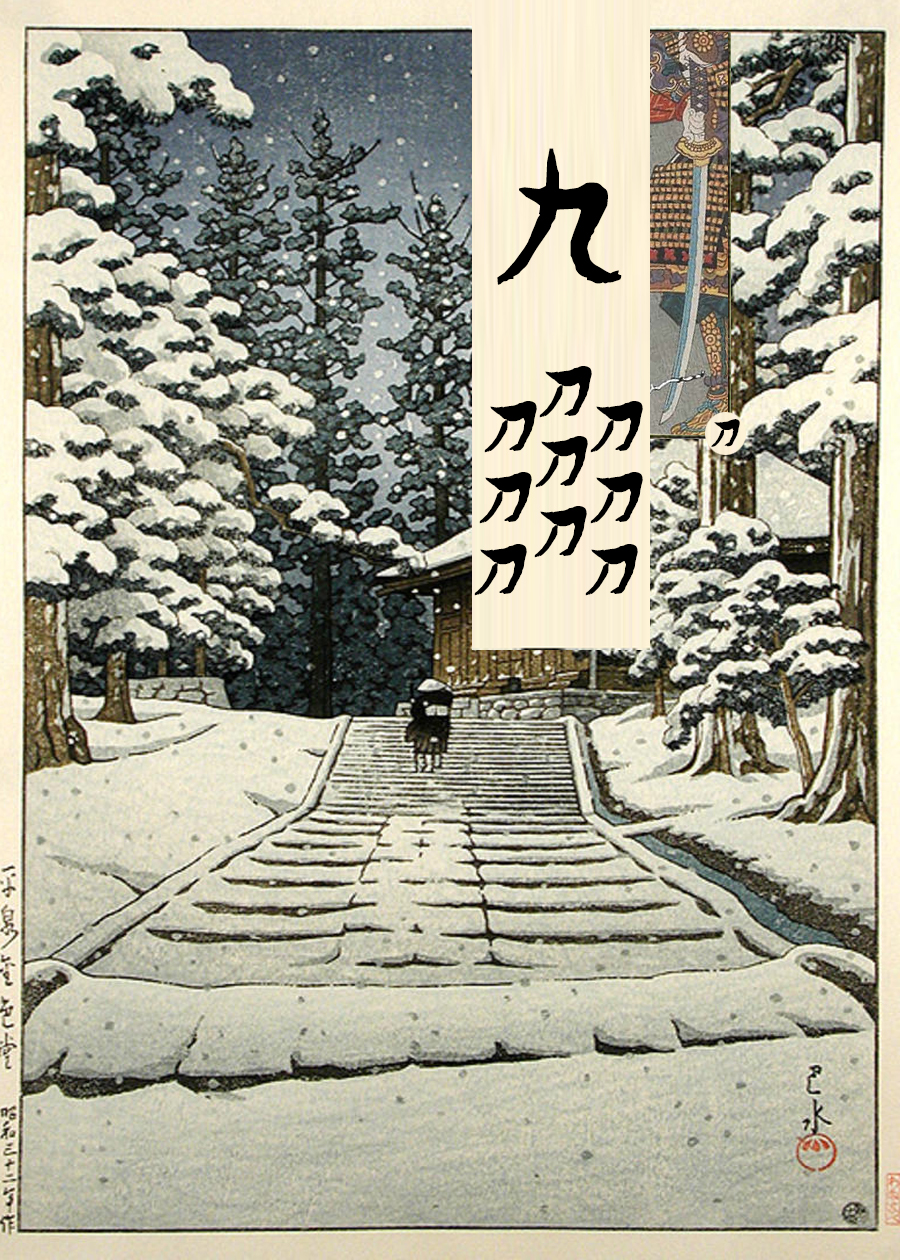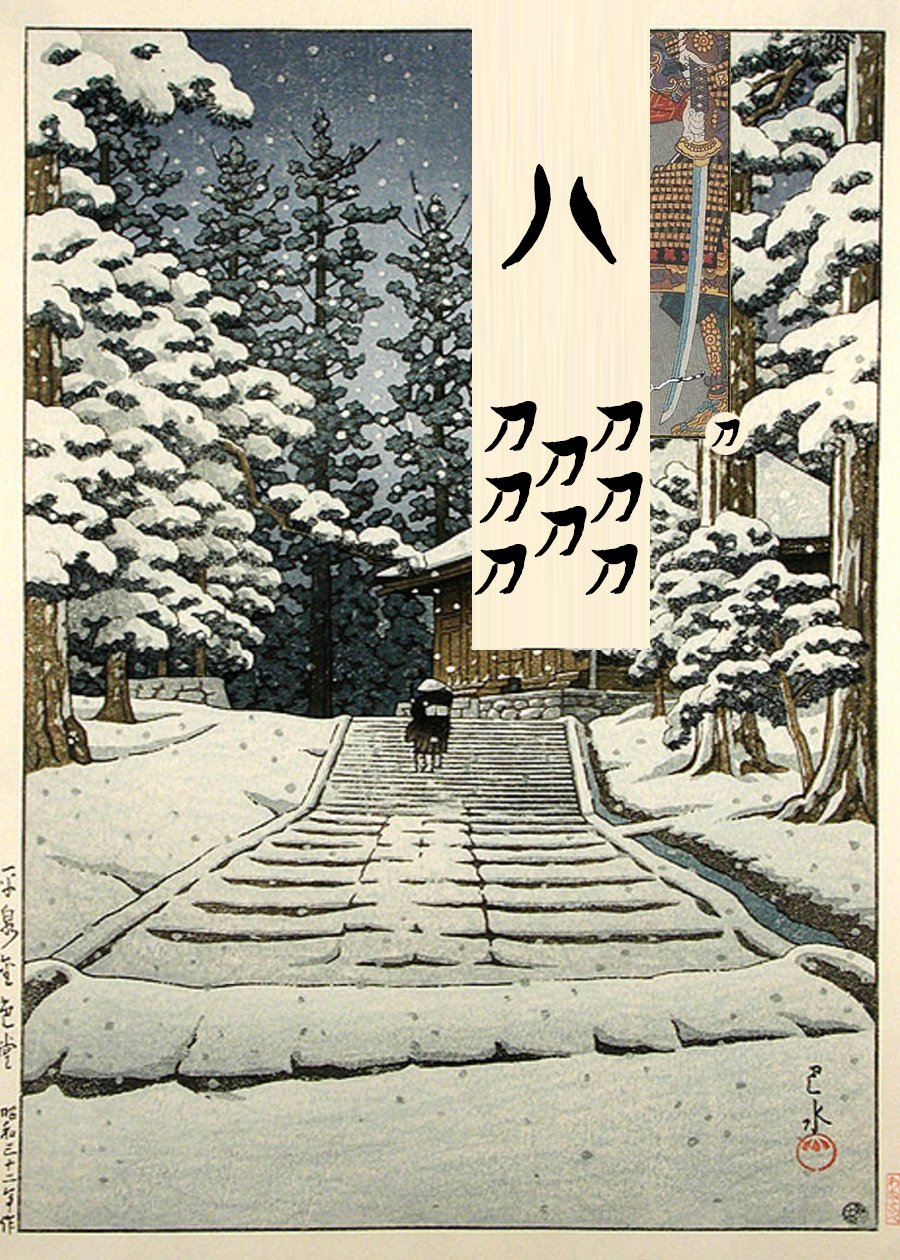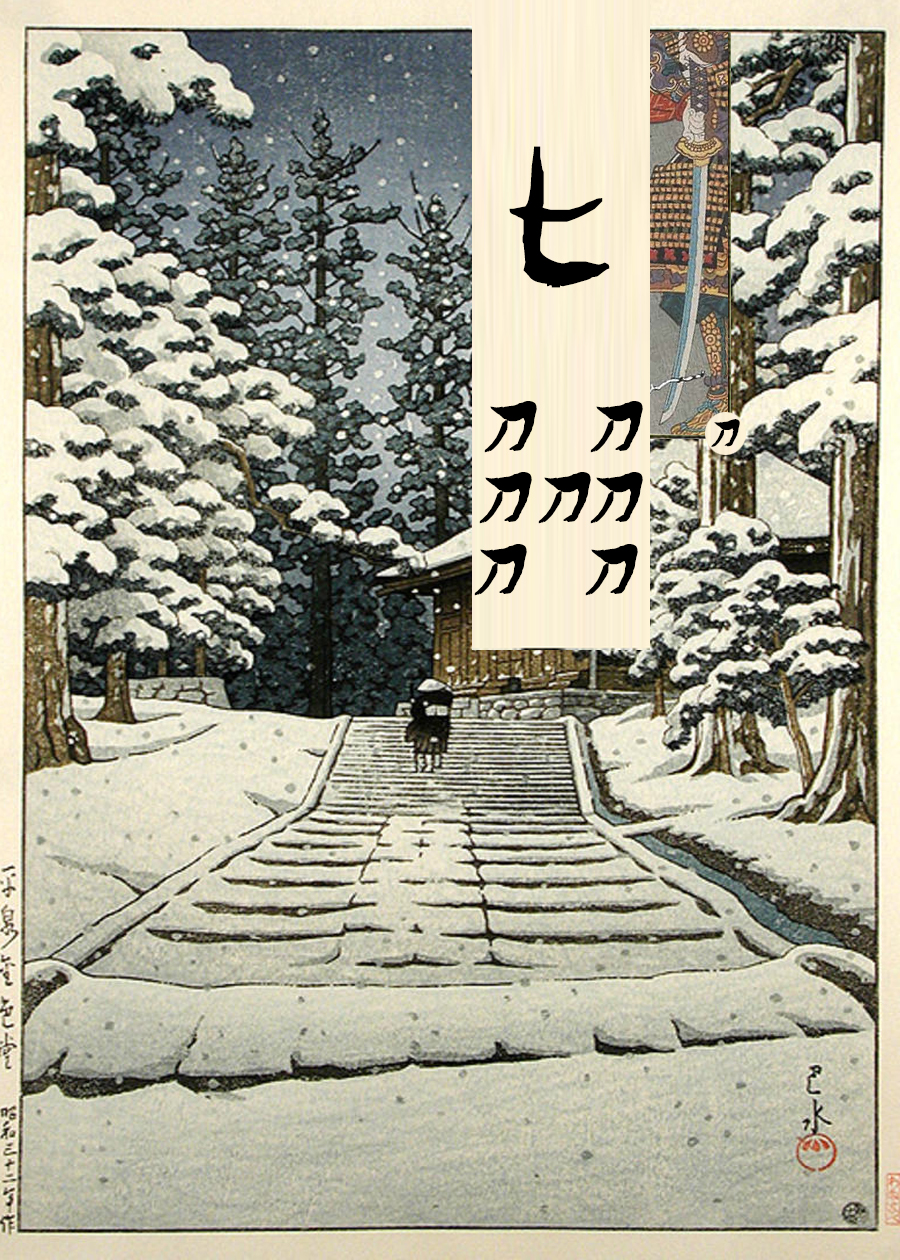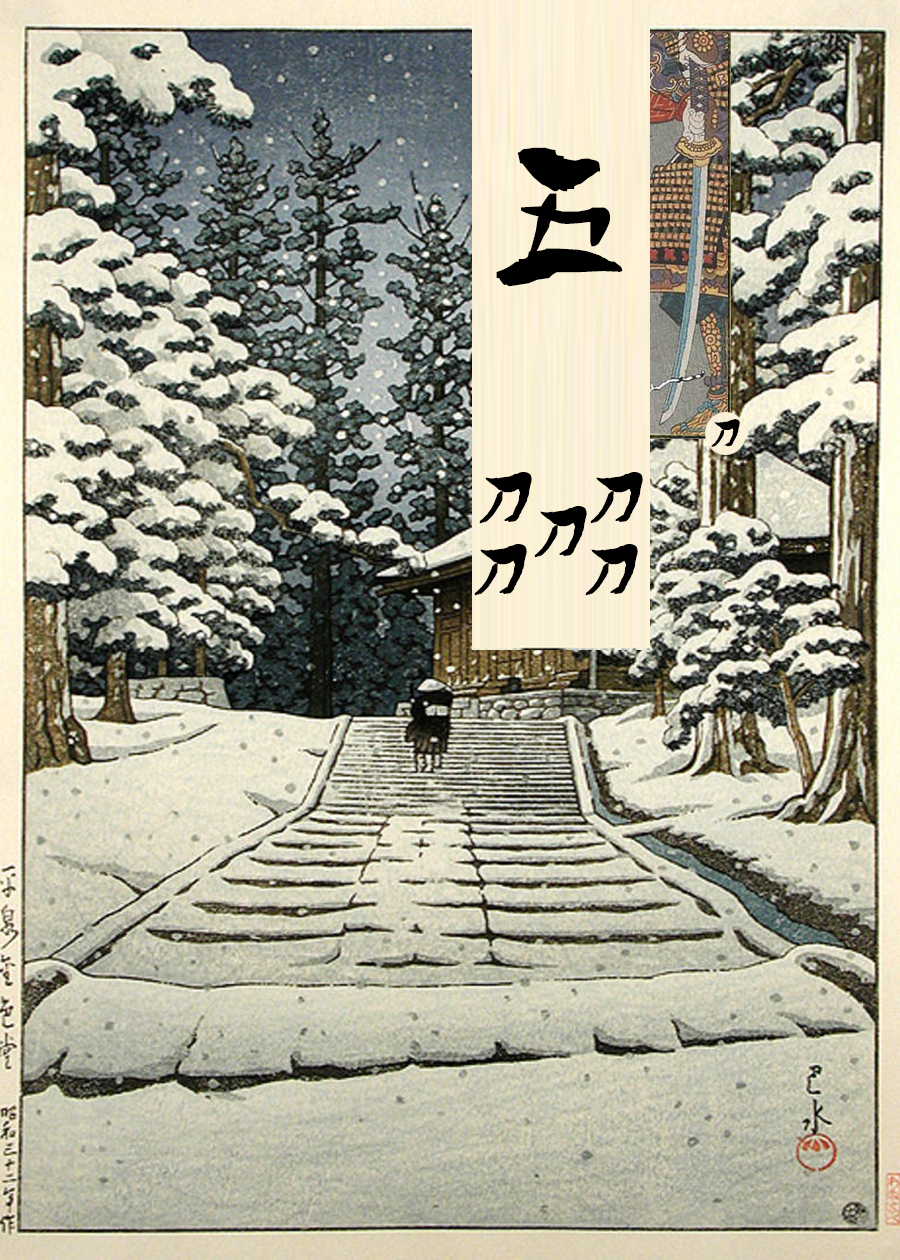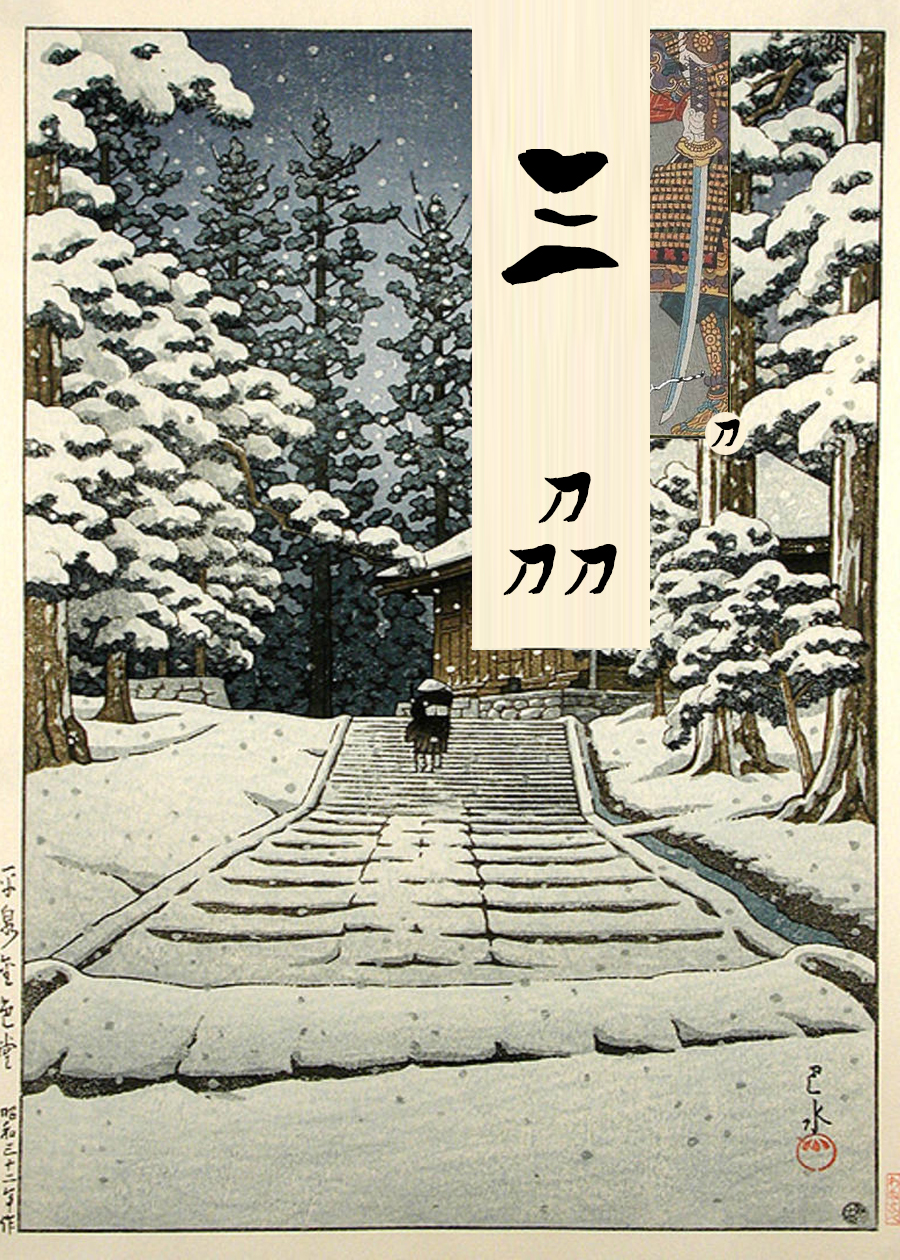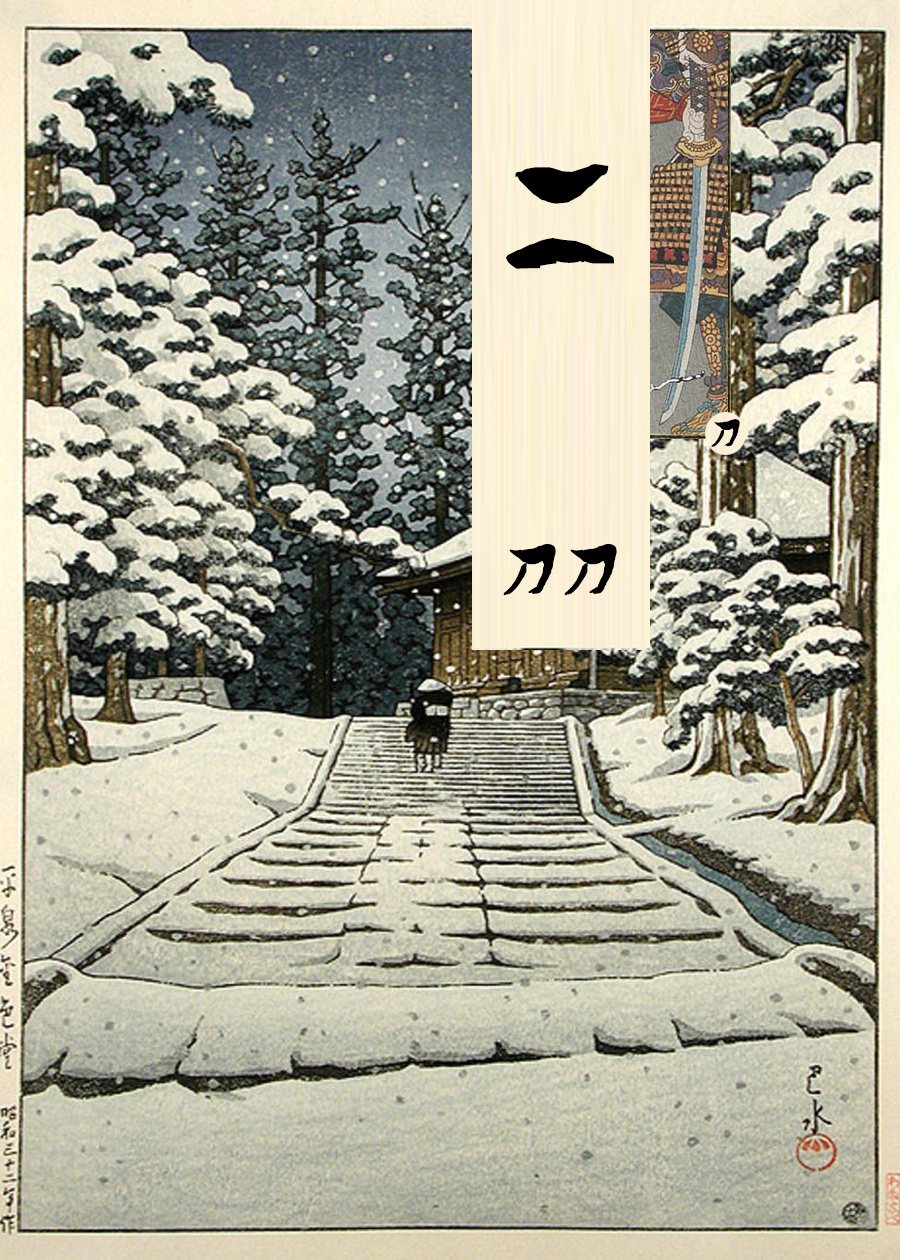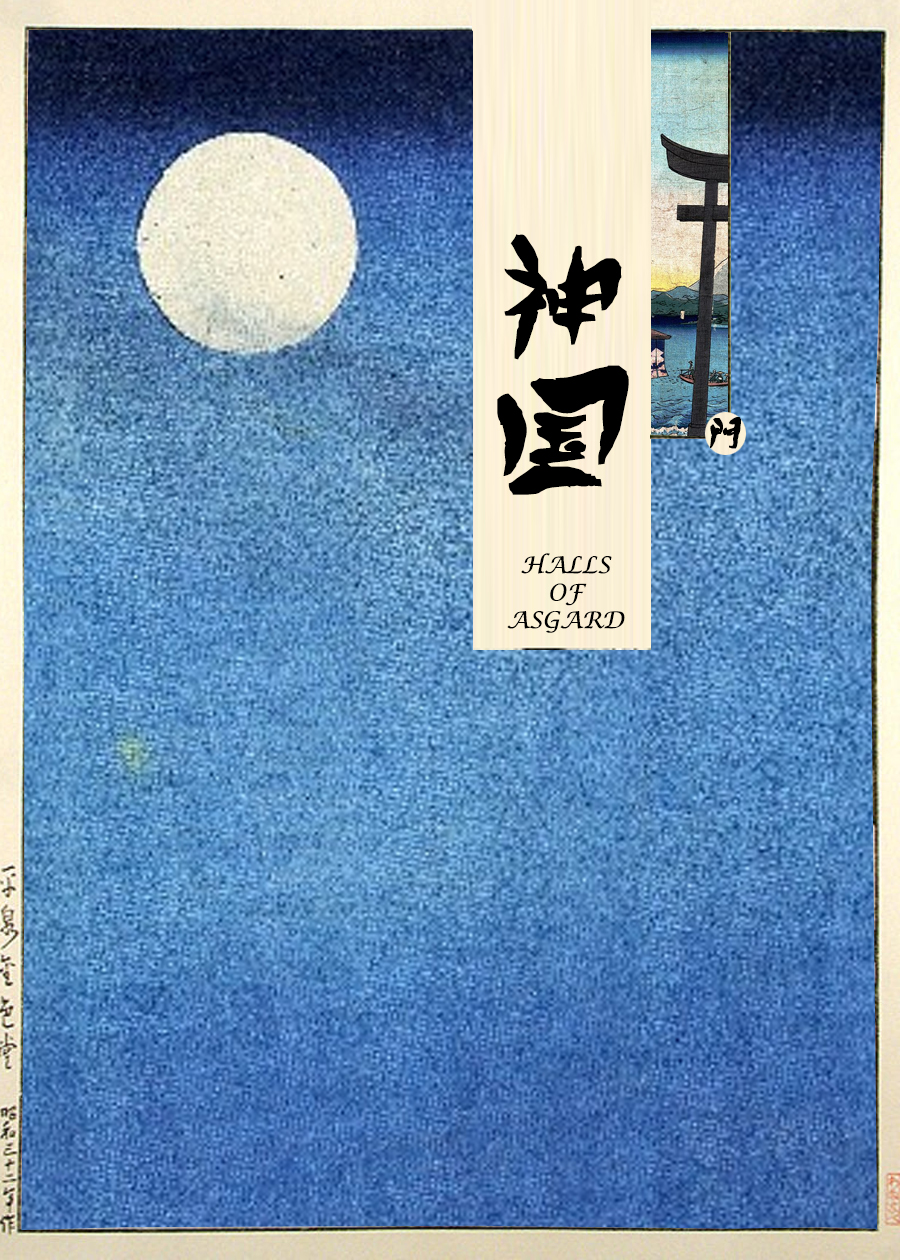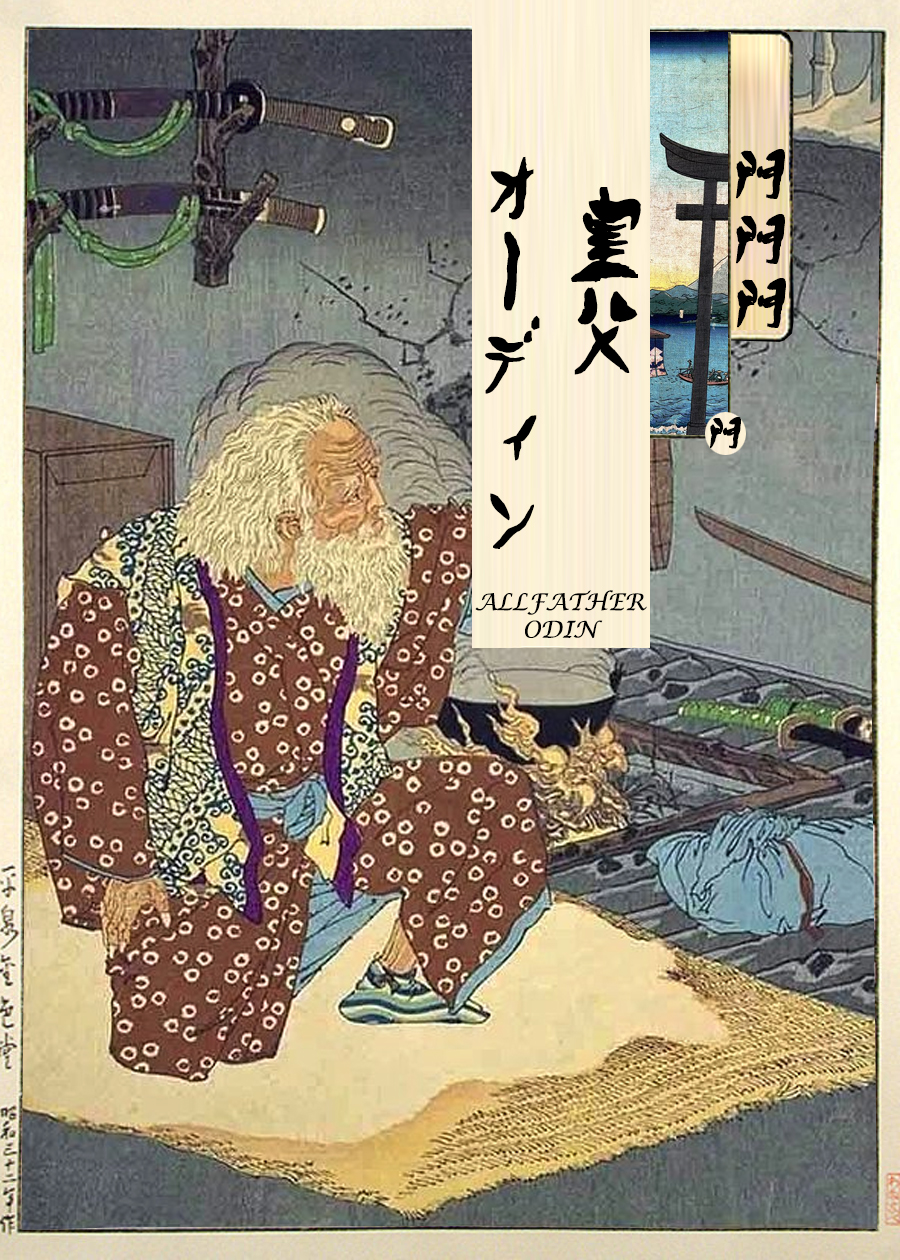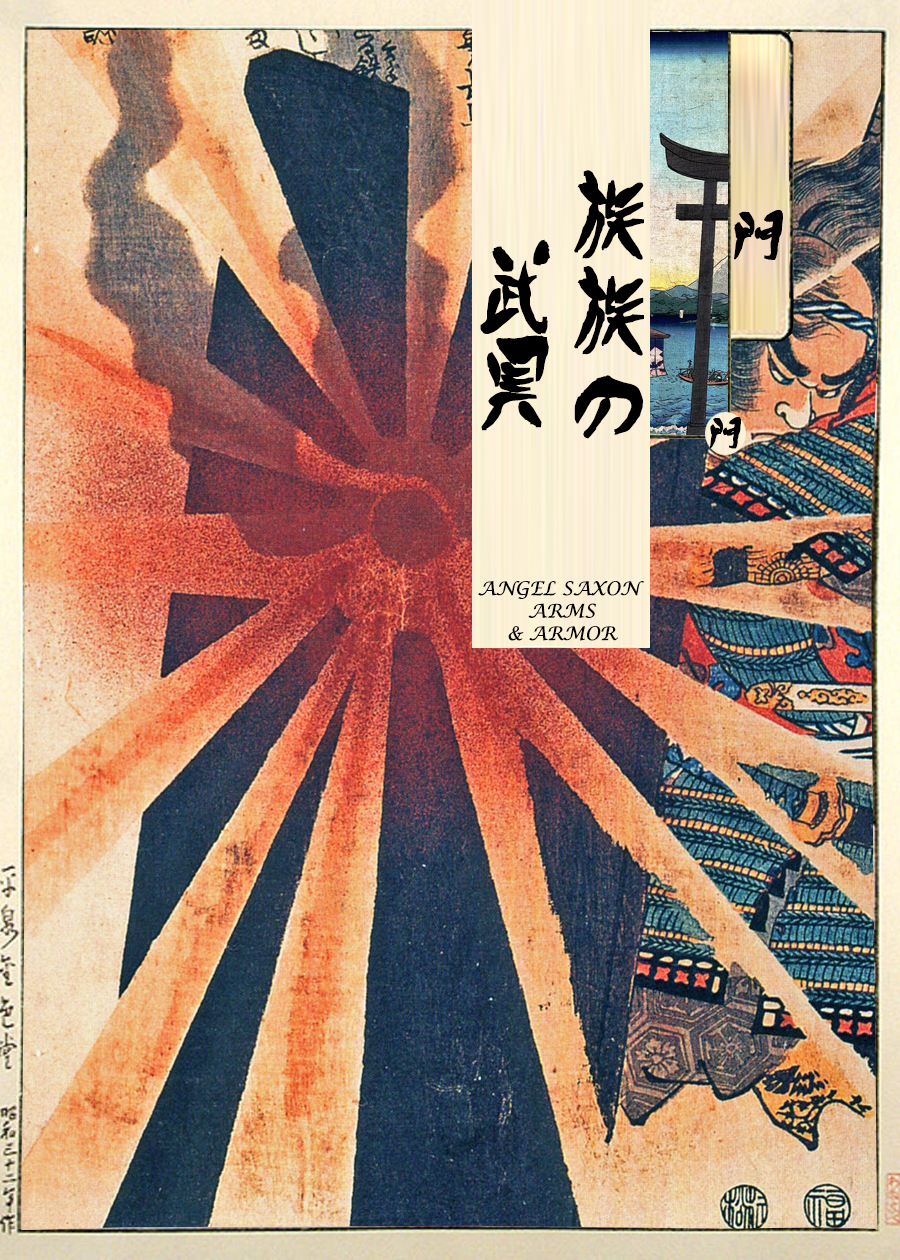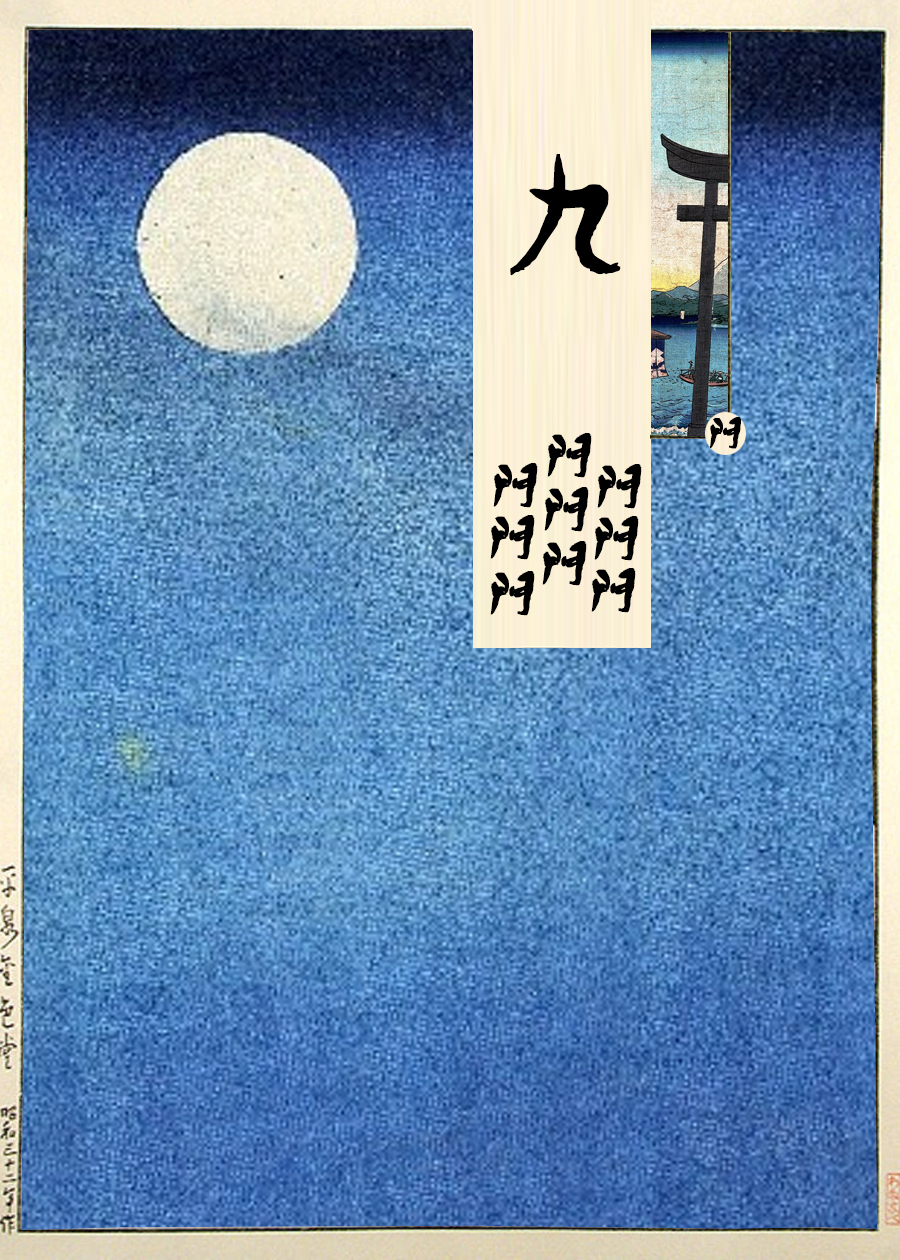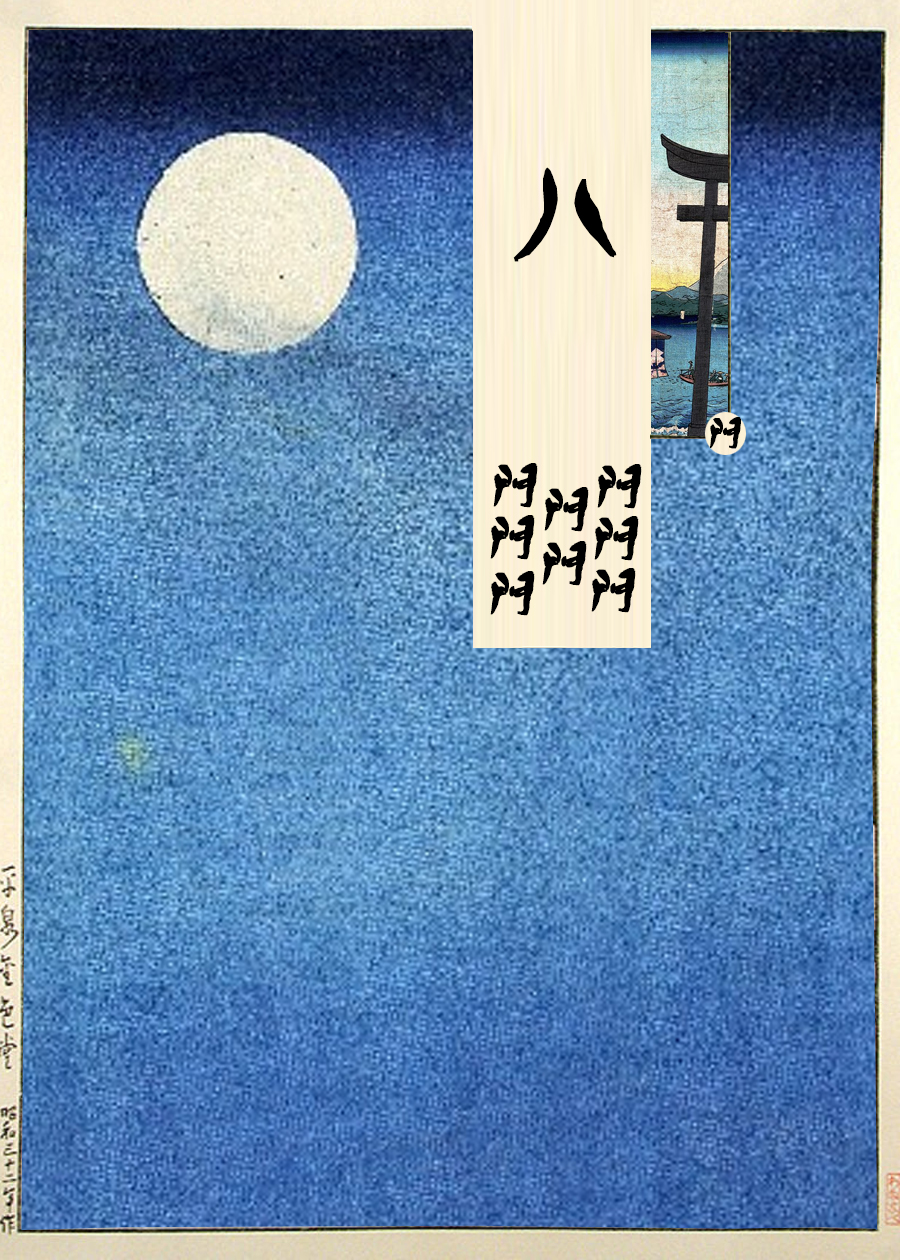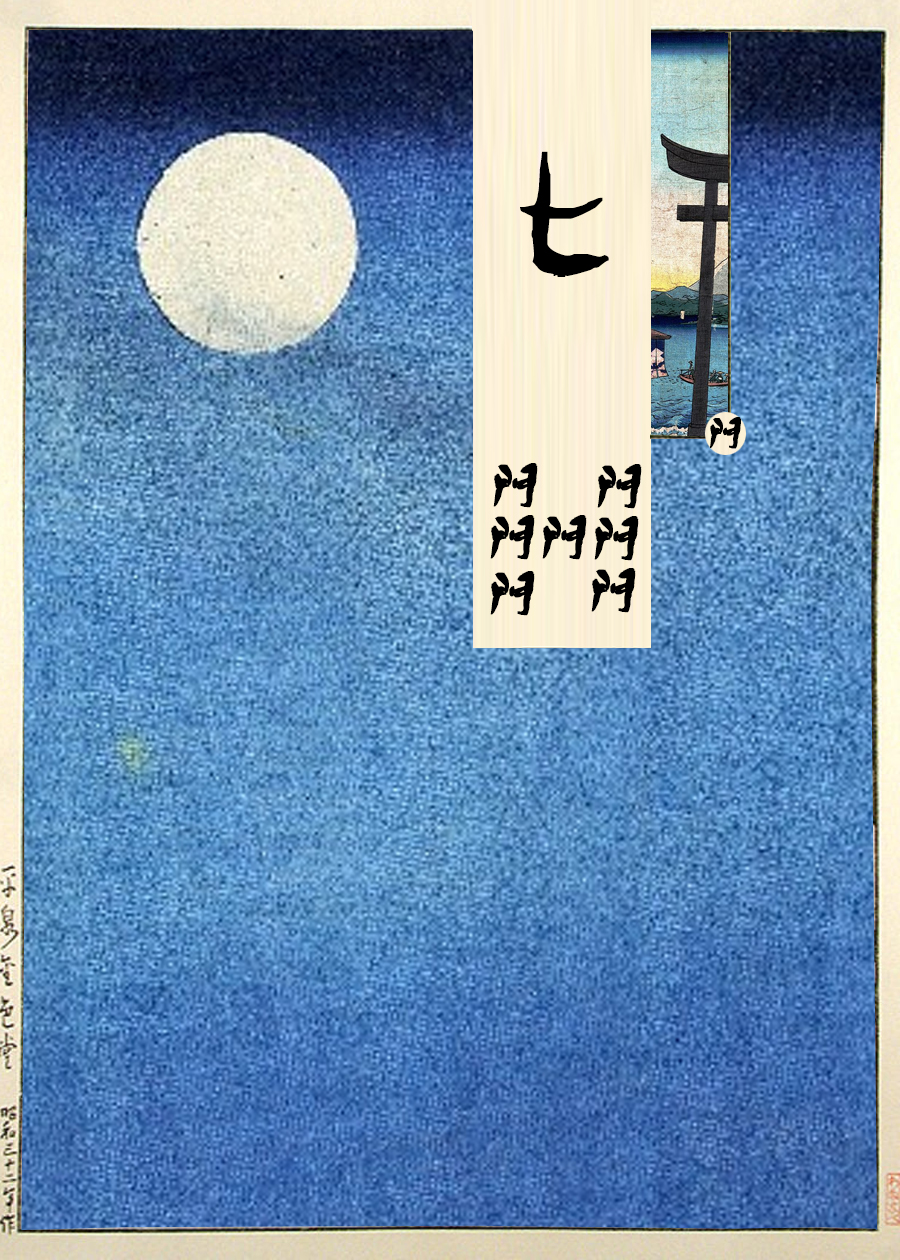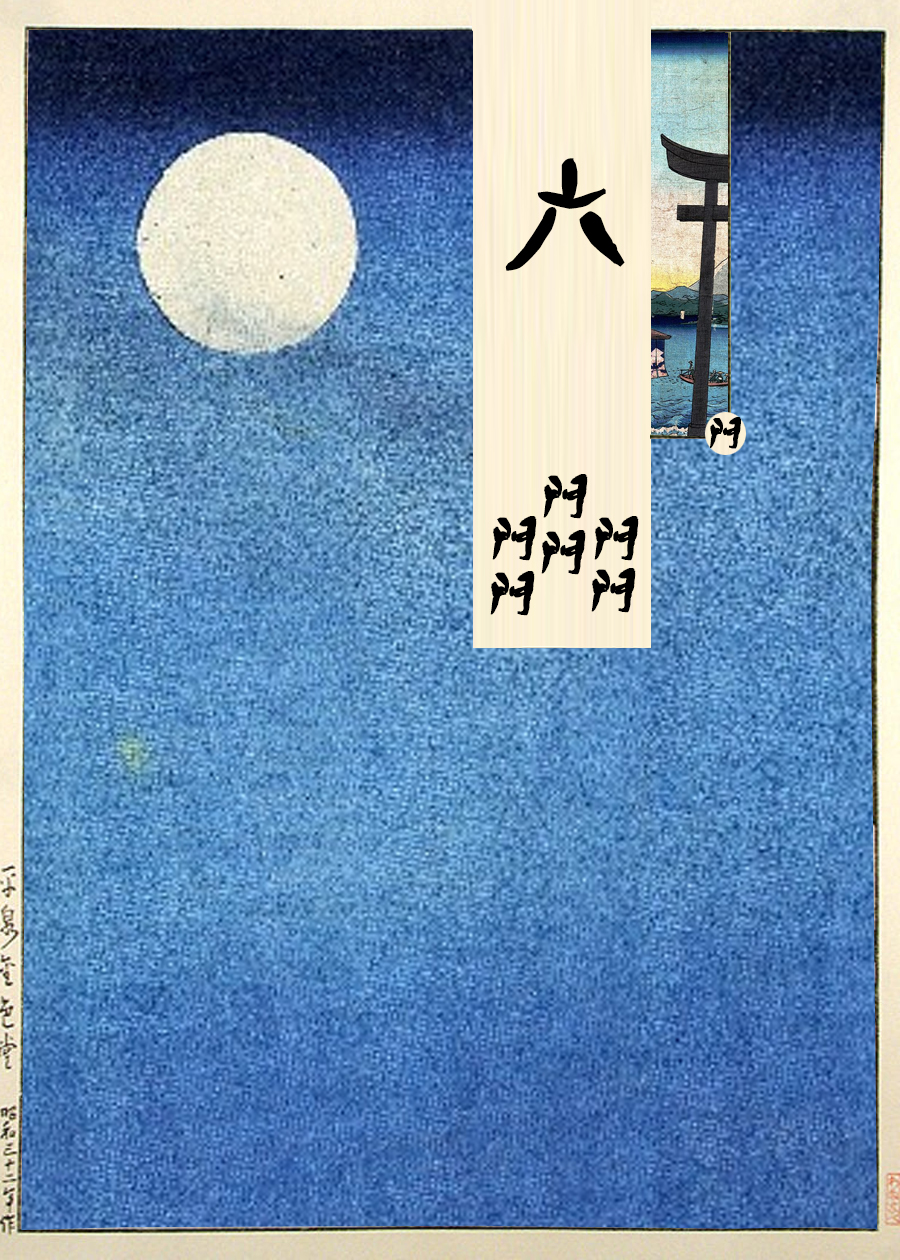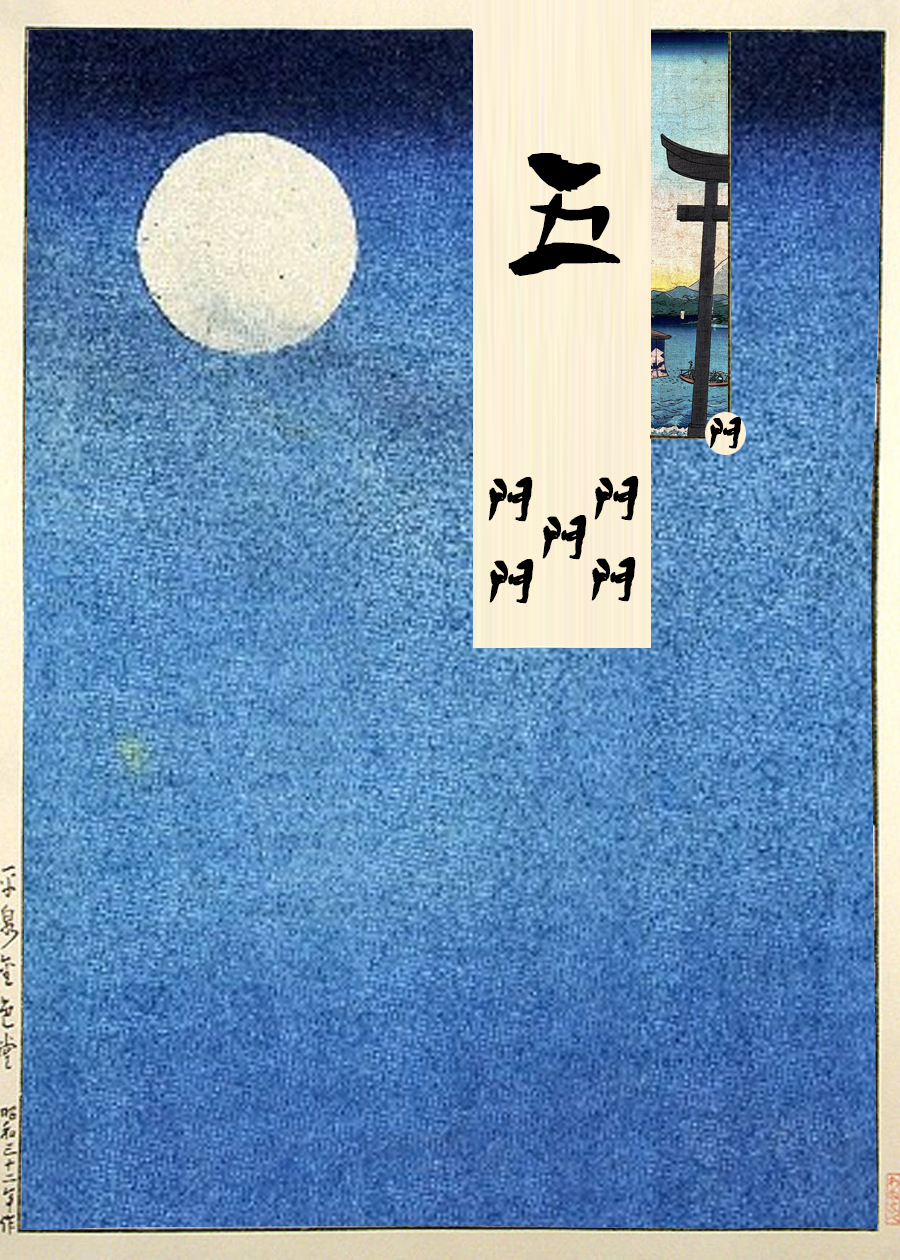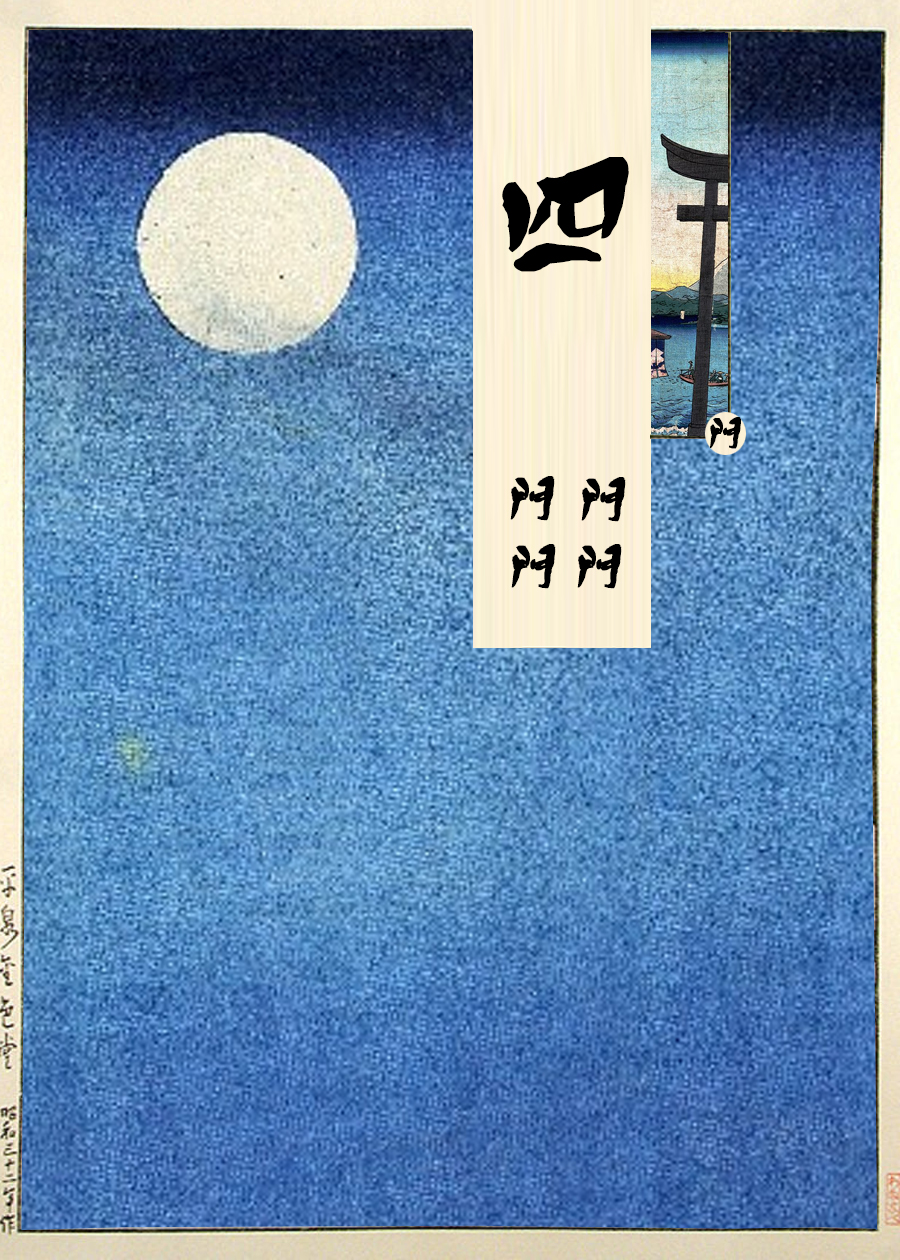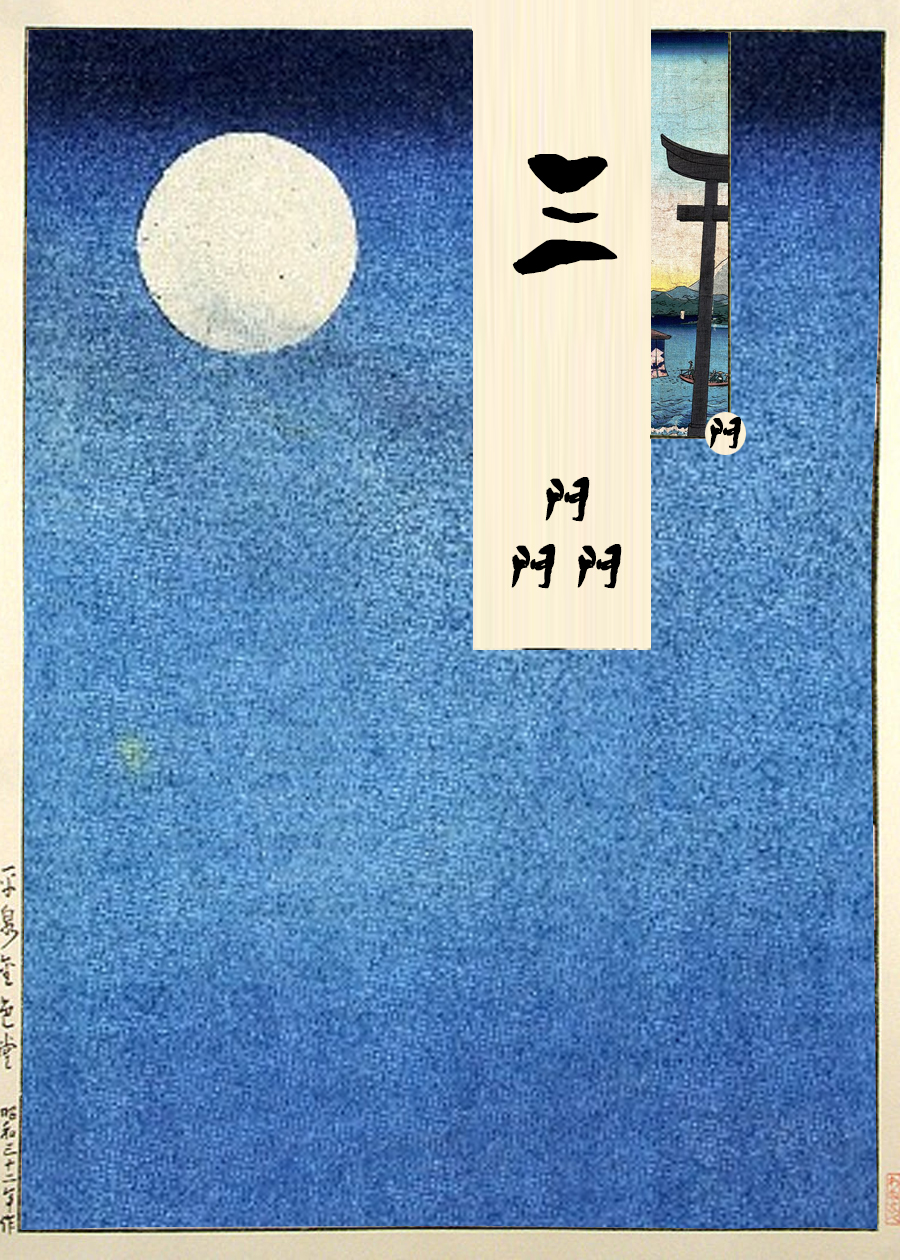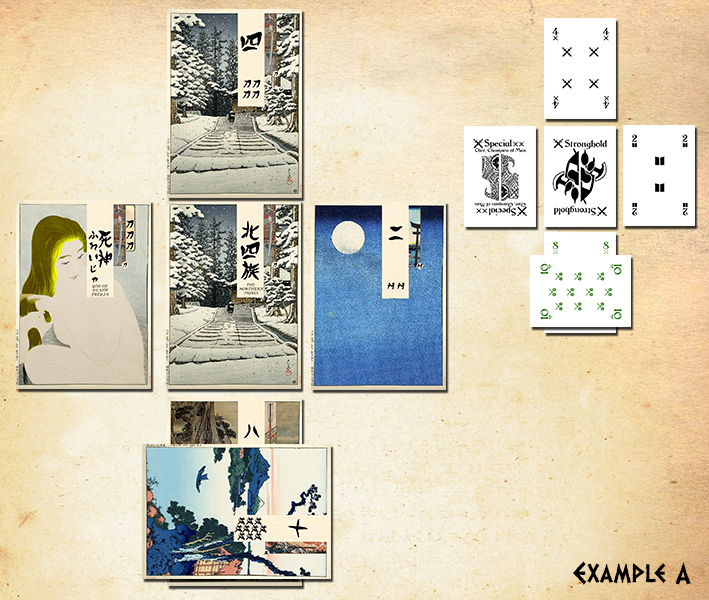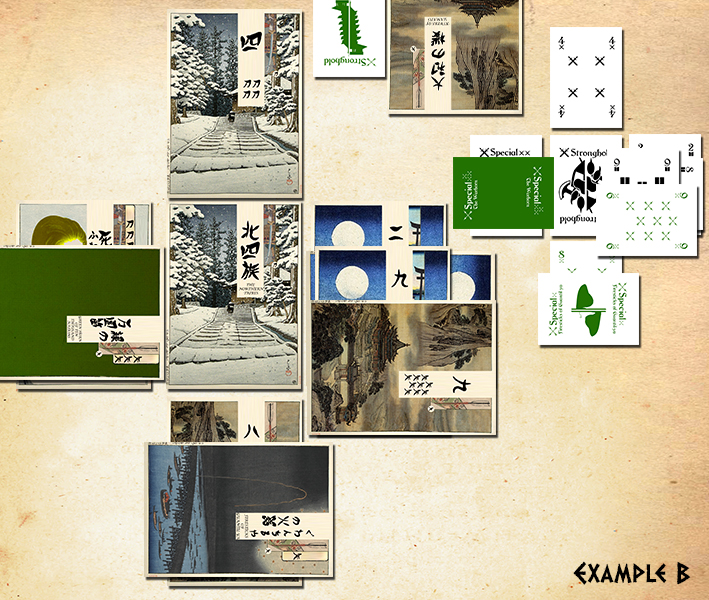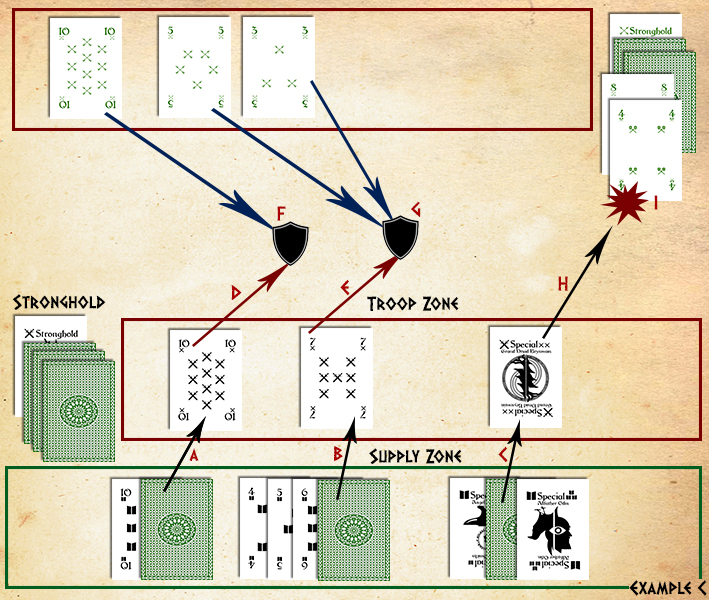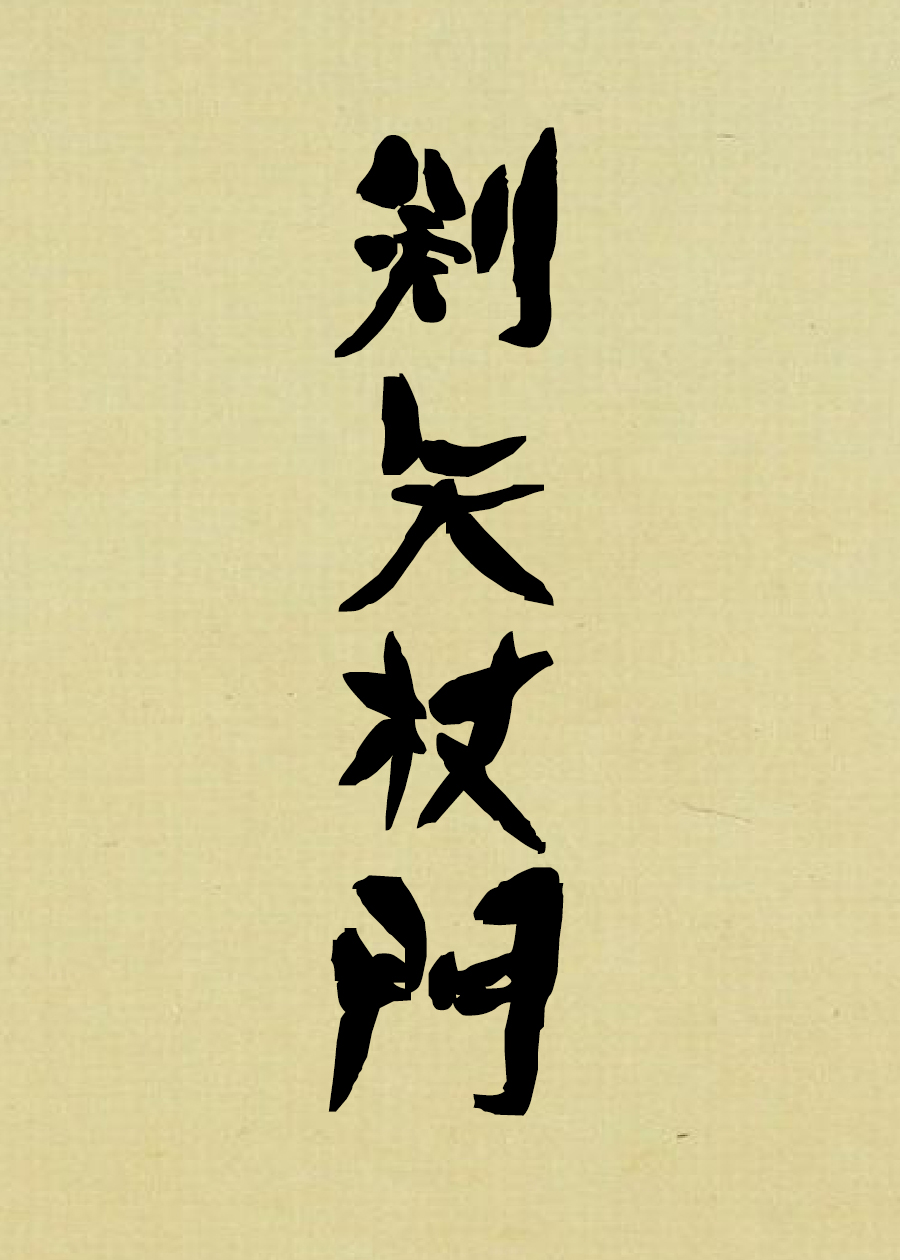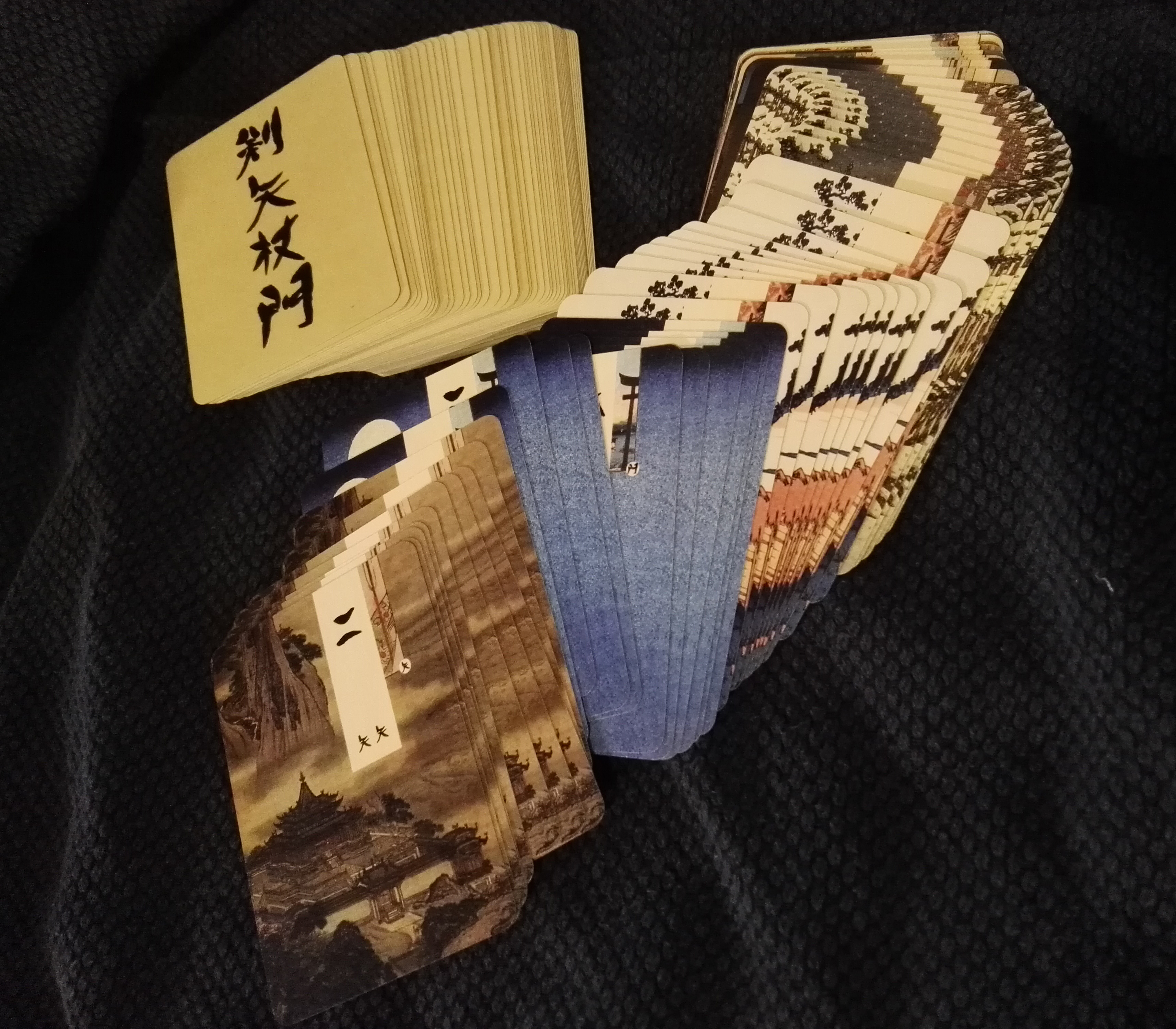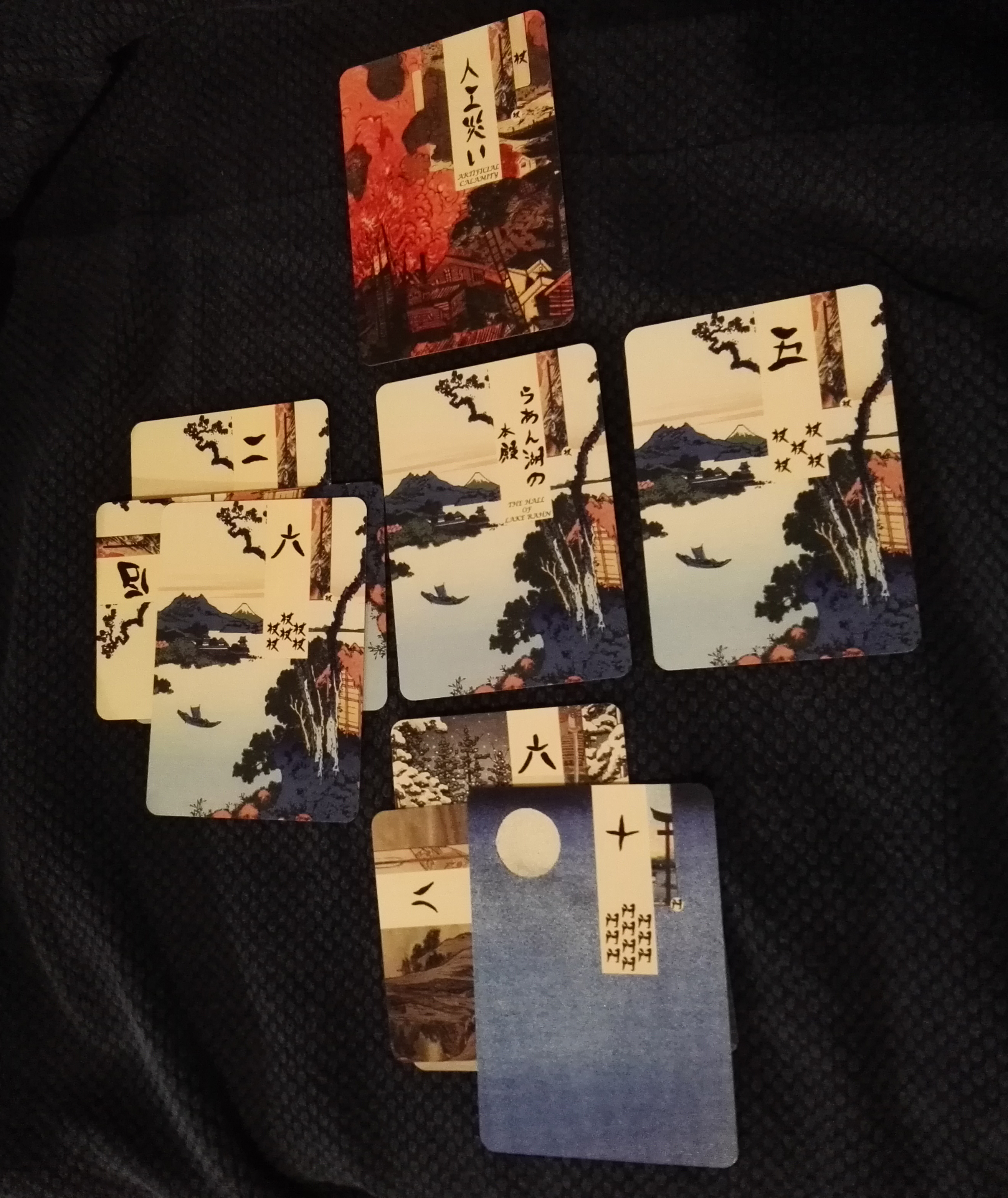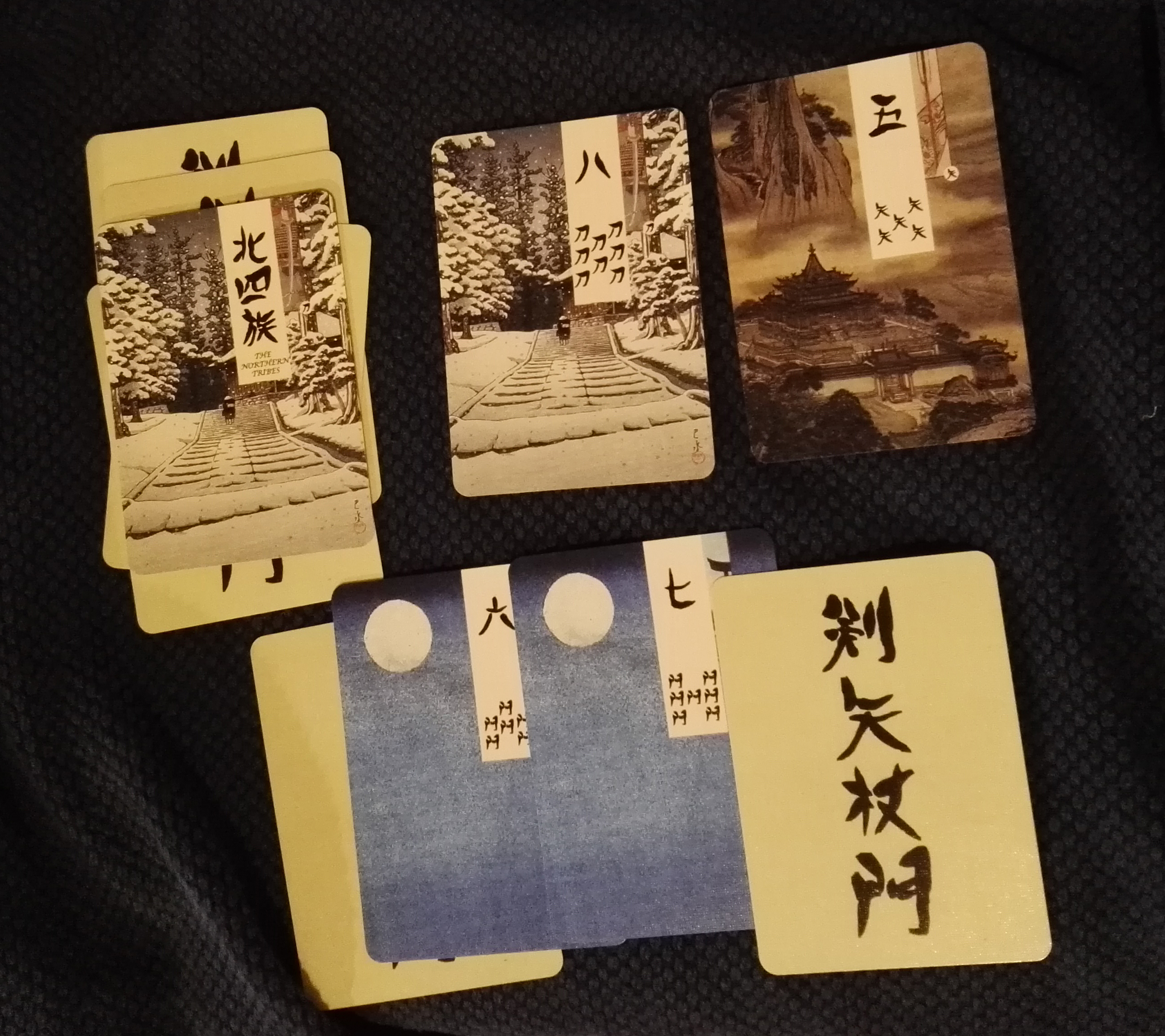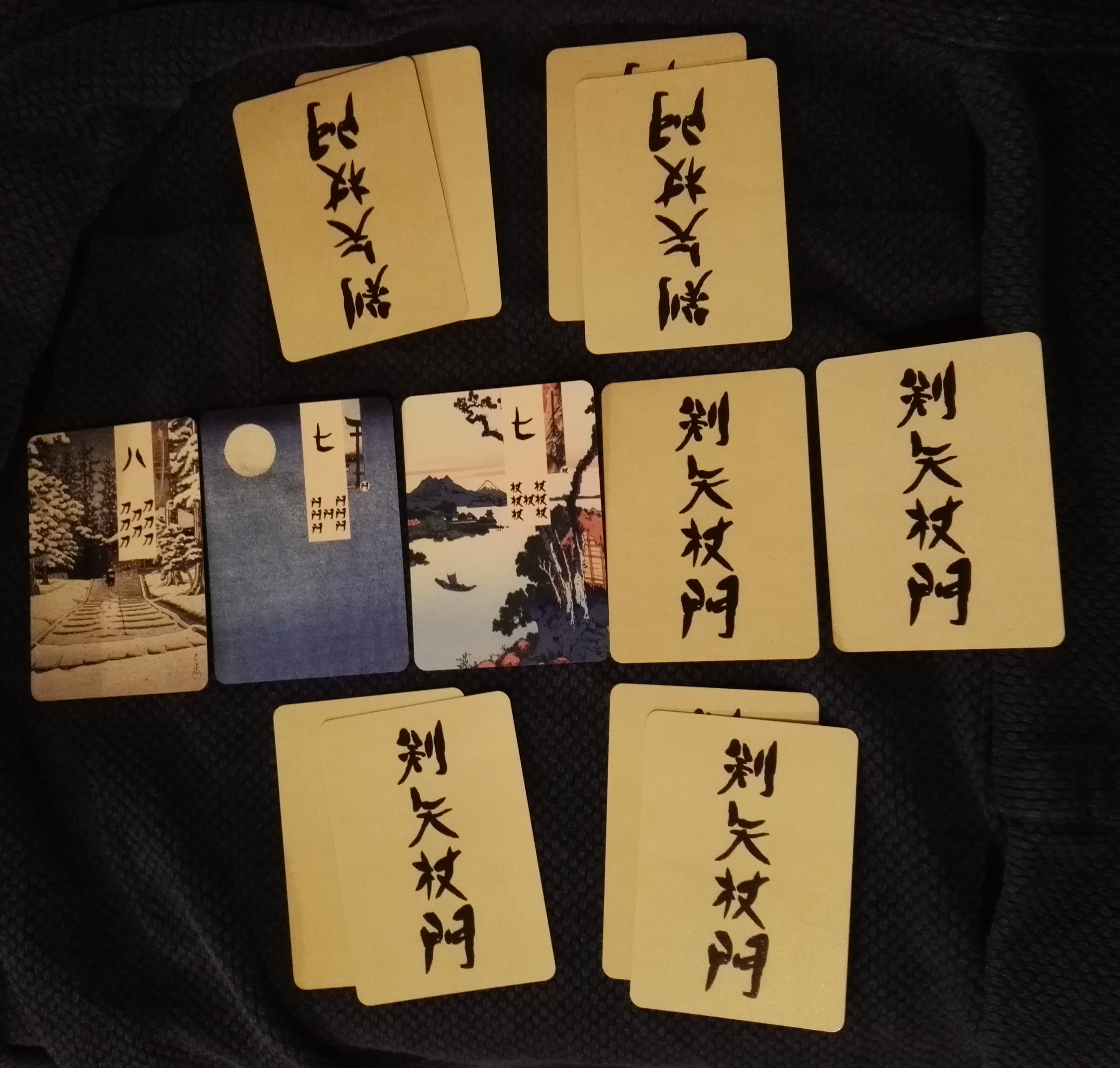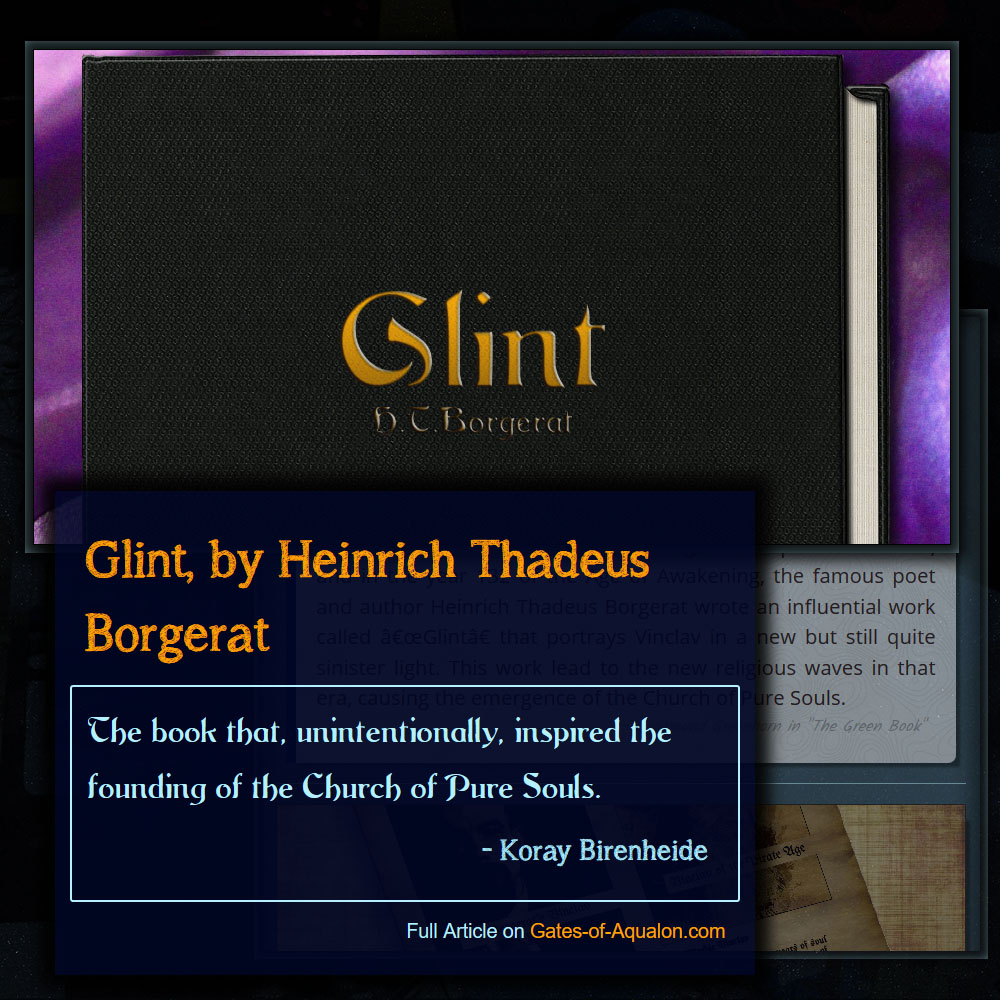The following cards are in a standard, modern deck:
- Staffs
- (Stronghold) Forts of the Middle Lands
- (Special 1) Fire and Ice
- (Special 2) Earth and Wind
- (Special 3) Lightning and Null
- 10 of Staffs
- 9 of Staffs
- 8 of Staffs
- 7 of Staffs
- 6 of Staffs
- 5 of Staffs
- 4 of Staffs
- 3 of Staffs
- 2 of Staffs
- Arrows
- (Stronghold) Towers of Yamato
- (Special 1) Firesticks of Guantil-ya
- (Special 2) Nature's Bulwark
- (Special 3) The War Horn Blows Green
- 10 of Arrows
- 9 of Arrows
- 8 of Arrows
- 7 of Arrows
- 6 of Arrows
- 5 of Arrows
- 4 of Arrows
- 3 of Arrows
- 2 of Arrows
- Swords
- (Stronghold) The Northern Tribes
- (Special 1) Kaltani Warbands
- (Special 2) Grand Druid Brynwain
- (Special 3) Thor, Champion of Man
- 10 of Swords
- 9 of Swords
- 8 of Swords
- 7 of Swords
- 6 of Swords
- 5 of Swords
- 4 of Swords
- 3 of Swords
- 2 of Swords
- Gates
- (Stronghold) Halls of the Angel Saxons
- (Special 1) Angel Smiths
- (Special 2) Valkyries
- (Special 3) Allfather Odin
- 10 of Gates
- 9 of Gates
- 8 of Gates
- 7 of Gates
- 6 of Gates
- 5 of Gates
- 4 of Gates
- 3 of Gates
- 2 of Gates
(Tip: mouseover for image preview.)
Age of Heroes in the Middle Lands
Special Taxation
Special Printings
Age of Heroes on the Corsic Ocean
Age of Heroes in the Yamato Kingdom
(Tip: mouseover for image preview.)
The special cards correlate to their modern counterparts as follows:
- Strongholds
- Forts of the Middle Lands
- Towers of Yamato
- The Northern Tribes
- Halls of the Angel Saxons
- Special Cards
- Artificial Calamity -> Fire and Ice
- Mastery of the Weather -> Earth and Wind
- Defensive Technology of Altonar -> Lightning and Null
- Firesticks of Guantil-ya ~ Firesticks of Guantil-ya
- Natural Bulwark -> Nature's Bulwark
- Green Horn of Ten Thousand Nations -> The War Horn blows Green
- Kaltani Warbands ~ Kaltani Warbands
- Grand Druid Brynwain ~ Grand Druid Brynwain
- God of Death Frey-ja -> Thor, Champion of Man
- Angel Saxon Arms and Armor -> Angel Smiths
- Valkyrie ~ Valkyrie
- Allfather Odin ~ Allfather Odin
Games using one or more Age of Heroes (Kenyajômon) card decks
Age of Heroes (the game)
Two Player Rules
2. Each player places their stronghold card in front of them.
3. All players play five elements and the winner chooses the starting player.
4. Each stronghold card has 4 sides to fortify. Use the card’s edges for this purpose.
5. Shuffle the remaining cards and distribute 15 cards to each player in the first round, 14 in the second, 13 in the third, 12 in the fourth, 11 in the final round.
6. Before the first play, players take turns placing fortifications on the sides of their stronghold one after the other, either until all four sides are covered or until both players no longer want to place fortifications (a player may freely choose have up to four fortifications or as little as one).
7. On their turn, a player must place or discard a hand card. Cards are always placed on enemy cards, except where the rules mention exceptions.
8. When placing a card on an enemy card, you place them in the original direction of your own fortifications when placing them on a side of your stronghold or perpendicular when placing them on a side of your opponent’s stronghold.
9. You can only place cards of higher power on top of other cards. Card power of cards below the top card of a fortification pile does not have to remain consistent.
10. Strongholds have the highest power but can only ever be put on a side of their owners played stronghold.
11. Strongholds can also be placed on top of one’s own played stronghold to replace it if they share the same side. The old stronghold is then discarded.
12. Numbered cards have their number representing their power.
13. Numbered cards and special cards whose type conforms with the stronghold they are placed at are trumps, meaning they can beat cards of other types with even or higher value.
14. The round ends when all cards in all hands have been played or discarded or when a stronghold has been conquered on all four sides.
15. A side is conquered or defended by you as long as the top card placed on it was placed by you.
16. Any side left empty at the beginning of the round cannot have cards placed on it and is always considered conquered by the opposite side.
17. The winner of each individual round is the player with the most combined conquered and defended sides, or the player that first conquers all four sides of the enemy stronghold.
18. The player who first wins three rounds wins the game.
19. A draw counts as a win for both sides.
20. If both players reach three wins at the same time, the game ends in a draw.
21. Special cards have a power of 11 but can have special effects when of the same type as your stronghold.
22. Special cards have the following special effects:
- Kaltani Warbands
Search a fortification pile and replace any number of swords cards with an equal amount of cards from your hand. You may not take the top card of any pile this way. - Grand Druid Brynwain
You may choose a fortification pile placed at your stronghold, shuffle it face down, then distribute the cards equally between all players, discarding left-overs. The side becomes empty (see rule 16). - Thor, Champion Of Man
You may discard the top card of a fortification pile adjacent to the pile onto which you place this card.
- Fire and Ice
Staffs replace the trump type of fortification piles adjacent to the pile onto which you place this card for as long as it remains on top of its pile. - Earth and Wind
Arrows are also considered staffs when you place cards for as long as this card remains on top of its pile. - Lightning and Null
Starting with the player to your left, each other player must give you (3 if two players, 2 if three players, 1 if four players) staff cards from their hands if possible. You have to then give them the same amount of cards from your hand.
- Firesticks of Guantil-ya
For as long as this card lies on top of its pile, arrows you place on adjacent fortification piles count as trumps and have their power increased by 1/2. - Nature’s Bulwark
You may replace the card below this card with a card from your hand. - The War Horn Blows Green
This card is always a trump and can beat strongholds that have been placed as fortifications.
- Angel Smiths
The next gates card you play has a power of 11 regardless of its regular power while you play it. - Valkyries
Search up to two fortification piles for up to one card of an opponent’s stronghold’s type not lying on top, then switch them with an equal amount of cards from your hand. - All-father Odin
When placed on a fortification pile, put all other cards from that pile into your hand, then put an equal amount of cards from your hand under this card.
Example Plays
Example (A) shows a Northern Tribes stronghold (stronghold of swords) surrounded by 4 fortification piles. The top, left, and right pile are still the cards placed at game start. The bottom card, 8 of arrows, has been conquered by the player's opponent using a 10 of staffs. Neither of these cards are a valid trump (which would be swords for as long as cards are placed next to the stronghold of swords), so the 10 of staffs can be used to conquer the pile as its power is greater than the 8 of arrows. In this setup, it is notable that the left fortification pile is lead by a special of swords, God of Death, Frey-ja (Thor, Champion of Man in modern). This is the highest swords card other than the stronghold itself, and since it is placed next to the swords stronghold, it cannot be beaten in power. In the simplified version of the game (see below), the pile would be unbeatable until the stronghold is replaced with the stronghold of gates. The top fortification is lead by the 4 of swords, meaning that only swords and specials can be used to conquer it.
In this example (B), the enemy has the stronghold of arrows, Towers of Yamato (shown on the top edge of the image). Arrows cards played by that enemy are only trumps when placed around his own stronghold; he or she still needs to use swords cards when he wants to conquer piles. The left fortification pile has been conquered with the special of arrows, Green Horn of Ten Thousand Nations (The War Horn Blows Green). Even though the special of swords, God of Death, Frey-ja (Thor, Champion of Man), is unbeatable as a trump, the special ability of Green Horn of Ten Thousand Nations (The War Horn Blows Green) allows it to conquer any pile.
The bottom pile has been conquered with Firesticks of Guantil-ya. The special ability of this card causes arrows on the left and right fortification piles to be 1/2 points more powerful, meaning they can win against cards of equal power. This has happened on the right pile: The original 2 of gates was conquered with the 8 of gates then defended with the 9 of gates and finally conquered with the 9 of arrows, a move only possible because of the Firesticks of Guantil-ya card.
Simplified Rules
Multiplayer Rules
Change the following rules from the 1v1 version:14. The game does not end when a stronghold is captured on all four sides, but the owner of such a stronghold automatically loses that round.
17. For four players, conquered and defended sides of allies are added together. Allies win together and lose together.
21. You may only conquer sides of the stronghold of the player to your left and can likewise only be conquered by the player to your right.
23. For four players, the allied sides (staffs and arrows as well as swords and gates) sit opposite to each other (enemies and allies must alternate).
Commanding Conquerors
In the 17th century GE, a new wave of popularity for Commanding Conquerors rose within the Middle Lands as a circle of business-minded artists, traders, and printers joined together to create a special version of the game called Commanding Conquerors: Heroes, which employs sets of different replacement special cards for the standard Age of Heroes deck, grouped into so called 'editions'. New editions were released regularly, and new special cards introduced new effects and mechanics to the game. To further promote their product, the circle, who called themselves Heroic PentagonTM, organized regular tournaments, working together with the Aquaris Card Gaming League, which focused more on traditional games played with the Age of Heroes deck.
Two Player Rules - Commanding Conquerors: Generals
2. The game is played by two players.
3. Divide the decks into two piles, one containing swords and gates cards, the other arrows and staffs cards.
4. Each player receives one pile of 52 cards, called their draw pile.
5. Each player places before them the stronghold of swords and arrows respectively.
6. The power and supply chain value of numbered cards is equal to their number.
7. The power and supply chain value of special and stronghold cards is 11.
8. Players play five elements to determine the starting player (winner chooses).
9. The starting hand size is 15, and cards are drawn from each player’s own draw pile.
10. Before the first turn, players take turns placing cards from their hand face down on top of their swords or arrows stronghold.
11. The cards on their stronghold pile are their assets, representing cities, resources, and military installations.
12. Each player has three zones in front of them: A supply zone, a troop zone, and their stronghold pile, which is its own zone.
13. Each turn a player first draws a card from his draw pile if he can, flips his face down regenerative supplies and troops face up, and then he may do one of the following actions:
15. All swords and arrows cards are always troop cards.
16. All gates and staffs cards are always supply chain cards.
17. Placing a supply chain card is called “Creating a supply chain.”
18. Placing a troop card is called “Establishing a post.”
19. To establish a post, a value of supplies equal or higher than the troop card’s power is required. One supply card cannot be used to establish more than one post at a time (but other supply cards in its supply chain may be used in the same turn).
20. Supplies have to be expended or “flipped” to be used for the placement of troop cards. This can only be done after they have been used to create a supply chain, meaning they have to be in the supply zone. They may also be expended to "Resupply", in this case take a number of hand cards equal to the supply value, shuffle them into your draw pile, then draw an equal number of new cards. If you do not have enough hand cards, shuffle all of them into your draw pile and draw that many new cards.
21. Supplies can only be placed as pairs or sequences, the first requiring identical numbers or names, the second requiring a sequence of no less than three consecutive cards. Special cards are consecutive to each other based on the number of gates or staffs symbols next to their title (1, 2, and 3), and the special card with only 1 symbol is consecutive to the 10 of gates or staffs respectively.
22. The strongholds of gates and staffs form a special exception to rule 21 and can be used to create supply chains using only themselves. They then count as sequences of 1, and no cards can be attached on top or below them.
23. When supply chains have already been established, instead of establishing a new one, any number of supply cards may be placed on top or below an existing sequence as long as it is legally continued that way.
24. Pairs are regenerative supplies. Only one card of a pair can be flipped face down to establish a post, but at the beginning of a player’s turn, after drawing a card, the flipped card is turned face up again.
25. Sequences are exhaustible supplies. Cards with in a sequence can be flipped face down to establish a post but remain flipped. They are considered spent. All spent supplies can be reshuffled into the draw pile together as a special turn action.
26. Any number of supply cards may be flipped to establish one post.
27. When one or more posts attack a player, the attack is directed at that player’s stronghold pile. At the end of the turn, surviving attackers are flipped face down until the next turn.
28. The defending player may intercept an attack with one or more posts. One post can only intercept up to one post at a time, but two or more posts may intercept one post together.
29. If two sets of troops with equal power fight, they are both shuffled into their owner’s draw pile.
30. If two sets of troops with different power fight, the weaker troop is shuffled into its owner’s draw pile. Individual excess damage may lead to troops from different sides to be shuffled into their owner’s pile. The largest posts are destroyed first. Example:
32. If that power exceeds the combined power and supply chain value of all remaining cards except the bottom most stronghold card, the attacking player wins.
33. If all cards but the bottom most stronghold card are removed from the stronghold pile, the game continues until at least 1 more power worth of damage is inflicted on that player’s stronghold pile.
Example C shows how a turn in Commanding Conquerors could look like: The bottom player controls the stronghold of swords, meaning he uses swords cards to establish posts, and gates cards to create supply chains. His enemy, the top player, controls the stronghold of arrows, meaning he uses arrows to establish posts and staffs to create supply chains.
The supply zone of the bottom player contains a pair of 10s, a sequence of 4, 5, 6, and 7 as well as a sequence of three consecutive gates special cards (each valued at 11). Because supply chains consisting of pairs are regenerative, being reset each round, the bottom player must have used his 10 pair to establish his 10 of swords post (shown by arrow A). The two sequences each have an expended card. These remain flipped and cannot be used again. The supply 7 of gates was expended to establish the 7 of swords post (as shown by arrow B), and the Valkyrie Special card in the specials sequence was expended to establish the specials of swords post (as shown by arrow C). Both of these posts must have been established in previous turns, since only one post can be established per turn.
The bottom player is now attacking the enemy's assets (the cards placed face down on top of his stronghold shown by the arrows D, E, and H). The 10 of swords is intercepted by the enemy's 10 of arrows, they have equal power and are therefore each shuffled into their owner's draw pile. The 7 of swords is intercepted by the 5 and 3 of arrows. Because the total defense is higher, the 7 of swords is shuffled back into its owner's draw pile, but as the 7 of swords is powerful enough to defeat one of the defending posts, the largest possible defending post is also shuffled into its owner's draw pile (in this case the 5 of arrows). The final attacker, the special of swords (Grand Druid Brynwain) remains unintercepted. The defending player must now shuffle cards from his stronghold pile into his draw pile whose power or supply chain value totals or exeeds the power of the attacker (11). He chooses the 8 of arrows and the 4 of staffs, coming to a total of 12, and shuffels them into his draw pile. After this, the bottom player's turn ends.
4+ Players - Commanding Conquerors: Captains
1. Two decks of Age of Heroes cards are required to play Commanding Conquerors: Captains per two players.
2. The game is played by an even number players divided into two teams.
3. Divide the decks into two piles, one containing swords and gates cards, the other arrows and staffs cards. Each player should have a 52 card deck identical to the 52 card decks of his allies, created from one of the resulting piles.
5. Each side places before them the stronghold of swords and arrows respectively.
12. Each side has three zones in front of them: A supply zone, a troop zone and the stronghold pile, which is its own zone.
27. When one or more posts attack a side, the attack is directed at that side’s stronghold pile. At the end of the turn, surviving attackers are flipped face down until the next turn.
28. The defending side may intercept an attack with one or more posts. One post can only intercept up to one post at a time, but two or more posts may intercept one post together.
Midas Creek Poker
2. Players can bet on a round during their turn.
3. The right neighbour of the dealer becomes the new dealer each round.
4. The dealer deals two face down cards to each player. This is their hand for the round.
5. The player to the right of the dealer has to put forth a small, previously set, so-called 'blind' amount of money.
6. The second player to the right of the dealer places the so-called 'big blind', which is twice the amount of the 'blind'.
7. After the cards have been dealt and blinds placed, the player to the right of the dealer places his bet or passes and each player to the right in turn repeats this process until everyone passes or folds.
8. If a player folds, he relinquishes his hand and any chance of winning the pot (the money bet by every player for the round).
9. To pass, a player must have bet no less than the player before him during this round.
10. If a player cannot cover the previous bet, he may go 'all in', betting whatever he has remaining. When he wins this round, he cannot win more than he has bet times the number of players; the remaining pot goes to the second best hand (or possibly further down, if multiple 'all in's have occured).
11. When everyone has passed for the first time, the dealer places three cards in the middle, which is called 'the grove'. Now betting may recommence. After that, a fourth card is placed, the process repeated, then a fith, and the process repeats a final time.
12. Once all five cards have been placed in the grove, the players secretly check which combination of five cards from among the five grove cards and their own two cards affords them the most points (unless they have folded before).
13. When the last pass has been made and more than one player remains, the remaining players reveal their hand, and the higher hand wins the pot. Otherwise, the remaining player receives the pot and does not have to reveal his hand.
14. Card values are calculated as such (from highest value to lowest):
| Rank | Name | Example Hand | Example Hand | Example Hand | Example Hand | Example Hand |
| 1 | Elite Army | |||||
| 2 | Four of a Kind | |||||
| 3 | Castle and Guard | |||||
| 4 | Full Army | |||||
| 5 | Battle Formation | |||||
| 6 | Three of a Kind | |||||
| 7 | Two Pair | |||||
| 8 | One Pair | |||||
| 9 | High Card |
16. Strongholds can function either as value 4 special cards or value 1 regular cards for Elite Armies and Battle Formations.
17. For same valued hands, the symbols are valued as such: staffs > arrows > gates > swords.

